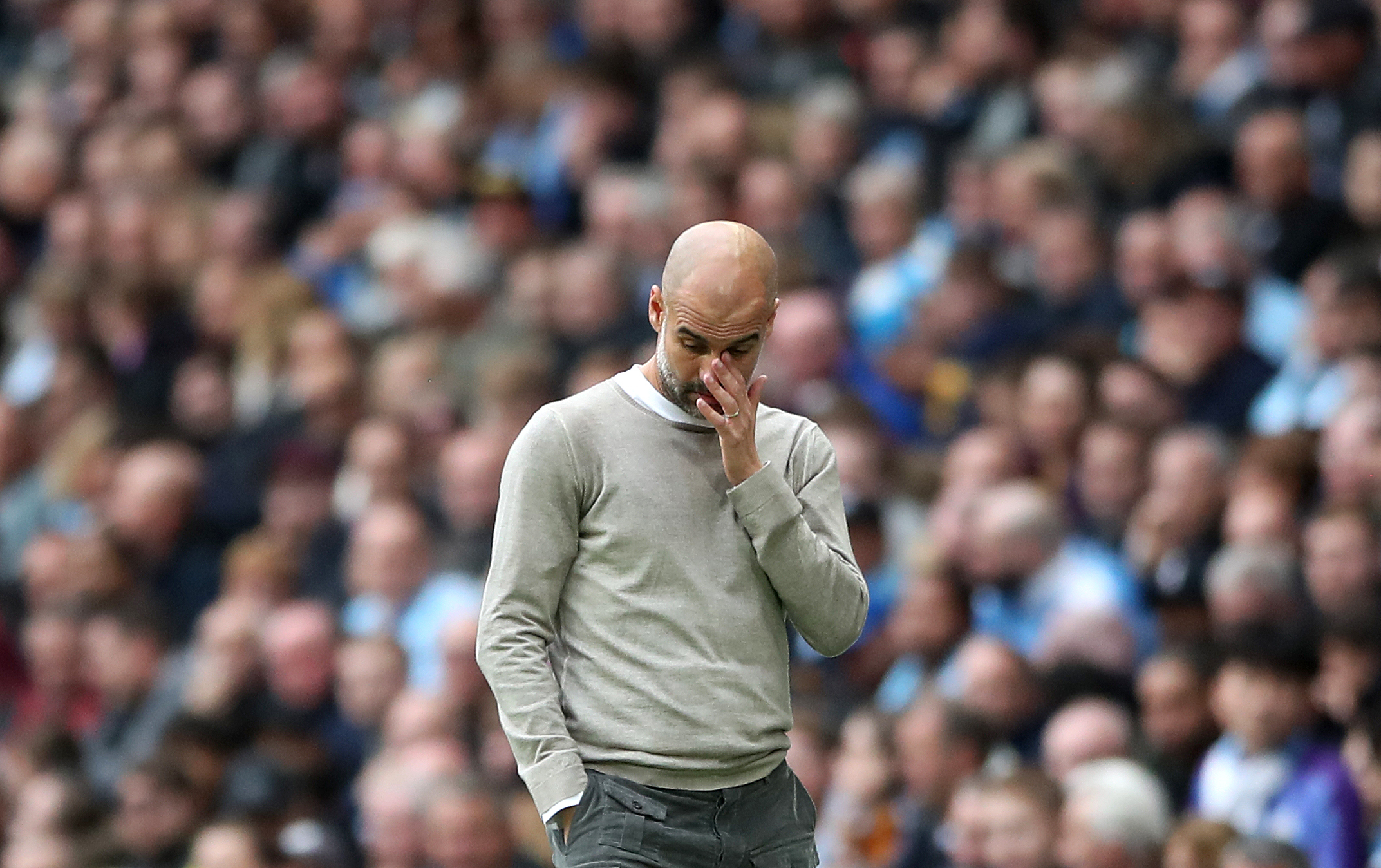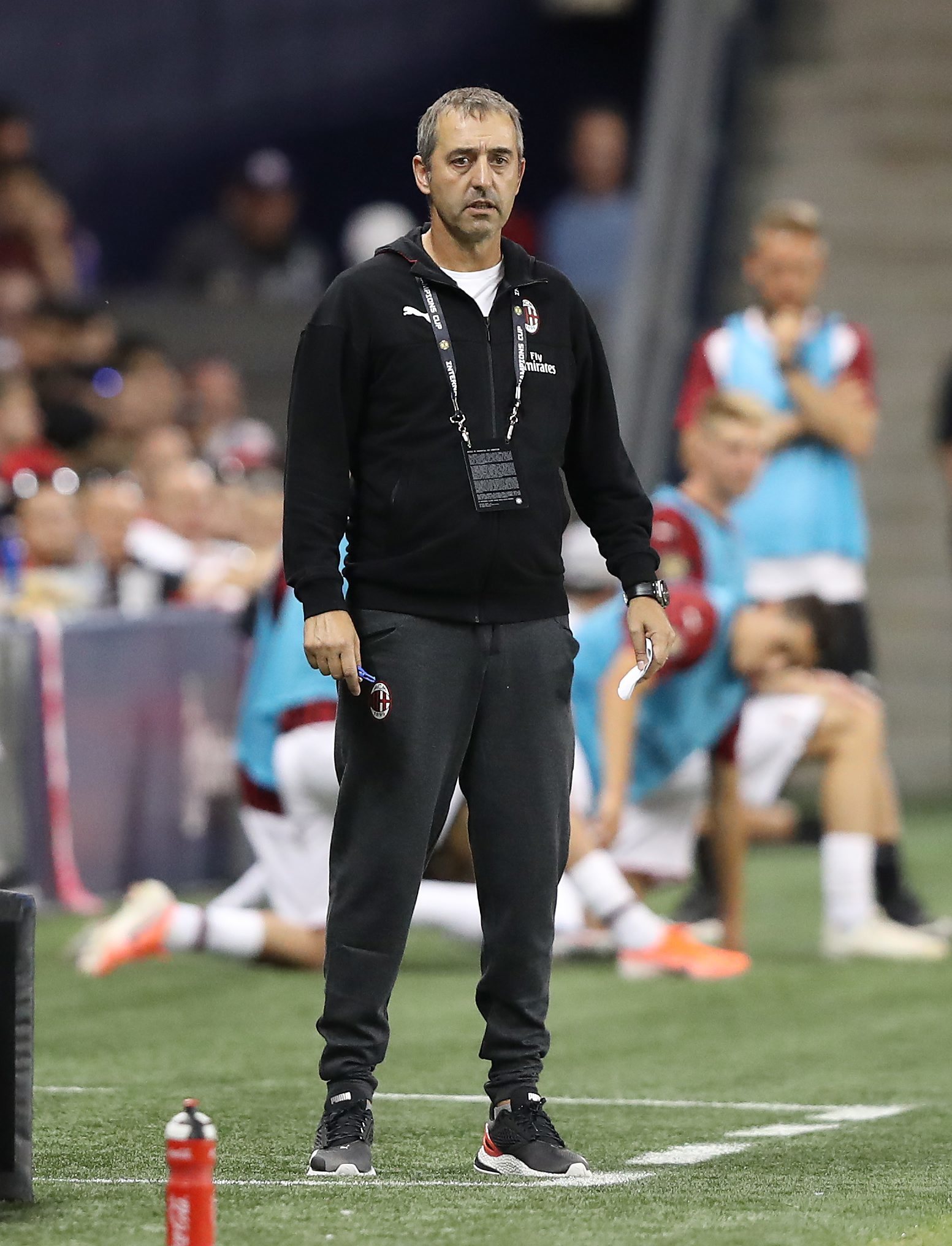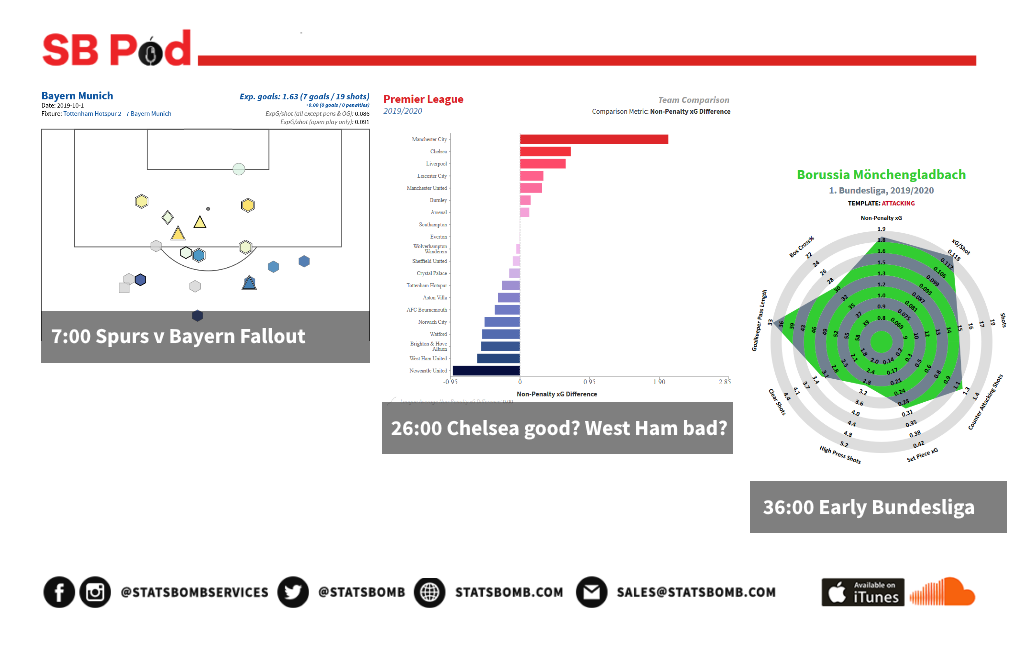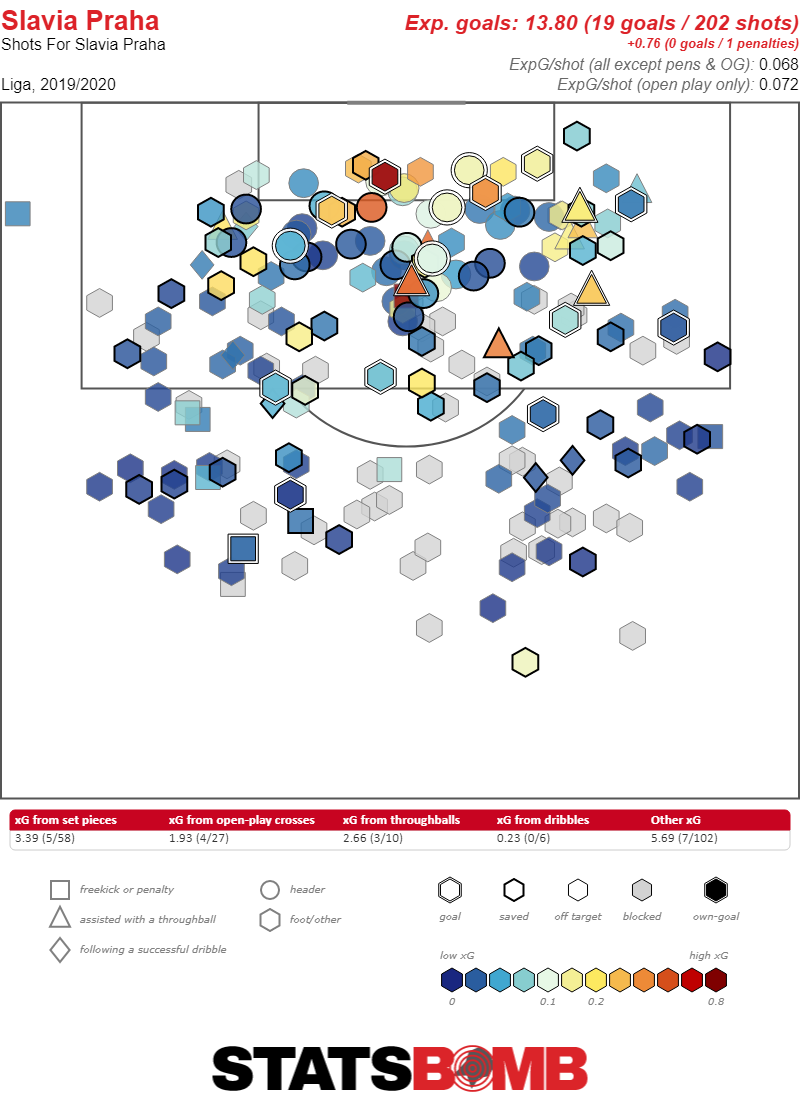Are there real problems here? For the previous two years, Manchester City have been as close to perfect as we have ever seen in the Premier League. 198 points, 201 goals scored, 50 conceded across 76 games is as good as it’s ever been in England’s top flight. This is the pinnacle. So it’s perhaps inevitable that even a minor dip in performance gets scrutinised to death. But, nevertheless, scrutinise we shall, and there are real concerns about this City side that did not exist in previous years. On the attacking end, it looks fine. More than fine, in fact. The 2.87 expected goals per game is better than ever. While in previous years things were more balanced, it seems as though Pep Guardiola has tweaked his system to really allow Kevin De Bruyne to do his thing. With David Silva at age 33 becoming more of a rotation option than one of the first names on the teamsheet, City have experimented with pushing De Bruyne into a more advanced role as a number ten in which he, at times, seems to be pushed up right alongside the striker. Against Shakhtar Donetsk, for example, the passmap shows him just as advanced as Gabriel Jesus, with City really looking like a 4-2-4 in possession. 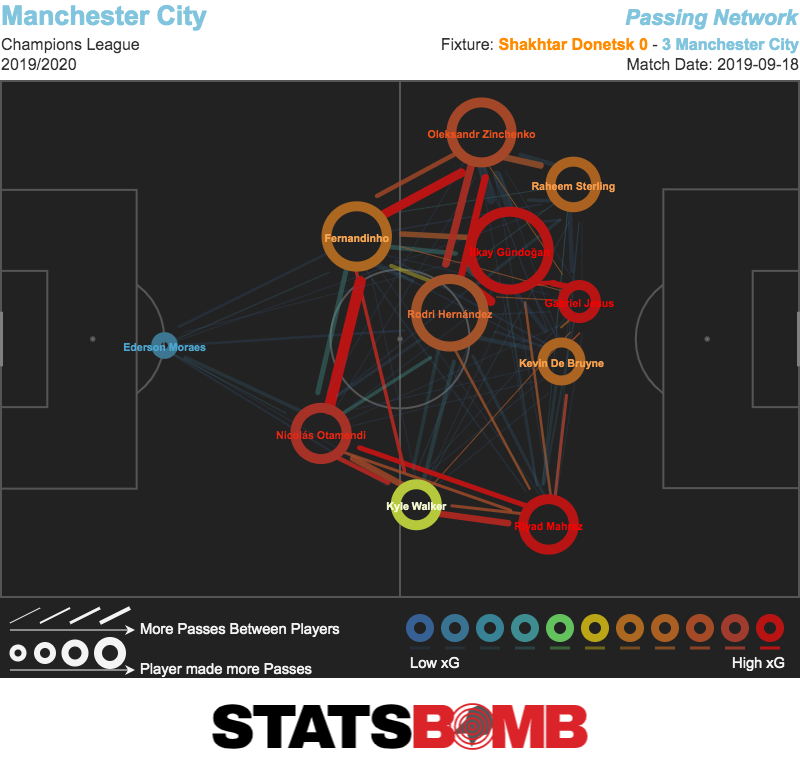 The one significant time Guardiola employed this tactic in his career was a stretch in in early 2010, when he was attempting to move Lionel Messi into a more central role but still felt the need for a “proper” striker, with Messi fielded as a number ten who could take up centre forward positions. That De Bruyne has been given a role once created for Messi is obviously a great credit to the Belgian, and he’s really thriving in it. He might be touching the ball in very advanced areas, but he’s still unquestionably a playmaker, and his 0.7 open play xG assisted per 90 is defying all known logic. On these grounds, it’s forgivable that City’s attack stuttered against Wolves when everything has been funnelled towards one man who wasn’t available.
The one significant time Guardiola employed this tactic in his career was a stretch in in early 2010, when he was attempting to move Lionel Messi into a more central role but still felt the need for a “proper” striker, with Messi fielded as a number ten who could take up centre forward positions. That De Bruyne has been given a role once created for Messi is obviously a great credit to the Belgian, and he’s really thriving in it. He might be touching the ball in very advanced areas, but he’s still unquestionably a playmaker, and his 0.7 open play xG assisted per 90 is defying all known logic. On these grounds, it’s forgivable that City’s attack stuttered against Wolves when everything has been funnelled towards one man who wasn’t available. 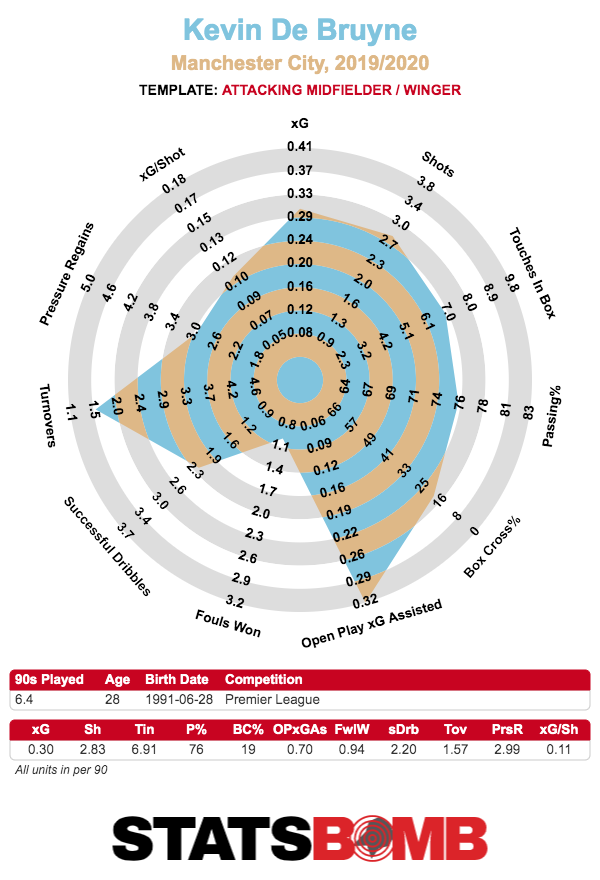 It doesn’t take a genius to figure out that the real concerns, however, are on the defensive side. Nine goals conceded in eight matches is obviously a sharp rise from the 0.6 goals against per game of last season, but is it just a weird finishing run? When looking at the raw shot counts, it seems that way. City are allowing seven shots against per game, just a fraction worse than last season’s 6.29 and still, as usual, the best in the league.
It doesn’t take a genius to figure out that the real concerns, however, are on the defensive side. Nine goals conceded in eight matches is obviously a sharp rise from the 0.6 goals against per game of last season, but is it just a weird finishing run? When looking at the raw shot counts, it seems that way. City are allowing seven shots against per game, just a fraction worse than last season’s 6.29 and still, as usual, the best in the league. 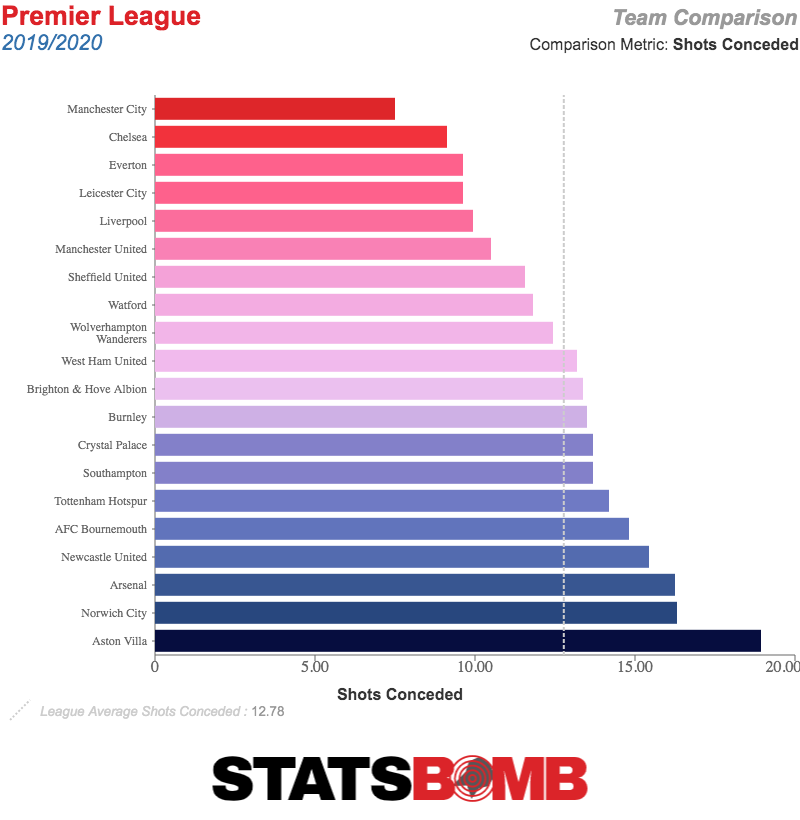 Of course shot volume doesn’t tell the whole story. The reason we have expected goals models is to find the outstanding cases where shot quality is playing a decisive role. And here’s where things get worrying. Last season, City had an xG per shot conceded of 0.09, around league average. This isn’t how a side that presses the ball as high up the pitch as City would typically operate. The point of a high press is that you limit the number of shots your opponent is able to take. The risk, though, is that once the opposition breaks your press, you’re badly exposed, and they can carve out an excellent scoring opportunity. That this team could press opponents so hard to concede the fewest shots in the league while also making sure those shots were only of middling quality seemed like genuine magic. And this is where we find the leak. City’s xG per shot conceded this season is 0.17, nearly double that of last year and the worst in the Premier League.
Of course shot volume doesn’t tell the whole story. The reason we have expected goals models is to find the outstanding cases where shot quality is playing a decisive role. And here’s where things get worrying. Last season, City had an xG per shot conceded of 0.09, around league average. This isn’t how a side that presses the ball as high up the pitch as City would typically operate. The point of a high press is that you limit the number of shots your opponent is able to take. The risk, though, is that once the opposition breaks your press, you’re badly exposed, and they can carve out an excellent scoring opportunity. That this team could press opponents so hard to concede the fewest shots in the league while also making sure those shots were only of middling quality seemed like genuine magic. And this is where we find the leak. City’s xG per shot conceded this season is 0.17, nearly double that of last year and the worst in the Premier League. 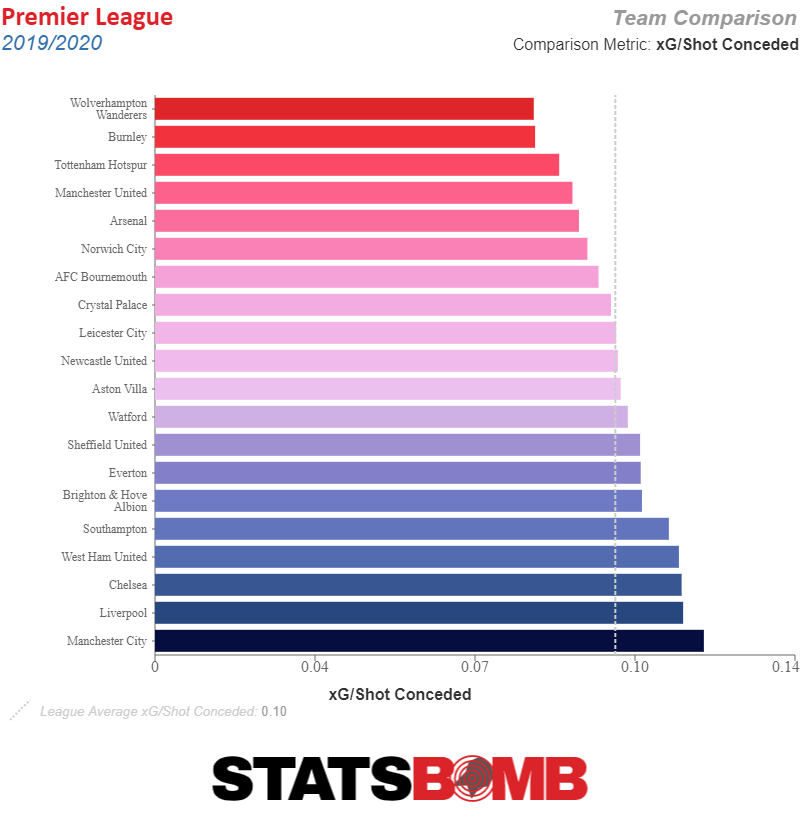 City concede the second fewest deep completions in the league and the second fewest opponent passes inside their own box. Teams still find it awfully difficult to get the ball up the pitch against Guardiola’s side and generate shots. But, once they do work it into dangerous areas, it seems to be easier than ever to turn those situations into good chances. They are about level in terms of goals conceded vs expected, having let in nine against an xG of 9.74. But this looks worse when you factor in post-shot information. City have needed Ederson to bail them out at times and he is delivering, saving nearly two goals more than expected on the post-shot model. Most likely, this just means that opposing players have happened to strike the ball well and Ederson stepped up to the plate. But it might be conceivable that the chances City are conceding could be of even higher quality than the pre-shot model thinks, and the post-shot data is picking up on something that’s happening. It’s not an accident that City have the defensive issues one would expect of a high pressing side with some problems. When looking at the team’s defensive distance, the average location up the pitch where they attempt a defensive action, it shows that City are pressing higher than ever. In fact, City have been gradually defending further and further up the pitch for the past twelve months.
City concede the second fewest deep completions in the league and the second fewest opponent passes inside their own box. Teams still find it awfully difficult to get the ball up the pitch against Guardiola’s side and generate shots. But, once they do work it into dangerous areas, it seems to be easier than ever to turn those situations into good chances. They are about level in terms of goals conceded vs expected, having let in nine against an xG of 9.74. But this looks worse when you factor in post-shot information. City have needed Ederson to bail them out at times and he is delivering, saving nearly two goals more than expected on the post-shot model. Most likely, this just means that opposing players have happened to strike the ball well and Ederson stepped up to the plate. But it might be conceivable that the chances City are conceding could be of even higher quality than the pre-shot model thinks, and the post-shot data is picking up on something that’s happening. It’s not an accident that City have the defensive issues one would expect of a high pressing side with some problems. When looking at the team’s defensive distance, the average location up the pitch where they attempt a defensive action, it shows that City are pressing higher than ever. In fact, City have been gradually defending further and further up the pitch for the past twelve months. 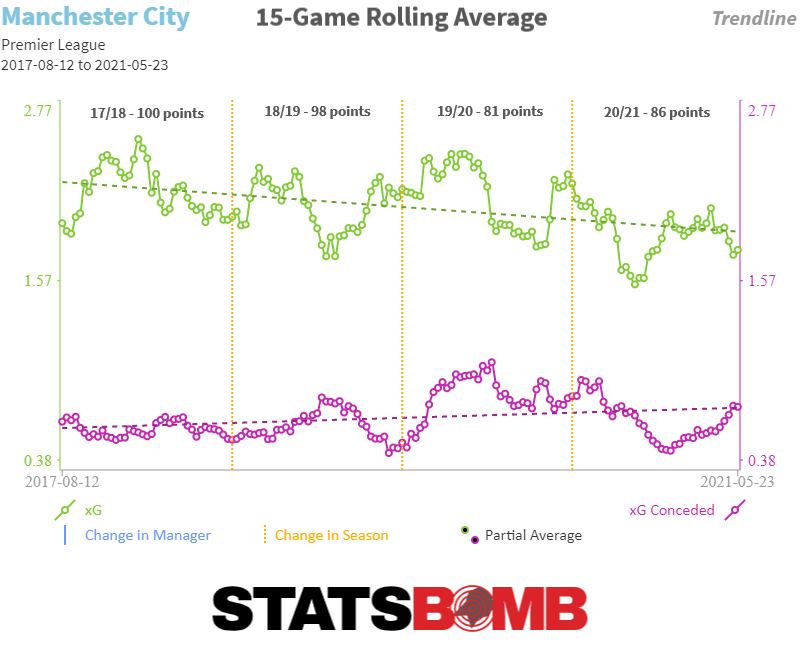 This wasn’t causing the side defensive issues until very recently. Perhaps they recently took it a little too far and the dam broke, or perhaps the issue lies somewhere else.
This wasn’t causing the side defensive issues until very recently. Perhaps they recently took it a little too far and the dam broke, or perhaps the issue lies somewhere else. 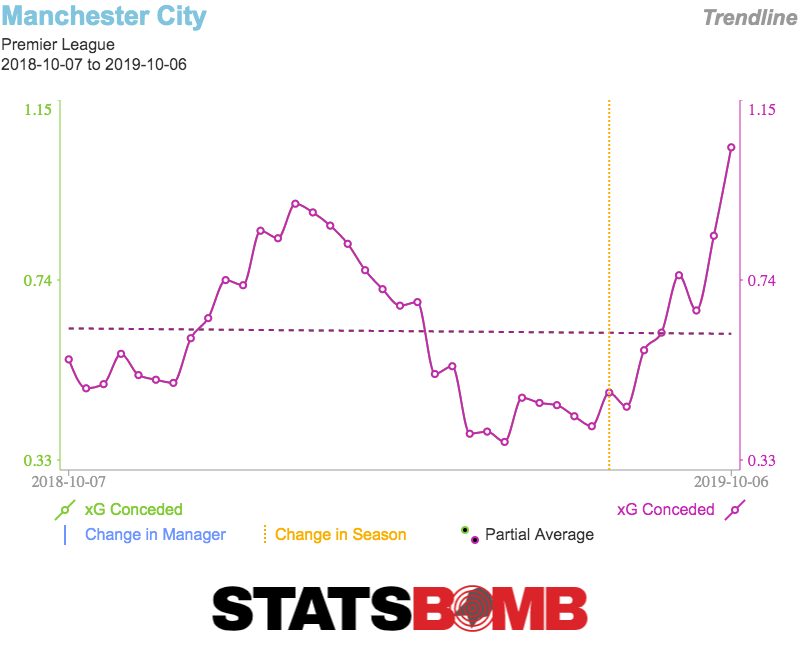 So the question comes to personnel. The one significant arrival to the team (sorry, João Cancelo, but you’re going to have to play more football before you count here) was Rodri as the “Fernandinho replacement”. Purely in terms of defensive output, there doesn’t seem to be an issue here.
So the question comes to personnel. The one significant arrival to the team (sorry, João Cancelo, but you’re going to have to play more football before you count here) was Rodri as the “Fernandinho replacement”. Purely in terms of defensive output, there doesn’t seem to be an issue here.  The dirty little not-so-secret about Fernandinho’s role for City has always been his tactical fouling, and purely in the numbers, it seems fine here. Rodri is making 2.82 fouls per 90, more than Fernandinho’s rate of 2.52 last season. But there are some differences we can observe in location. These are all of the Brazilian’s fouls last year. The obvious thing that stands out is that the vast majority were in the middle third of the pitch, with a good chunk in the opposition’s final third, and relatively few in his own defensive third.
The dirty little not-so-secret about Fernandinho’s role for City has always been his tactical fouling, and purely in the numbers, it seems fine here. Rodri is making 2.82 fouls per 90, more than Fernandinho’s rate of 2.52 last season. But there are some differences we can observe in location. These are all of the Brazilian’s fouls last year. The obvious thing that stands out is that the vast majority were in the middle third of the pitch, with a good chunk in the opposition’s final third, and relatively few in his own defensive third. 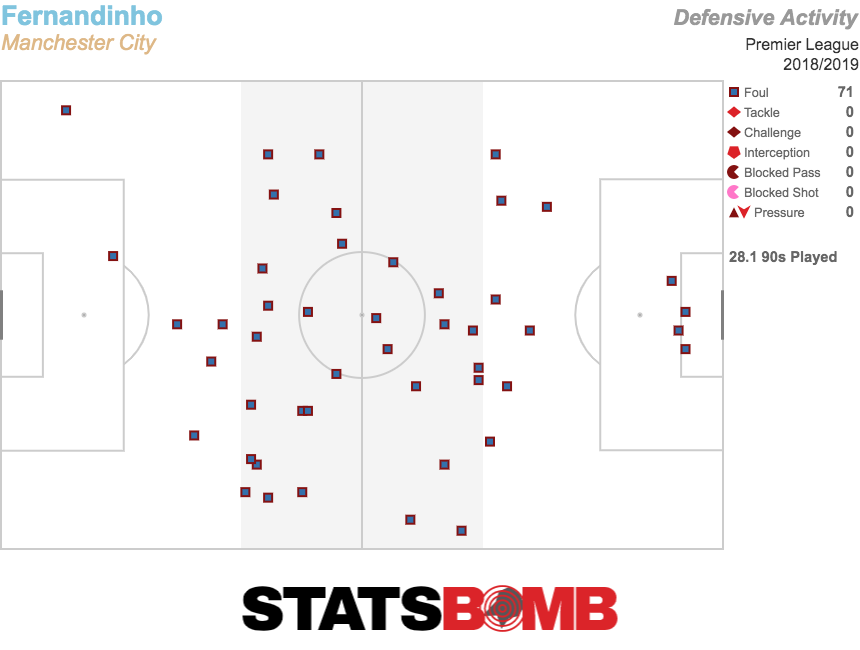 Now here are Rodri’s this season. Despite playing only a fraction of the minutes, he’s nearly made as many fouls in his own defensive third as Fernandinho did in all of last year. Are these “tactical” fouls, or simply fouls that you don’t want to give away? It’s not obvious.
Now here are Rodri’s this season. Despite playing only a fraction of the minutes, he’s nearly made as many fouls in his own defensive third as Fernandinho did in all of last year. Are these “tactical” fouls, or simply fouls that you don’t want to give away? It’s not obvious.  One thing Rodri perhaps lacks in the role is mobility. This might be part of Guardiola’s thinking in the new shape, putting Ilkay Gündoğan alongside the Spaniard in a double pivot, giving him some assistance and lessening the size of the area in which he needs to offer defensive cover. It’s not clear what exactly Gündoğan is offering in this regard. He isn’t a particularly aggressive ball winner. He’s not a tactical fouler, making less than one foul per 90. And he’s not especially adventurous in his passing. If adding him into a double pivot clearly isn’t making the side more stable, what is the point of him being there?
One thing Rodri perhaps lacks in the role is mobility. This might be part of Guardiola’s thinking in the new shape, putting Ilkay Gündoğan alongside the Spaniard in a double pivot, giving him some assistance and lessening the size of the area in which he needs to offer defensive cover. It’s not clear what exactly Gündoğan is offering in this regard. He isn’t a particularly aggressive ball winner. He’s not a tactical fouler, making less than one foul per 90. And he’s not especially adventurous in his passing. If adding him into a double pivot clearly isn’t making the side more stable, what is the point of him being there?  Obviously the other significant issue is Aymeric Laporte’s injury. It’s worth mentioning that City were not without defensive concern before then. Laporte played the full 90 minutes away at Bournemouth in a game where City conceded 1.63 xG from 10 shots. But it also seems fairly indisputable that the current pairing of Nicolás Otamendi and no-longer-midfielder Fernandinho are not fully capable of doing what is being asked of them. The issue is probably being magnified by what’s in front of them. It often felt like City’s pressing structure was so good, so complete, that you could play anyone at centre back and they’d have so little to do that it wouldn’t matter. The defensive injuries have come at the worst possible time for City in that the centre backs are being asked to do more decisive defending than ever. They’re not delivering on that front. All things considered, City are still a very good football team. Their xG difference per game of +1.86 is still comfortably the best in the Premier League, though it’s down to a hugely dominant attack overpowering the ninth best defence. The manager is, you know, not bad at his job. Liverpool have issues of their own. If the season reset to zero tomorrow, City would still be the clear favourites. An eight point gap is a real thing, though. For City to bridge it, they need to start playing their best football again as soon as possible. If these issues drag into the winter months, then things could become very difficult for the blue side of Manchester.
Obviously the other significant issue is Aymeric Laporte’s injury. It’s worth mentioning that City were not without defensive concern before then. Laporte played the full 90 minutes away at Bournemouth in a game where City conceded 1.63 xG from 10 shots. But it also seems fairly indisputable that the current pairing of Nicolás Otamendi and no-longer-midfielder Fernandinho are not fully capable of doing what is being asked of them. The issue is probably being magnified by what’s in front of them. It often felt like City’s pressing structure was so good, so complete, that you could play anyone at centre back and they’d have so little to do that it wouldn’t matter. The defensive injuries have come at the worst possible time for City in that the centre backs are being asked to do more decisive defending than ever. They’re not delivering on that front. All things considered, City are still a very good football team. Their xG difference per game of +1.86 is still comfortably the best in the Premier League, though it’s down to a hugely dominant attack overpowering the ninth best defence. The manager is, you know, not bad at his job. Liverpool have issues of their own. If the season reset to zero tomorrow, City would still be the clear favourites. An eight point gap is a real thing, though. For City to bridge it, they need to start playing their best football again as soon as possible. If these issues drag into the winter months, then things could become very difficult for the blue side of Manchester.
Month: October 2019
Aston Villa have given midfielder Marvelous Nakamba a thankless job, and he's doing it admirably
Aston Villa have made a surprisingly strong start to the season. It's not so much their position in the league table, they're 15th, but only one point above the relegation zone. Rather, the eye opening number is the fact that eight games into a season where the newly promoted team was expected to struggle, they've actually scored one more goal than they've conceded. Sadly for Villa, the xG numbers don't exactly back up their goal scoring record.
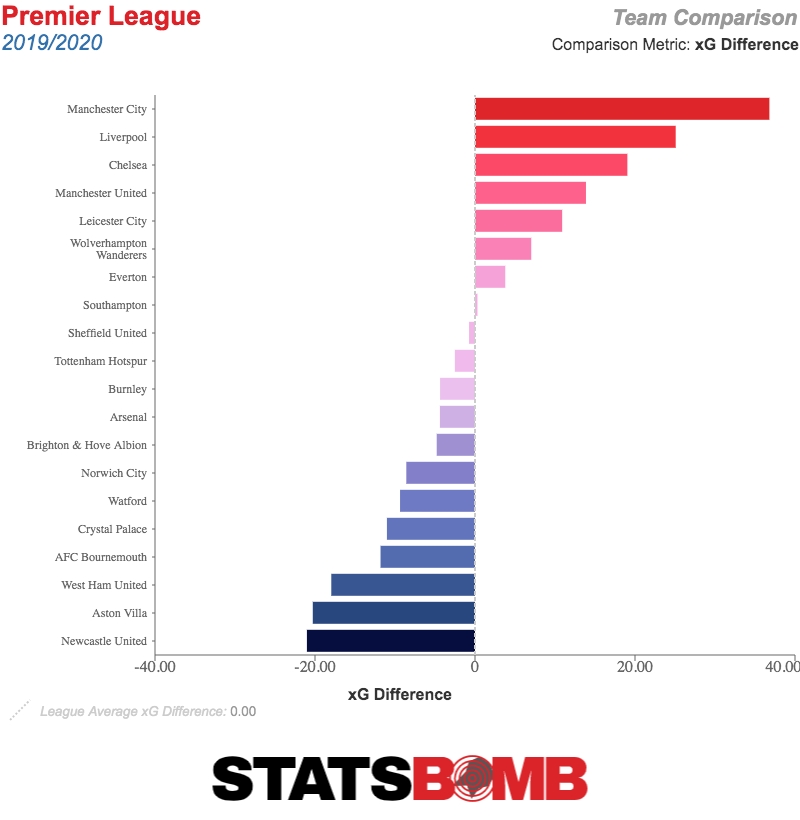
Specifically on the defensive side of the ball Villa have struggled with a case of the Arsenals. They give up a lot of shots:
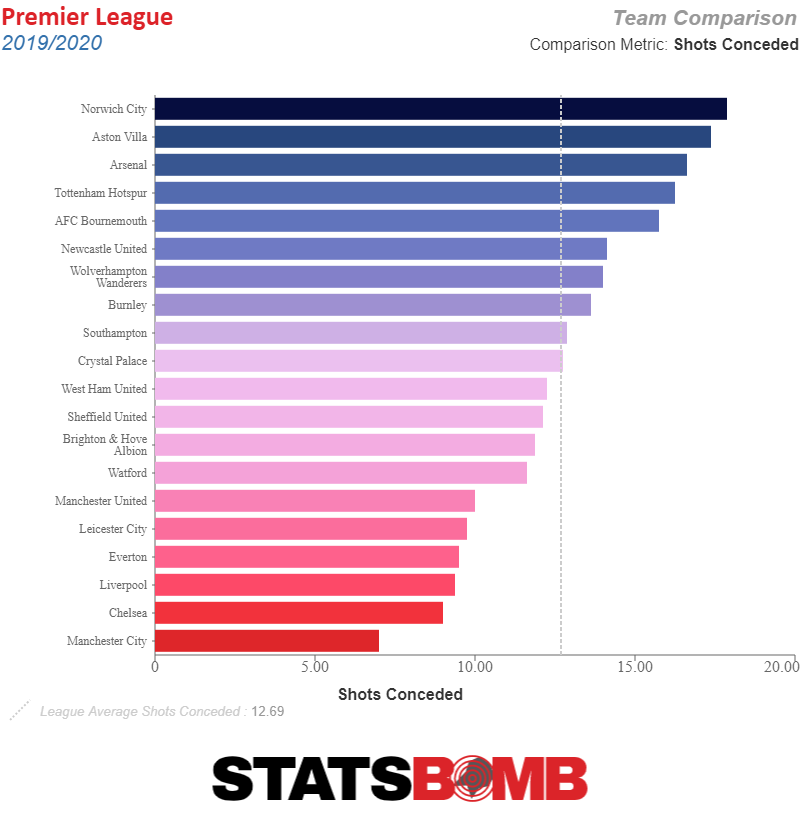
And while the quality of those shots are generally low, they aren't on average low enough to make up for the extremely high volume.
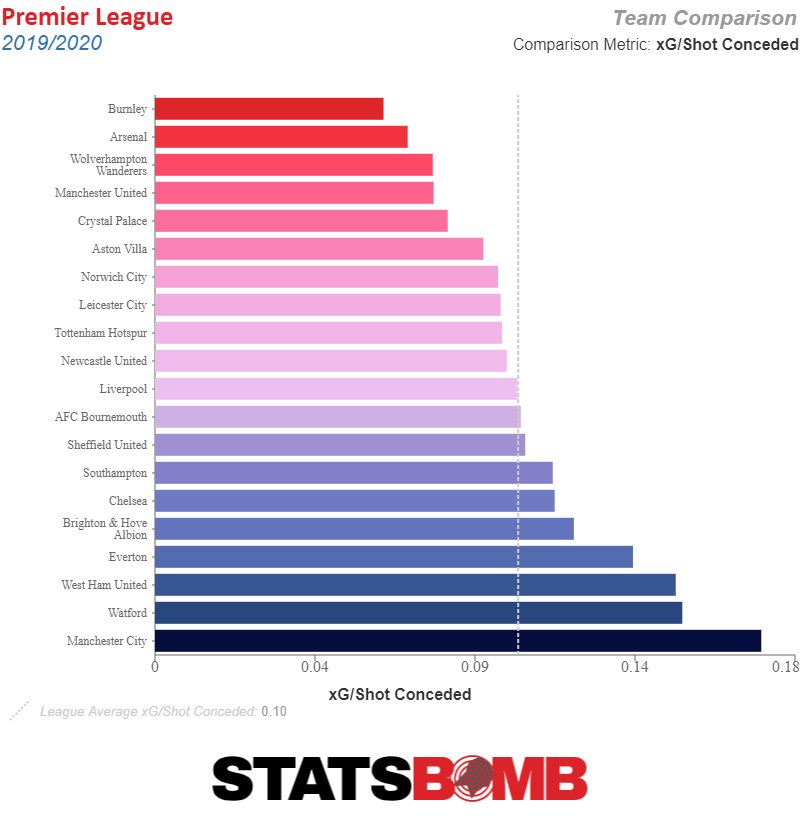
Nowhere is it as clear just how overwhelmed this Villa defense is than in the numbers of Marvelous Nakamba. The poor guy really is doing the most defensive work he can.
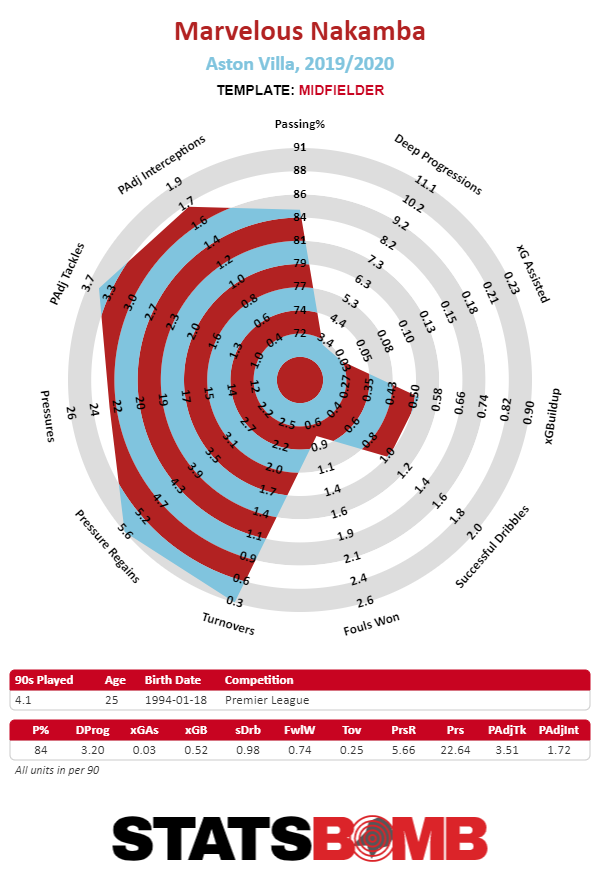
Nowhere will you find a clearer statistical example of a midfielder shielding his defenders than what he does. He just sits in the middle of the field and breaks up play after play after play in front of his own penalty area.
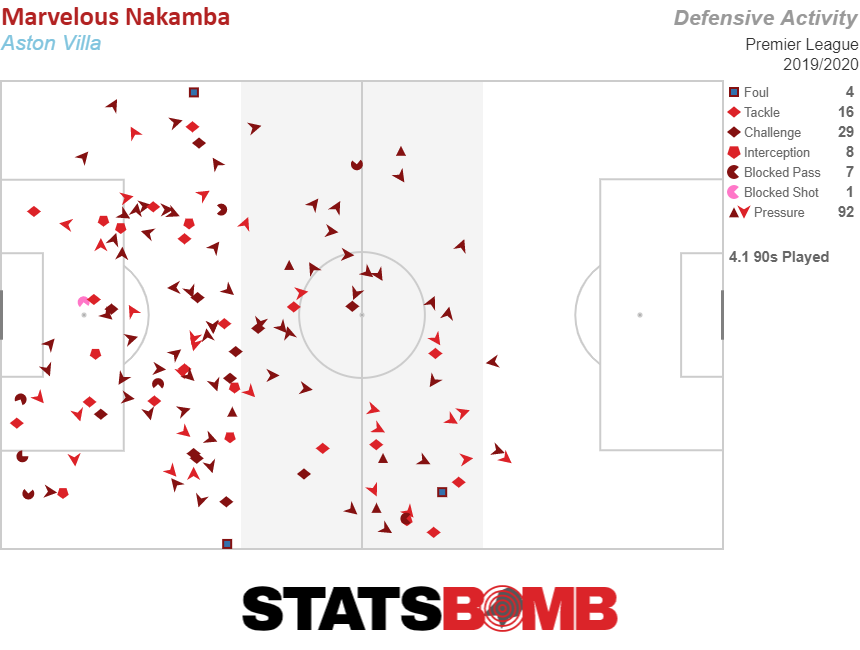
The problem for Villa is that it sure seems like their defensive midfielder is their first line of defense. The side simply offers zero opposition until the ball is sitting in Nakamba's lap.
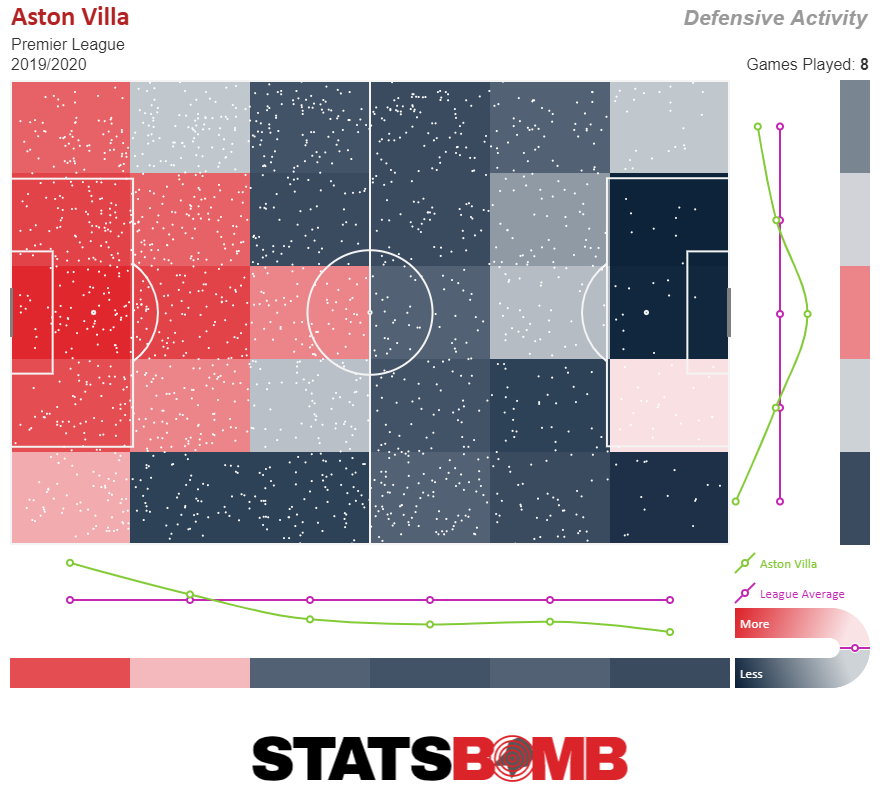
Villa's surprisingly lively attack has received a lot of praise, especially after hanging five goals on Norwich last weekend. And it should. It's no small thing for a newly promoted team to be a Premier League average attack after eight matches. But it's coming at a cost. And the brunt of that cost is being born by Nakamba.
That's not to say, that Villa's defensive midfielder is perfect, or maybe even above average. His numbers in possession are truly terrible. He does very little to move the ball up the field, and despite his relatively unambitious passing, his pass completion percentage is only 84.5%.
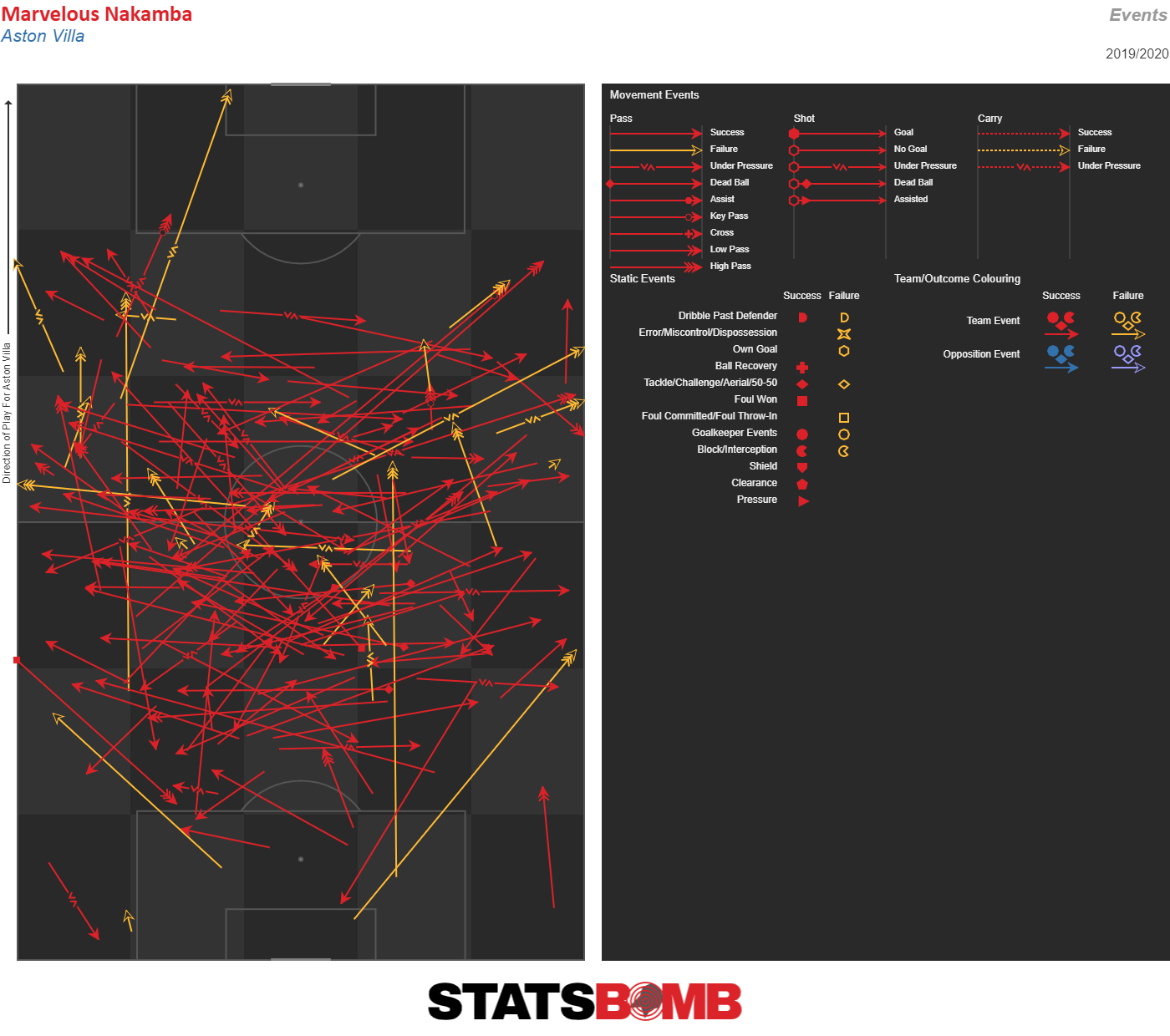
Nakamba is as pure a defensive midfielder as you'll find in the Premier League. His job is to shield the back line and win the ball. On Aston Villa, that's a near impossible task. Villa is a classic case of a team that's putting its defensive personnel in a position to fail. Nakamba is performing admirably despite that. If Villa continue to play this way, and manage to remain in the Premier League it's going to look ugly defensively all year long. If it works, it'll just barely work, but if it weren't for Nakamba it would probably have no shot of working at all.
Robert Lewandowski is still the best
Everybody knows that Robert Lewandowski is good. This season, though, he's been way better than good. 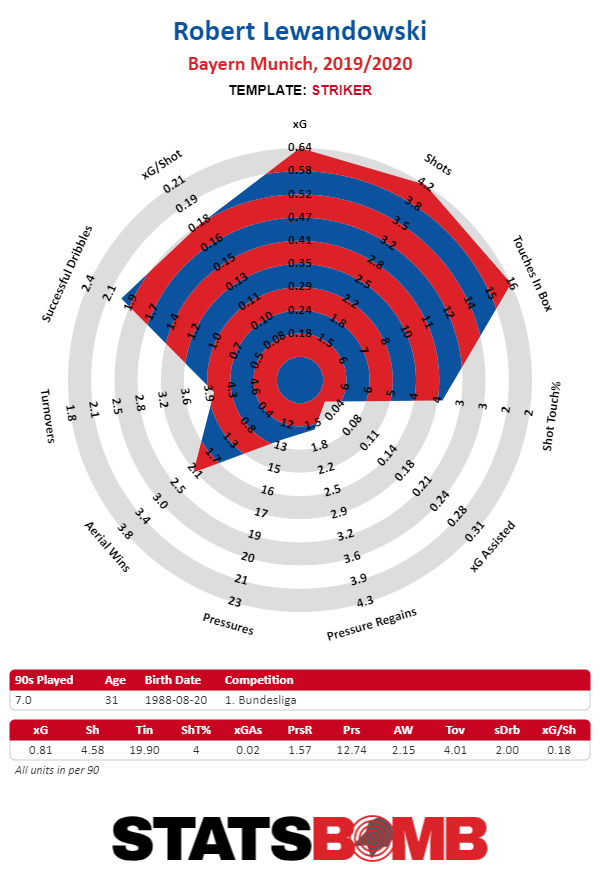
Let's start with the most basic number of all. He's scoring, including penalties, 1.57 goals per 90 minutes. He's the only player (with over 300 minutes played) in the Bundesliga averaging more than a goal per 90. Filter out penalties and he's averaging "only" 1.27 goals per 90. That, at least brings him to almost within a third of a goal of his closest competitor, Paco Alcácer at 0.97. Nobody else in the league cracks the 0.,80 barrier.
How exactly is he doing this? The answer is that he's doing the two things that every great scorer dreams of doing. He's taking lots of shots and he's taking only great shots. Do that and things look really really easy. Lewandowski is taking the most shots in the league, 4.58 per 90, and among forwards is averaging the third highest shot quality at 0.18 expected goals per shot. It's just exceptionally rare to be both a high quality and high quantity shooter.
There only 15 players in the Bundesliga averaging over three shots per 90 minutes. And, of those players, only two are near Lewandowski. Alassane Pléa and Timo Werner are both also averaging 0.18 xG per shot, but they have only 3.21 and 3.35 shots per 90 respectively. Those are both really good totals, and in an alternate universe where Lewandowski didn't exist we'd be talking about their numbers as being uniquely able to capitalize on both of a striker's necessary skills. It just happens to be that Lewandowski is superhuman outdoes them both in each category.
The reason that this shot profile is so rare is that most high volume shooters buttress their great shots with a raft of more speculative efforts. Lewandowski doesn't.
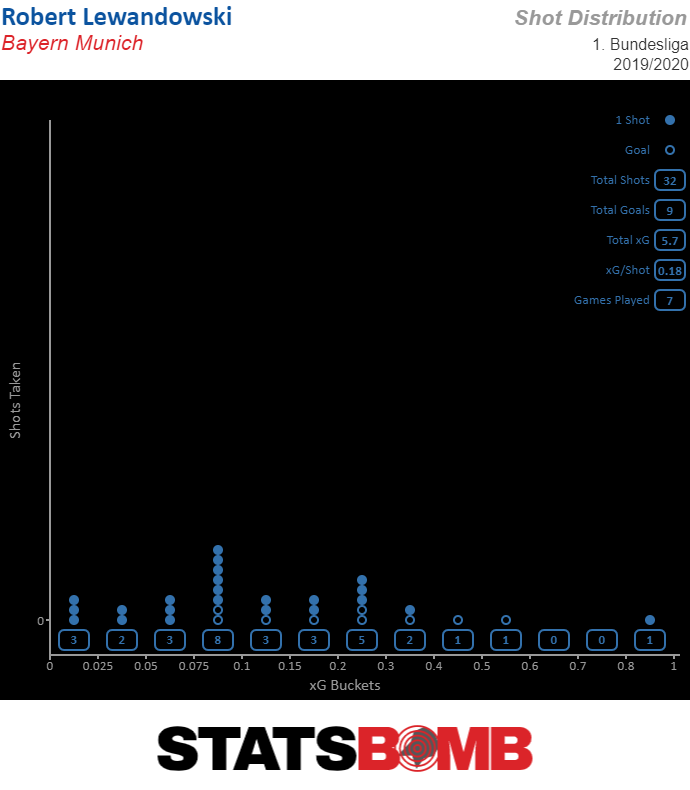
Put it all together and Lewandowski's shot chart is simply a thing of beauty. It's certainly true that his hot start to the season has him overperforming his xG but that xG is itself just absolutely mammoth.
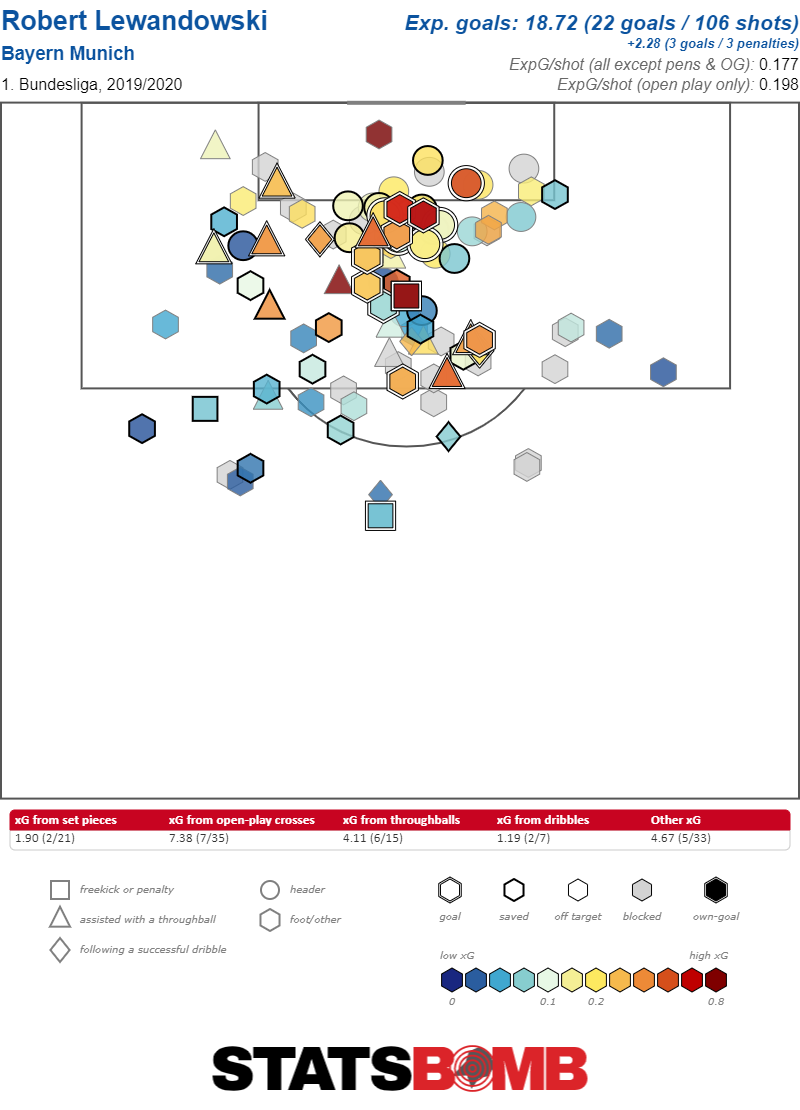
It's likely that he won't keep up this absurd level of goal scoring. Nobody runs this hot forever. But, the underlying numbers, while fantastic, aren't particularly beyond what we've come to expect from the Polish striker. Last season his xG per shot was virtually identical to the numbers he's putting up now. The main difference is that he's averaging half a shot more per match.
That might seem small, but do the math. Over the course of a season that works out to 17 more shots. If his xG per shot remains constant at 0.18 then that means that the increase in shots should lead to roughly three more goals. Such margins are the kinds of things titles are won and lost on. Robert Lewandowski is fantastic.
He gets all the shots, and they're all great. Bayern have gone a long way to revamping their attack this season. Franck Ribery and Arjen Robben are gone with Serge Gnabry and Kingsley Coman stepping into their huge shoes. Philippe Coutinho and Ivan Perišić arrived to help shoulder the load. But, at the end of the day, it remains Lewandowski sitting atop it all, unparalleled, and hammering in all the goals.
There are statistical warning signs lurking below Liverpool's perfect Premier League start
There’s an attacker in England who, after two seasons of utter dominance, has fallen down to Earth with good but not great production. His team’s record remains surprisingly strong, but underneath the hood, their expected goals record belies a team not actually at the station they expected to be, lucky to be above their rivals in the table. I’m talking, of course, about Mo Salah and Liverpool. It’s hard to complain about a team that has taken 21 of 21 points in the league and a guy who has three non-penalty goals and three assists in seven league matches, but the statistical record is flashing some warning signs. In 2017-2018, Salah came into the Premier League and set the world on fire. He took four shots per game, and racked up buckets of high quality chances, dribbling past would be defenders with aplomb, leaving them on the ground, and firing shots from the center of the box. His 0.6 expected goals per 90 minutes and 0.2 open play expected goals assisted per 90 led him to a Premier League Player of the Year. Last season, he came back to earth but was still excellent, with 0.4 xG per 90 and 0.22 open play xG assisted per 90. This season though? Through seven league matches Salah has just 0.37 xG per 90 and 0.05 xG assisted per 90. He’s still getting tons of touches in the box, more than last year in fact. But Salah is completing just 30% of his passes in the box or into the box to teammates, as compared to almost 50% last year. He’s also taken just a single shot with his feet within nine yards of goal this season. He had 29 such shots over the past two seasons combined. Perhaps that will change, but he does look somewhat less explosive than he did the last couple years, not turning the corner in the box with the same gusto. Two seasons of 4500 minutes plus playing in international tournaments may be taking its toll. Interestingly, the attack remains near last year's heights. Roberto Firmino and Sadio Mane have been excellent. While the team is not creating from open play like it did two seasons ago, they are finding more goals from set pieces. With the team treading water offensively, Liverpool’s xGD is a far cry from the heights of last season, and quite frankly, the second half of last season is a far cry from the first half: 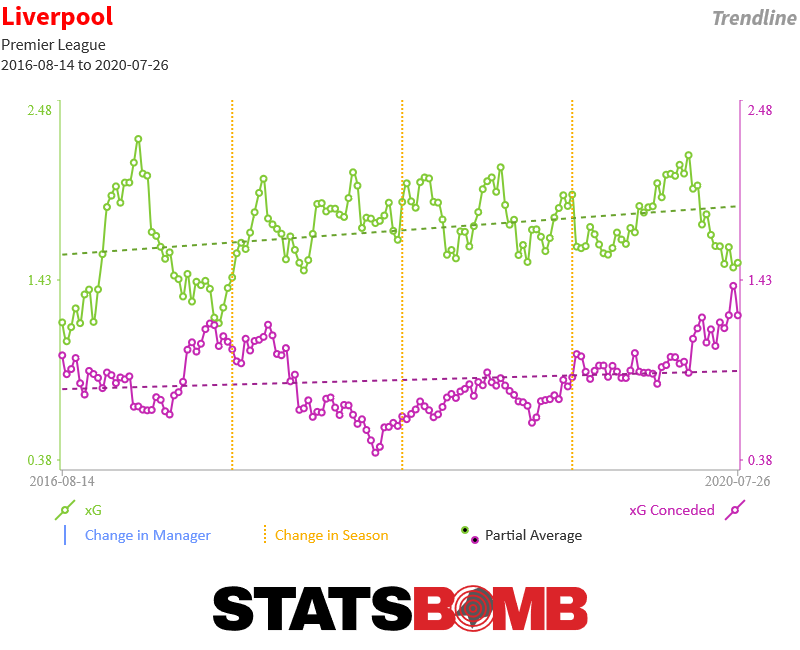 As we saw against Salzburg, it is the defense that is struggling in particular, shipping significantly more high quality chances than it did last season.
As we saw against Salzburg, it is the defense that is struggling in particular, shipping significantly more high quality chances than it did last season. 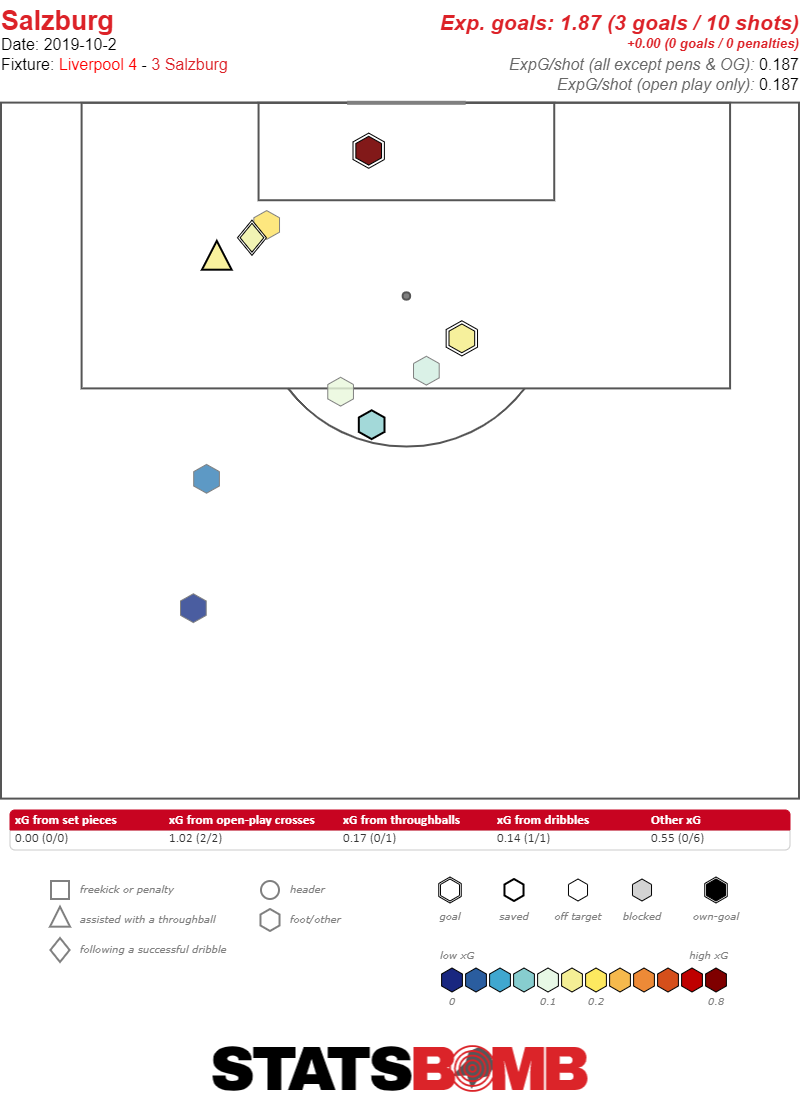 Perhaps the defense is struggling because the defenders are being asked to do too much in attack. Klopp played Andrew Robertson over 4500 minutes last season, rarely rotating his hyper-athletic left back who also was one of the team’s major creative engines. The wear on Robertson appears to be showing, with Robbo getting beaten much more consistently this season.
Perhaps the defense is struggling because the defenders are being asked to do too much in attack. Klopp played Andrew Robertson over 4500 minutes last season, rarely rotating his hyper-athletic left back who also was one of the team’s major creative engines. The wear on Robertson appears to be showing, with Robbo getting beaten much more consistently this season. 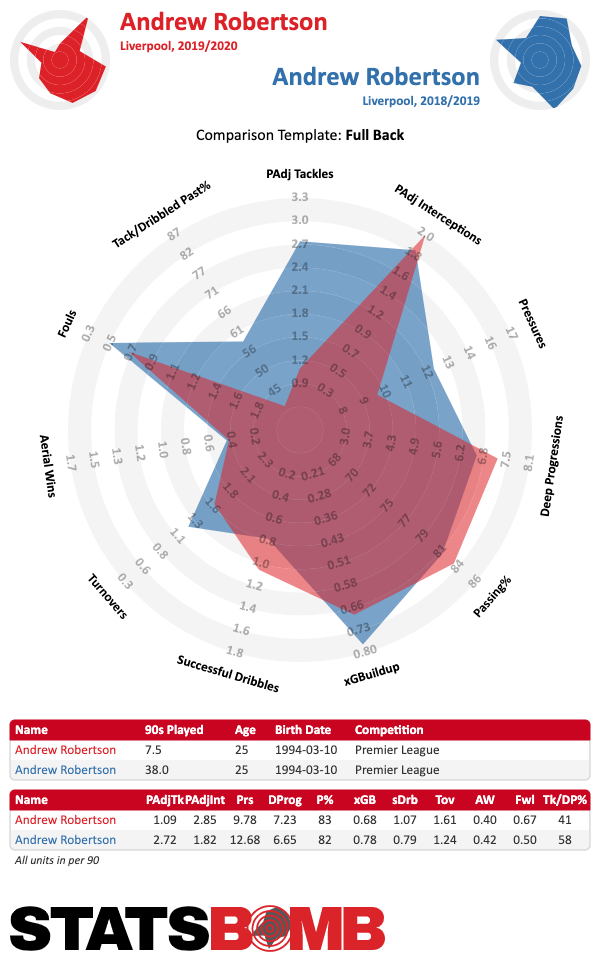 Trent Alexander-Arnold who also played a huge number of minutes at such a demanding position is also struggling to meet last year’s heights and is also one of Liverpool’s key creators. Last season and this season Liverpool got much of its creative output from its two fullbacks, but have perhaps ramped up their intensity even higher as a result of the midfield’s lack of ball progression. Alexander-Arnold and Robertson are combining for over 5.5 touches in the box so far this season, up significantly from about 4 combined last season. Robertson has even more deep progressions this year than last, one of his few increases in output. Robertson’s charging run into the box for a goal against Salzburg was a wonderful piece of skill, but also perhaps indicative of a team that has turned to its fullbacks to do too much, especially given that in the same move he was the player to advance the ball into the opposition half from his own defensive zone. Even so, last year Liverpool asked a lot of its fullbacks and were rock solid defensively. Teams do seem to be exploiting the space left by Alexander-Arnold more ruthlessly. The number of successful passes into areas he nominally would be controlling have increased significantly on a per 90 basis this season. But perhaps the other major change has been the loss of Alisson to start the season. Alisson is significantly more aggressive off his line than Adrian.
Trent Alexander-Arnold who also played a huge number of minutes at such a demanding position is also struggling to meet last year’s heights and is also one of Liverpool’s key creators. Last season and this season Liverpool got much of its creative output from its two fullbacks, but have perhaps ramped up their intensity even higher as a result of the midfield’s lack of ball progression. Alexander-Arnold and Robertson are combining for over 5.5 touches in the box so far this season, up significantly from about 4 combined last season. Robertson has even more deep progressions this year than last, one of his few increases in output. Robertson’s charging run into the box for a goal against Salzburg was a wonderful piece of skill, but also perhaps indicative of a team that has turned to its fullbacks to do too much, especially given that in the same move he was the player to advance the ball into the opposition half from his own defensive zone. Even so, last year Liverpool asked a lot of its fullbacks and were rock solid defensively. Teams do seem to be exploiting the space left by Alexander-Arnold more ruthlessly. The number of successful passes into areas he nominally would be controlling have increased significantly on a per 90 basis this season. But perhaps the other major change has been the loss of Alisson to start the season. Alisson is significantly more aggressive off his line than Adrian.  While Virgil Van Dijk can do almost everything, perhaps he cannot cover for two fullbacks and a less aggressive keeper. Looking at the radars of the two keepers, you can see that Alisson’s “GK Aggressive Distance” - where he makes tackles, interceptions, etc. - is much farther off the line than Adrian, who has otherwise filled in quite admirably. Liverpool’s high line, and very high fullbacks, have survived because Van Dijk is so good at filling in space, but also because their goalkeeper was perhaps also good at protecting the team from dangerous long balls into space. Using Statsbomb’s IQ tactics we can look at how well teams are completing passes against Liverpool that start from above the box in their own half and go into the final third. Last season teams completed 29% of such passes and completed 4.6 such passes per match. So far those numbers are 39% and 6.3.
While Virgil Van Dijk can do almost everything, perhaps he cannot cover for two fullbacks and a less aggressive keeper. Looking at the radars of the two keepers, you can see that Alisson’s “GK Aggressive Distance” - where he makes tackles, interceptions, etc. - is much farther off the line than Adrian, who has otherwise filled in quite admirably. Liverpool’s high line, and very high fullbacks, have survived because Van Dijk is so good at filling in space, but also because their goalkeeper was perhaps also good at protecting the team from dangerous long balls into space. Using Statsbomb’s IQ tactics we can look at how well teams are completing passes against Liverpool that start from above the box in their own half and go into the final third. Last season teams completed 29% of such passes and completed 4.6 such passes per match. So far those numbers are 39% and 6.3. 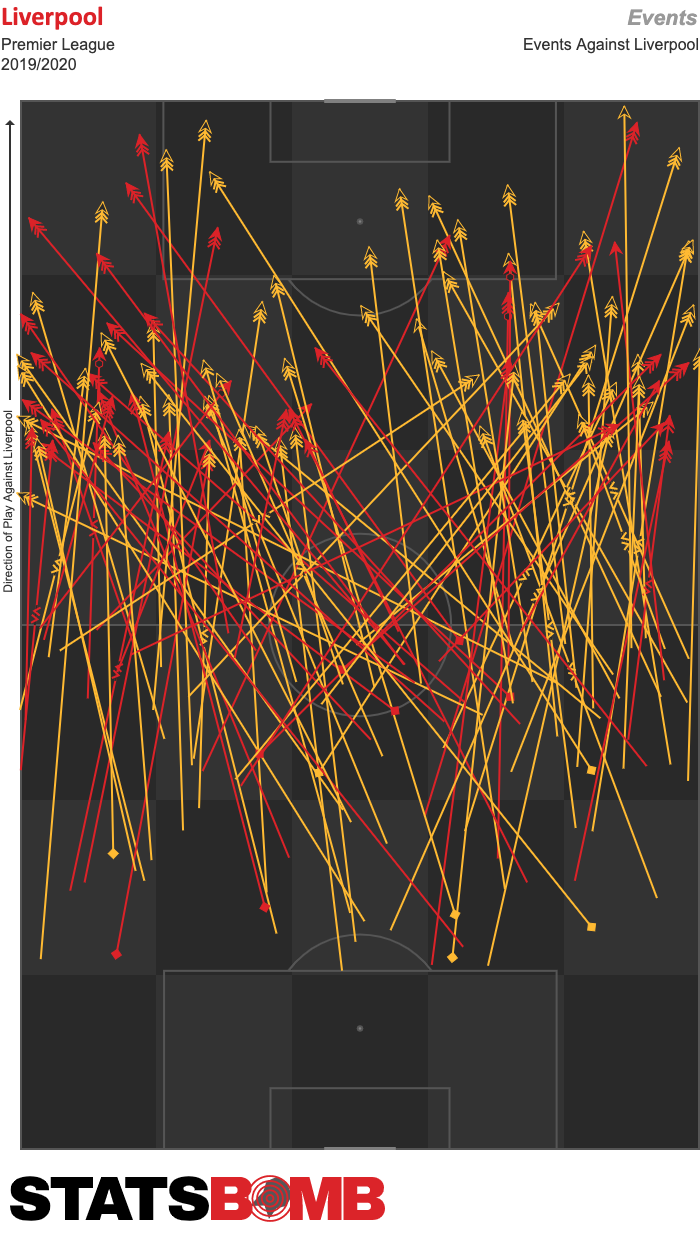 Simpler explanations for Liverpool’s statistical (though otherwise non-existent) struggles may also suffice. Seven matches is a small sample size. Virgil Van Dijk could have experienced a career year at 27 and still be great, just not superhuman this season. Of course, Liverpool may well start producing at last year’s levels again soon. Still, it’s important not to get fooled by the record and to see that maybe there are some cracks in what otherwise seems like an unstoppable juggernaut.
Simpler explanations for Liverpool’s statistical (though otherwise non-existent) struggles may also suffice. Seven matches is a small sample size. Virgil Van Dijk could have experienced a career year at 27 and still be great, just not superhuman this season. Of course, Liverpool may well start producing at last year’s levels again soon. Still, it’s important not to get fooled by the record and to see that maybe there are some cracks in what otherwise seems like an unstoppable juggernaut.
Marco Giampaolo's AC Milan is off to a miserable start in Serie A
“I believe in my ideas, but this Milan team looked like it turned up without ever having a training session together. It played badly on an individual level, with no organization or sense of collective responsibility”. Nothing gives a clearer impression of how poorly AC Milan's season has started than the words pronounced by their own coach, Marco Giampaolo, at the end of the match against Fiorentina. The three goals scored by the Viola at San Siro resulted in the fourth defeat in six games for the Rossoneri, surely not the landmark that their fans, who left the stadium on Sunday evening well before the final whistle, were expecting to reach after yet another new start. Milan hadn't lost four of the first six games since the 1938-39 season. And what's even more worrying is that the six points collected so far, are the result of wins, both for 1-0, against Brescia and Hellas Verona, two of the three teams just promoted from the Serie B. The Berlusconi era is now well over and in recent years, Milan's technical potential has been gradually depleted and not even the most sanguine of their supporters expected this team to compete for the Scudetto, but it was rather difficult to predict such an abysmal start. This summer the management selected by the Elliot fund (which includes club legends Paolo Maldini and Zvonimir Boban) has followed a transfer market strategy aimed at cutting wages (-€25 million compared to last season) and towards the purchasing of young players to be developed, such as 20-years-old striker Rafael Leao, which can allow the club to draw significant resources from player trading and therefore to pursue a sustainable growth model. The policy makes even more sense given that they've been excluded from the Europa League over breaches of Financial Fair Play rules. In theory then, a coach capable of nurturing talent, such Giampaolo, sould play a key role. All in all, the roster at Giampaolo's service is not very different from the one which Gennaro Gattuso led to fifth place last season. In addition to Leao, they purchased Léo Duarte (23 years old) as a backup for centerbacks Alessio Romagnoli and Mateo Musacchio, leftback Theo Hernández (21), Empoli’s midfielders Ismaël Bennacer (21) and Rade Krunic (25) and Ante Rebic (25), who arrived on loan in a double swap deal, with André Silva joining Eintracht Frankfurt on loan for two years. Although new purchases were not immediately included in the starting XI (their total playing time to date accounts for 14.9% of total minutes), so far Milan players have not been able to assimilate the ideas of the former coach of Sampdoria, whose employment status is now tenuous at best. Although Giampaolo has tried to propose tweaks to his favorite system of play, the 4-3-1-2, AC Milan’s play has been very poor both on offense and defense. The results are only the logical consequence of the team's performance.
Offensive struggles and tactical conundrums
At Giampaolo's debut on the Milan bench, the Rossoneri weren't able to fire a single shot on target against Udinese’s keeper Juan Musso and generated just 0.52 expected goals. Apart from a 2.32 xG outlier against Torino, which was the best Milan game of the season, they have struggled to create high-scoring opportunities (0.075 xG/shot on average, sixteenth in the league) and to convert them in other matches, too. No wonder their shot map looks like Pablo Picasso’s palette during his Blue Period. 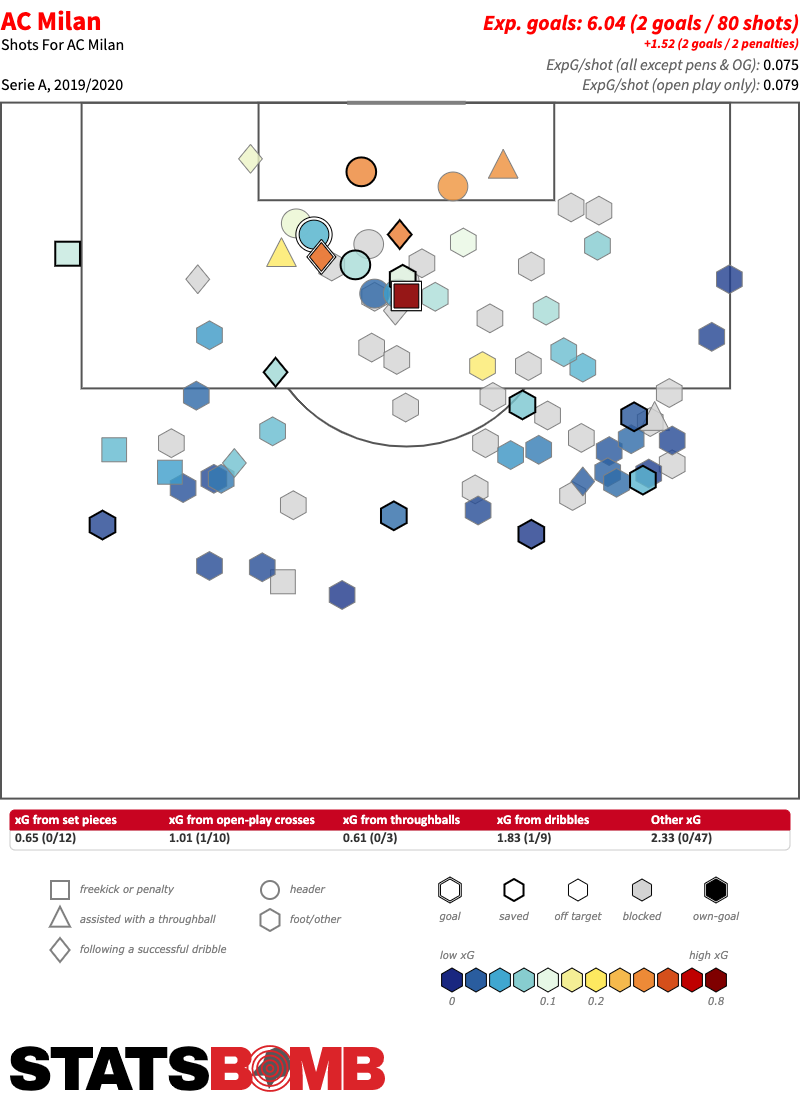 Not only have they generated just 1.00 xG on average (13th in the league), but they have not been able to convert their chances at a rate not even remotely acceptable, having scored only two open play goals, the worst figure in the entire Serie A. They are below league average in every main offensive stat, so of course their attacking radar looks ugly.
Not only have they generated just 1.00 xG on average (13th in the league), but they have not been able to convert their chances at a rate not even remotely acceptable, having scored only two open play goals, the worst figure in the entire Serie A. They are below league average in every main offensive stat, so of course their attacking radar looks ugly. 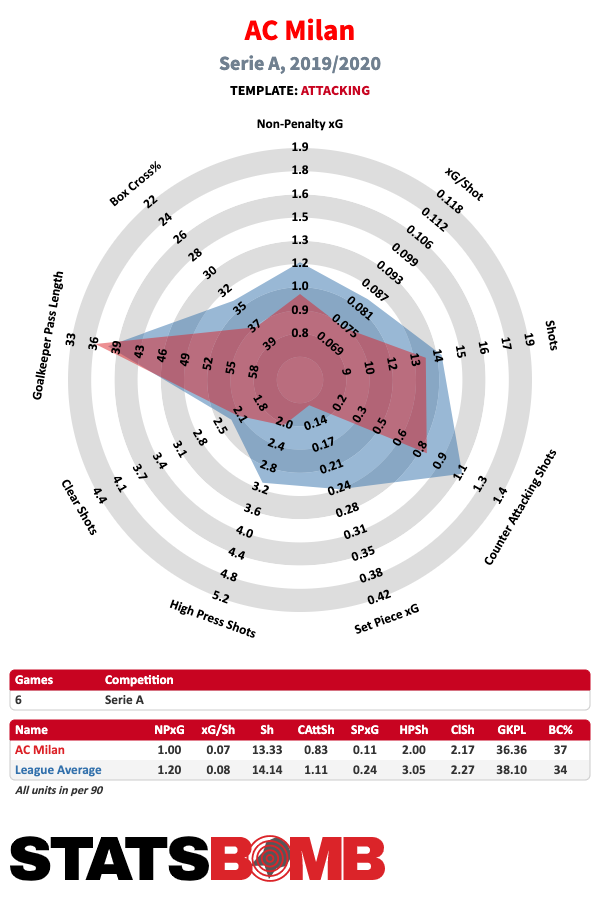 In a situation where the team has a hard time scoring, it's normal for the starting striker to become the target of criticism. Krzysztof Piątek is responsible for 35% of Milan's total xG (2.11 out of a total of 6.04 xG), but he's still on the hunt for his first open play goal. An xG overperformer in 2018-2019 (his scoring efficiency was ~146%), the average quality of his shots this season (0.111) is much lower than that of the 1459 minutes played with AC Milan jersey last season (0.152), but in line with that of his amazing period at Genoa (0.102), in which he scored at will but with a rate well beyond expectations.
In a situation where the team has a hard time scoring, it's normal for the starting striker to become the target of criticism. Krzysztof Piątek is responsible for 35% of Milan's total xG (2.11 out of a total of 6.04 xG), but he's still on the hunt for his first open play goal. An xG overperformer in 2018-2019 (his scoring efficiency was ~146%), the average quality of his shots this season (0.111) is much lower than that of the 1459 minutes played with AC Milan jersey last season (0.152), but in line with that of his amazing period at Genoa (0.102), in which he scored at will but with a rate well beyond expectations. 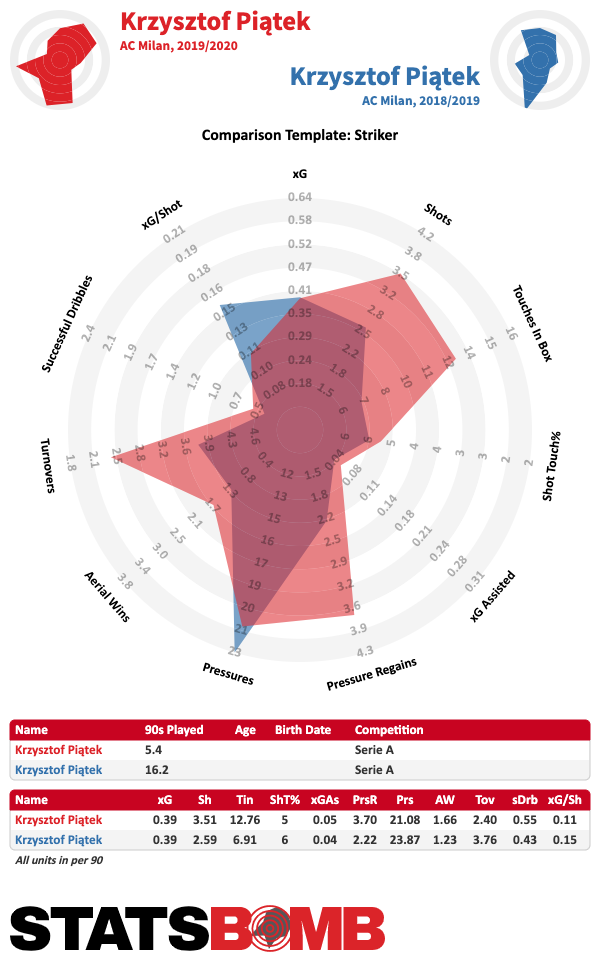 In general, if you look at his data, he's shooting more, touching twice as many balls in the box and losing the ball less than during his first six months with the Rossoneri. But are we sure that he will ever stand out as a lone striker in a system of play that doesn't capitalize on his strengths? Piatek is a poacher. His greatest ability is scoring goals. When he doesn't score, though, his limitations emerge more clearly. His overall contribution to team play is not consistent and even if he doesn't lose too many balls, he's not particularly effective with his back to the goal (his percentage of completed passes decreases by 12% when he is pressed) or at playing wall-passes, which are pivotal to ball progression in Giampaolo’s system. He doesn’t create scoring chances for his team-mates (0.05 open play xG assisted per 90 minutes this season, 0.04 last season) and not even for himself, given that he rarely manages to dribble his direct opponent (0.55 successful dribbles per 90 this season, 0.43 last season). Since Piatek can't be expected to create opportunities, it's the players around him who have to do it. In this sense, there were high expectations for Suso. Throughout the summer it was discussed whether the Spaniard could prove to be the right player to play as the trequartista in Giampaolo's 4-3-1-2. So far, the answer on the pitch seems to be negative, so much so that the Milan coach has given up deploying Suso in that role, choosing instead a 4-3-3 in the last few games. Suso plays 1.74 open-play key passes per 90, more than any teammate with at least 300 minutes played, but his contribution in terms of xG assisted is at 0.17 per 90. That's not really what you expect for your main creator. Moreover, his attacking danger is limited to the few chances he creates, since he generated only 0.09 xG per 90 from over two shots on average because of the highly questionable shooting selection that has characterized his career. Suso is a player who has a reluctance to use both feet and who tends to be predictable: he seemed lost away from the right flank and Giampaolo immediately had to move him back in his natural position. A bit like Piatek, he seems not very functional to the new football project and he has already become a walking tactical conundrum in Milanello. In theory, along with goalkeeper Gianluigi Donnarumma, the Spaniard was the most valuable asset on the roster and since at least on paper his compatibility with football ideas of the new coach (despite the statements of Giampaolo himself) was limited, he could have been sacrificed on the transfer market to finance the signings of different kind of players. But apparently it was his new manager’s decision to keep him, so now it is also his problem to solve. And it’s a problem that needs to be solved fast, considering that the team's midfield isn't exactly showing any signs of brilliance either. Milan’s offensive structure is often disconnected and there are limited options for progressive passes and a lack of players between the lines to receive the ball. Although there is almost no difference between the average number of carries of Hakan Calhanoglu and Franck Kessié and the midfielders of Sampdoria last season, the eye test tends to suggest that the two keep the ball too much (and indeed their carries are 13.5% longer on average) and distribute it with too much laziness, giving the opponents time to take sides on the pitch or, worse, to recover the ball, as happened on the occasion of two of the three goals for Fiorentina, both created by the Turkish player's turnovers. Below you can see the map of their open play passing combined and see how it is full of horizontal passes while also lacking penetration in central zones.
In general, if you look at his data, he's shooting more, touching twice as many balls in the box and losing the ball less than during his first six months with the Rossoneri. But are we sure that he will ever stand out as a lone striker in a system of play that doesn't capitalize on his strengths? Piatek is a poacher. His greatest ability is scoring goals. When he doesn't score, though, his limitations emerge more clearly. His overall contribution to team play is not consistent and even if he doesn't lose too many balls, he's not particularly effective with his back to the goal (his percentage of completed passes decreases by 12% when he is pressed) or at playing wall-passes, which are pivotal to ball progression in Giampaolo’s system. He doesn’t create scoring chances for his team-mates (0.05 open play xG assisted per 90 minutes this season, 0.04 last season) and not even for himself, given that he rarely manages to dribble his direct opponent (0.55 successful dribbles per 90 this season, 0.43 last season). Since Piatek can't be expected to create opportunities, it's the players around him who have to do it. In this sense, there were high expectations for Suso. Throughout the summer it was discussed whether the Spaniard could prove to be the right player to play as the trequartista in Giampaolo's 4-3-1-2. So far, the answer on the pitch seems to be negative, so much so that the Milan coach has given up deploying Suso in that role, choosing instead a 4-3-3 in the last few games. Suso plays 1.74 open-play key passes per 90, more than any teammate with at least 300 minutes played, but his contribution in terms of xG assisted is at 0.17 per 90. That's not really what you expect for your main creator. Moreover, his attacking danger is limited to the few chances he creates, since he generated only 0.09 xG per 90 from over two shots on average because of the highly questionable shooting selection that has characterized his career. Suso is a player who has a reluctance to use both feet and who tends to be predictable: he seemed lost away from the right flank and Giampaolo immediately had to move him back in his natural position. A bit like Piatek, he seems not very functional to the new football project and he has already become a walking tactical conundrum in Milanello. In theory, along with goalkeeper Gianluigi Donnarumma, the Spaniard was the most valuable asset on the roster and since at least on paper his compatibility with football ideas of the new coach (despite the statements of Giampaolo himself) was limited, he could have been sacrificed on the transfer market to finance the signings of different kind of players. But apparently it was his new manager’s decision to keep him, so now it is also his problem to solve. And it’s a problem that needs to be solved fast, considering that the team's midfield isn't exactly showing any signs of brilliance either. Milan’s offensive structure is often disconnected and there are limited options for progressive passes and a lack of players between the lines to receive the ball. Although there is almost no difference between the average number of carries of Hakan Calhanoglu and Franck Kessié and the midfielders of Sampdoria last season, the eye test tends to suggest that the two keep the ball too much (and indeed their carries are 13.5% longer on average) and distribute it with too much laziness, giving the opponents time to take sides on the pitch or, worse, to recover the ball, as happened on the occasion of two of the three goals for Fiorentina, both created by the Turkish player's turnovers. Below you can see the map of their open play passing combined and see how it is full of horizontal passes while also lacking penetration in central zones. 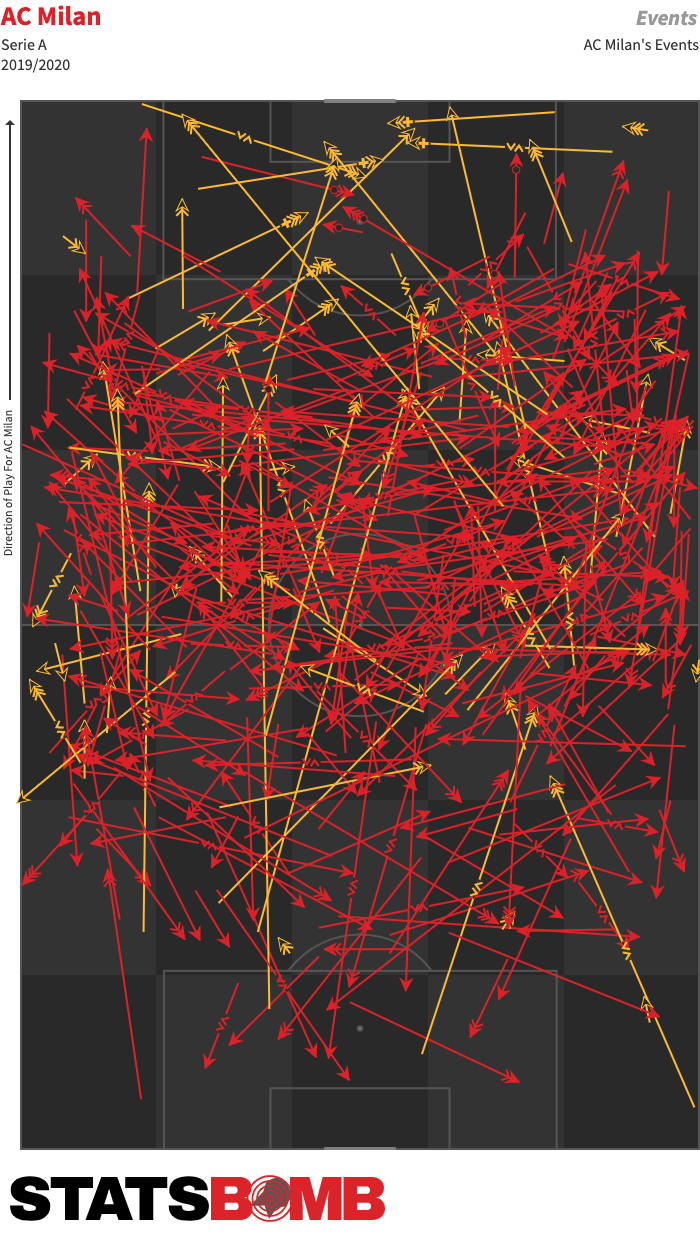 There aren’t many more alternatives in midfield and unless Giampaolo plays Lucas Paquetá, who could also be a good trequartista if the team went back to a 4-3-1-2, there is not much room to twist the line-up in these roles and we will likely see the same midfield in the coming games, too. Surely Ismael Bennacer, who seems to have now surpassed Lucas Biglia, AC Milan’s oldest player at 34, as the starting holding midfielder, seems to be able to bring more incisiveness to the passing game of Milan, although the match with Fiorentina was a disaster for him because of the two penalties he caused.
There aren’t many more alternatives in midfield and unless Giampaolo plays Lucas Paquetá, who could also be a good trequartista if the team went back to a 4-3-1-2, there is not much room to twist the line-up in these roles and we will likely see the same midfield in the coming games, too. Surely Ismael Bennacer, who seems to have now surpassed Lucas Biglia, AC Milan’s oldest player at 34, as the starting holding midfielder, seems to be able to bring more incisiveness to the passing game of Milan, although the match with Fiorentina was a disaster for him because of the two penalties he caused. 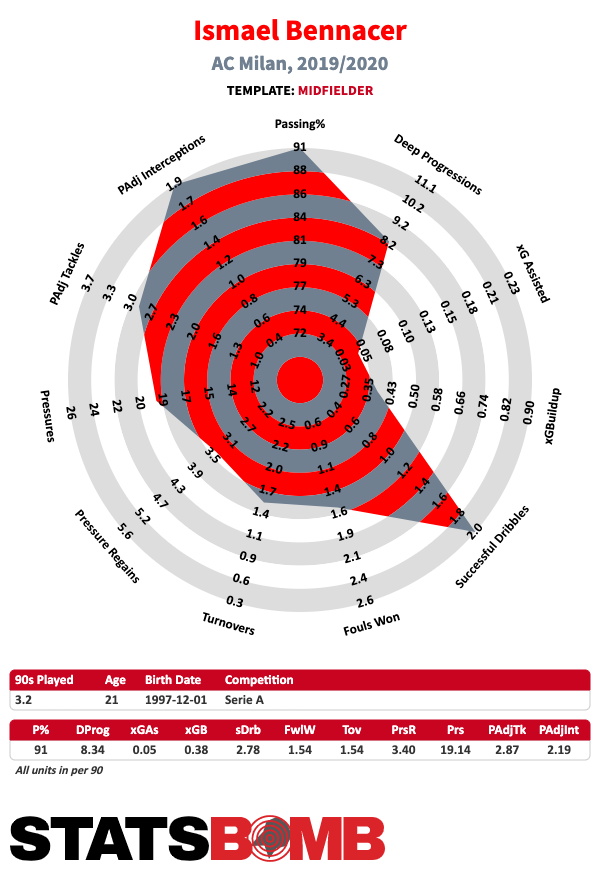 Speaking of new signings, Rafael Leao is definitely worthy of a starting spot and the Portuguese could be, at least in part, the solution to Milan's problems. So far the 20-year-old, who scored 0.53 non-penalty goals per 90 for Lille last season, has played mainly on the left wing, but he has the off-the-ball moves, the strength, and the smartness to play with his back to his goal to complement Piatek in a striking partnership or to play as the lone striker. In both cases, unless Suso significantly improves in a central offensive midfielder role, Giampaolo will have to make an important decision and probably put the Spaniard or Piatek on the bench. The Portuguese striker (2.67 dribbles and 2.00 key passes on average, in just 270 minutes) can give that offensive unpredictability that Milan damn well needs while the team adapts to the new brand of football. Focus on what Leao does before the goal here: shielding the ball with his back to the goal, passing it to a team-mate to gain territory and offering a passing option toward the inside of the pitch to the wide ball-carrier.
Speaking of new signings, Rafael Leao is definitely worthy of a starting spot and the Portuguese could be, at least in part, the solution to Milan's problems. So far the 20-year-old, who scored 0.53 non-penalty goals per 90 for Lille last season, has played mainly on the left wing, but he has the off-the-ball moves, the strength, and the smartness to play with his back to his goal to complement Piatek in a striking partnership or to play as the lone striker. In both cases, unless Suso significantly improves in a central offensive midfielder role, Giampaolo will have to make an important decision and probably put the Spaniard or Piatek on the bench. The Portuguese striker (2.67 dribbles and 2.00 key passes on average, in just 270 minutes) can give that offensive unpredictability that Milan damn well needs while the team adapts to the new brand of football. Focus on what Leao does before the goal here: shielding the ball with his back to the goal, passing it to a team-mate to gain territory and offering a passing option toward the inside of the pitch to the wide ball-carrier. 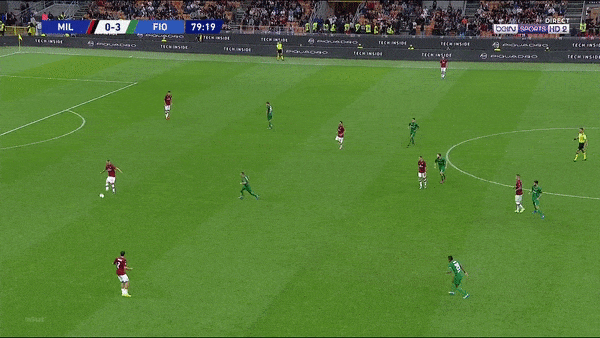 The same goes for left-winger Ante Rebic, who has so far played just 82 minutes overall and could find more space in a different configuration. The Croatian is a player who takes risks, which is something that for now his teammates don't do, knows how to overtake his direct opponent and is also able to offer a good scoring contribution for a wide player. The under fire ex-Sampdoria manager has to earn himself time and Leao and Rebic could give it to him.
The same goes for left-winger Ante Rebic, who has so far played just 82 minutes overall and could find more space in a different configuration. The Croatian is a player who takes risks, which is something that for now his teammates don't do, knows how to overtake his direct opponent and is also able to offer a good scoring contribution for a wide player. The under fire ex-Sampdoria manager has to earn himself time and Leao and Rebic could give it to him.
When pressing fails, the defense collapses
In the first three games, the defense had been the main strength of Milan: conceding a single goal, the Rossoneri had managed to earn 6 points out of 9 despite their offensive woes. But it is also true that Udinese (18th for non-penalty xG), Brescia (17th) and Hellas Verona (13th) are among the worst teams in Serie A in terms of offensive production. It was therefore predictable that Milan would suffer more against stronger opponents. In the following three games against Inter, Torino and Fiorentina, Milan suffered 6 open play goals, conceding way more opportunities to their opponents. But, if Giampaolo was expected to make the Rossoneri defend higher up the pitch, you can’t be particularly disappointed. Milan is third in defensive distance and fourth in passes per defensive action (PPDA), two indexes of a team that brings relatively high and aggressive pressure. Among other positive notes, they are the team with the second most counterpressure actions (232) and they also conceded the least deep completions in the league (just two on average). 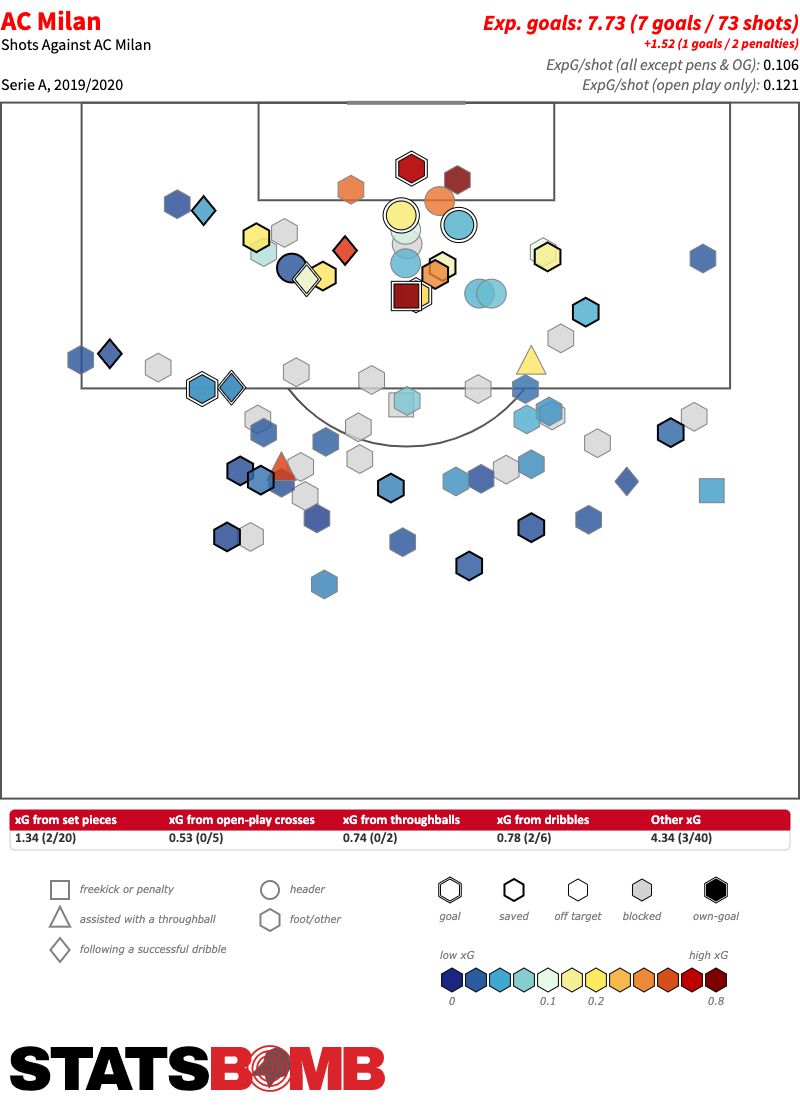 The main defensive problem is the high average value of opponents' chances. AC Milan concedes open-play shots with an average xG of 0.12, a sign that when the pressing fails (and we saw it well in games against Torino, Inter and Fiorentina) there are too many spaces in which to build high-scoring opportunities. Pressing requires well-oiled mechanisms that develop over time, but when those processes fail, Milan is far too vulnerable and there is too much space to cover for defensive players. That situation puts a strain on the center backs, who are often forced to face their opponents one on one in critical situations. Romagnoli, who last year was the best defender in the league in percentage of tackles compared to times dribbled pass (87%), is now dribbled 44% of the time that he attempts a tackle, while the percentage rises to 56% for the other defender Musacchio. You don't become a pressing defensive force in a month, but again since they aren't scoring, there's no cushion compensate for those goals conceded due to growing pains.
The main defensive problem is the high average value of opponents' chances. AC Milan concedes open-play shots with an average xG of 0.12, a sign that when the pressing fails (and we saw it well in games against Torino, Inter and Fiorentina) there are too many spaces in which to build high-scoring opportunities. Pressing requires well-oiled mechanisms that develop over time, but when those processes fail, Milan is far too vulnerable and there is too much space to cover for defensive players. That situation puts a strain on the center backs, who are often forced to face their opponents one on one in critical situations. Romagnoli, who last year was the best defender in the league in percentage of tackles compared to times dribbled pass (87%), is now dribbled 44% of the time that he attempts a tackle, while the percentage rises to 56% for the other defender Musacchio. You don't become a pressing defensive force in a month, but again since they aren't scoring, there's no cushion compensate for those goals conceded due to growing pains.
Conclusion
It seems absurd after only six games, but the new Milan project is already hanging by a thread. Changing the sixth coach in five years now would probably be a mistake, since at least in the first half against Torino we saw what the team is capable of, but this group is still too far behind and the problems are not just about learning the new system. It's time for Giampaolo to take important choices before the management takes them about his future.
The Bundesliga's newest members will all struggle to avoid relegation this season
With the Bundesliga having three newly promoted teams - 1. FC Köln, SC Paderborn, and Union Berlin; the latter enjoying their first season in Germany’s top flight in club history - there must be a surprise squad among the newcomers, right? Of course, no RB Leipzig-esque scenario is likely. None of these three teams has the financial striking power and grandiose club infrastructure of the energy drink-fueled footballing factory of Die Roten Bullen. But a post-promotion season like Fortuna Düsseldorf enjoyed last year, with a solid league finish in tenth place, with surprise victories against big teams like Borussia Dortmund and Schalke, should be possible for one of these three promoted teams - considering the tiny margins between the mid-tier teams and relegation-battling squads in the Bundesliga in recent years. Er, not so much. Even though Union Berlin recorded a truly remarkable upset-win over Dortmund on matchday three, the league standings after six games played are rough. Big time. The three promoted teams can be found in the four bottom spots, with a combined record of two wins, three draws and thirteen defeats. So… Are Paderborn, Union and Köln all doomed? Are the three newcomers early-season locks for the two relegation and one play-off spot? And even if this is the case, which players seem to have Bundesliga staying power? Let’s take a look.
Union Berlin
It’s hard not to fall a teeny-tiny bit in love with Die Eisernen, ‘The Iron Ones’ - glorious nickname: check. Union play their home games at the also very gloriously named Stadion An der Alten Försterei (Stadium by the Old Forester’s House), which shockingly only houses 22.000 fans - even though the stadium noise easily rivals that of your average fifty-thousand-seater. There’s a real liveliness to the East-Berlin club and its surroundings. After a false start against RB Leipzig (0-4 thrashing), Union showed against Dortmund that in their own home, they can supercede their individual talent level, and make life pretty tough for superior opponents with a very direct, counterattacking playing style, well-worked set pieces, and a lot of intensity in their defensive teamwork. But the 3-1 stunner against Die Borussen has been the sole highlight so far: Union has only grabbed one point from the other five league games, and its defense just doesn’t look good enough to compensate for the lack of individual star power on the ball.  In the last match, a deserved 1-2 home loss against Eintracht Frankfurt, manager Urs Fischer swapped in defensively-minded midfielder Manuel Schmiedebach for one of the strikers, with Union switching their 4-4-2 formation into a more solid 4-1-4-1. But even with this conservative adjustment, the defensive issue remained the same for Union: they have trouble pressing the build-up of their opponents at the highest level, with opposing teams finding the final third with frightening ease.
In the last match, a deserved 1-2 home loss against Eintracht Frankfurt, manager Urs Fischer swapped in defensively-minded midfielder Manuel Schmiedebach for one of the strikers, with Union switching their 4-4-2 formation into a more solid 4-1-4-1. But even with this conservative adjustment, the defensive issue remained the same for Union: they have trouble pressing the build-up of their opponents at the highest level, with opposing teams finding the final third with frightening ease. 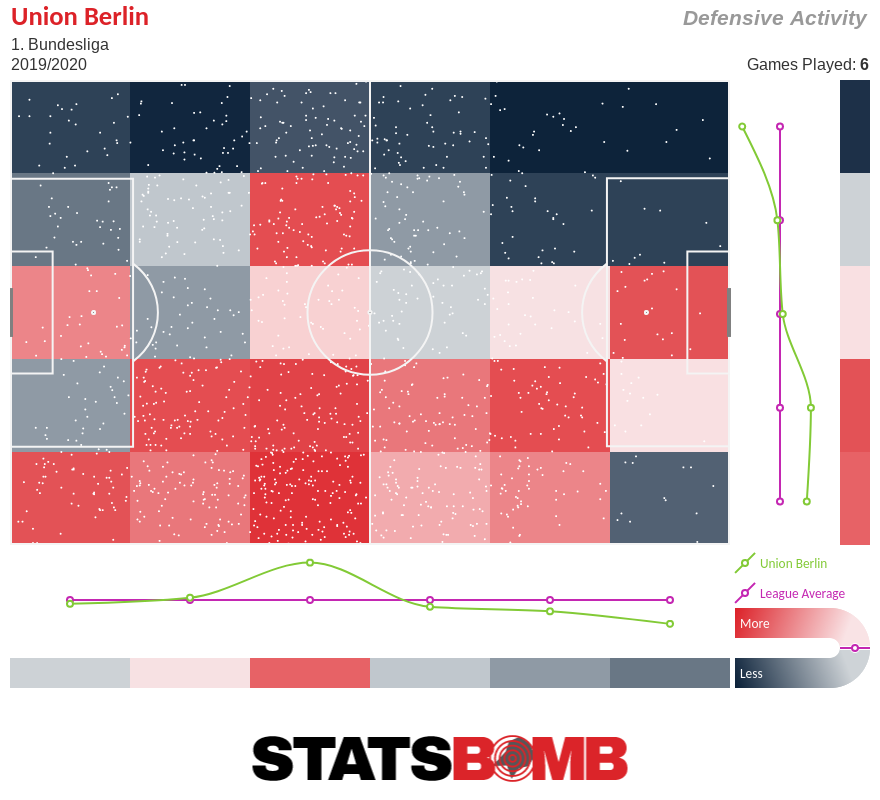 Striker Sebastian Andersson has scored three of Union’s six goals so far, and the 28-year old Swede’s underlying numbers look rather tasty thus far.
Striker Sebastian Andersson has scored three of Union’s six goals so far, and the 28-year old Swede’s underlying numbers look rather tasty thus far. 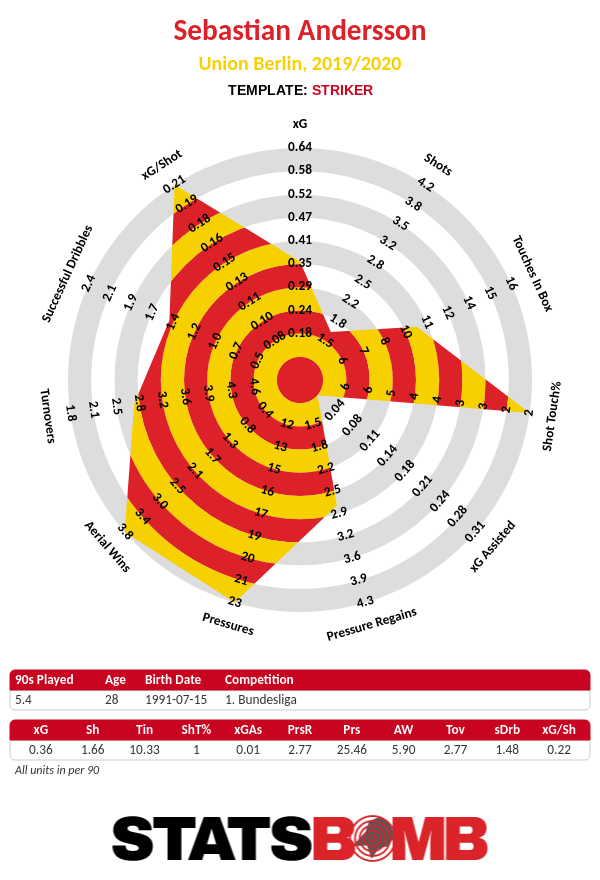 Way-too-early verdict on Union: the team defense looks too vulnerable to give the attack a fighting chance
Way-too-early verdict on Union: the team defense looks too vulnerable to give the attack a fighting chance
1.FC Köln
After a four year stay at the highest level between 2014 and 2018, Die Geissböcke (The Billy Goats - German football clubs know how to do nicknames, folks) did not eff around in the 2. Bundesliga last season, scoring a whopping total of 84 goals in 34 league games, en route to a second-level title. 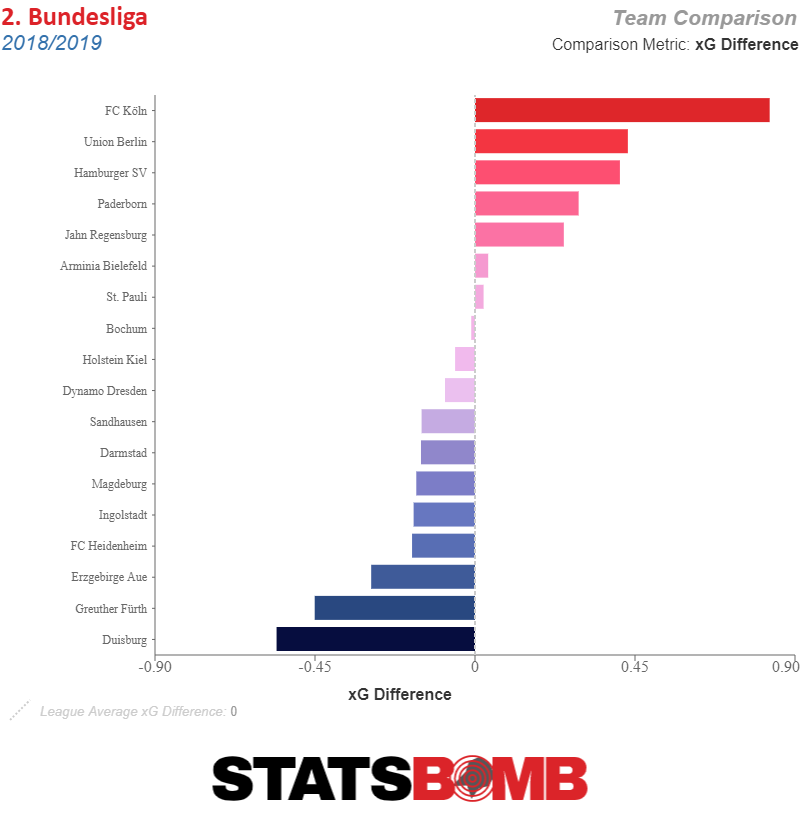 In the Bundesliga this season, not much seems left of Köln’s attacking prowess of last season. New manager Achim Beierlozer has traded in last year’s 3-5-2 formation for a conservative version of Leipzig’s 4-2-2-2 system. Even though the new playing formation also offers spots for two strikers, there seems to be no significant role carved out for Simon Terodde. The 31-year old goal scorer netted 29 times in last year’s 2. Bundesliga campaign, scoring once every 85 minutes. But, Terodde seems to have suffered the same fate as he did at VfB Stuttgart in 2017, getting marginalized because there’s just no room for the somewhat immobile striker in the relegation-fighting starting squad, a year after finishing as the second-tier topscorer. Beierlozer prefers the physical duo of Anthony Modeste and Jhon Cordóba up top, in an effort to combine the team’s high-pressing style in defense with a direct, long ball-oriented approach in possession.
In the Bundesliga this season, not much seems left of Köln’s attacking prowess of last season. New manager Achim Beierlozer has traded in last year’s 3-5-2 formation for a conservative version of Leipzig’s 4-2-2-2 system. Even though the new playing formation also offers spots for two strikers, there seems to be no significant role carved out for Simon Terodde. The 31-year old goal scorer netted 29 times in last year’s 2. Bundesliga campaign, scoring once every 85 minutes. But, Terodde seems to have suffered the same fate as he did at VfB Stuttgart in 2017, getting marginalized because there’s just no room for the somewhat immobile striker in the relegation-fighting starting squad, a year after finishing as the second-tier topscorer. Beierlozer prefers the physical duo of Anthony Modeste and Jhon Cordóba up top, in an effort to combine the team’s high-pressing style in defense with a direct, long ball-oriented approach in possession.  As you can see in the plot above, Köln have had a lot of trouble with creating a credible semblance of offense. In fact, they haven't managed to accrue more than one xG in a match since the opening game of the season when they brought home a whopping 1.01. With left-back Jonas Hector and goalie Timo Horn, Köln still have two established club stars. Somewhat pricey summer signing Ellyes Skhiri also seems to possess the qualities to enter this elite category sooner rather than later. The Tunisian 24-year old has displayed the same nice mix of passing range and ball-winning skills that earned him a 6 million euro transfer at Montpellier in Ligue 1 last year. Skhiri is also the player most responsible for Köln’s sole win this season, at Freiburg. He provided a deft assist to Anthony Modeste for the tying score with an in-swinging cross, and lashed home the 1-2 in stoppage time after a long dribble.
As you can see in the plot above, Köln have had a lot of trouble with creating a credible semblance of offense. In fact, they haven't managed to accrue more than one xG in a match since the opening game of the season when they brought home a whopping 1.01. With left-back Jonas Hector and goalie Timo Horn, Köln still have two established club stars. Somewhat pricey summer signing Ellyes Skhiri also seems to possess the qualities to enter this elite category sooner rather than later. The Tunisian 24-year old has displayed the same nice mix of passing range and ball-winning skills that earned him a 6 million euro transfer at Montpellier in Ligue 1 last year. Skhiri is also the player most responsible for Köln’s sole win this season, at Freiburg. He provided a deft assist to Anthony Modeste for the tying score with an in-swinging cross, and lashed home the 1-2 in stoppage time after a long dribble. 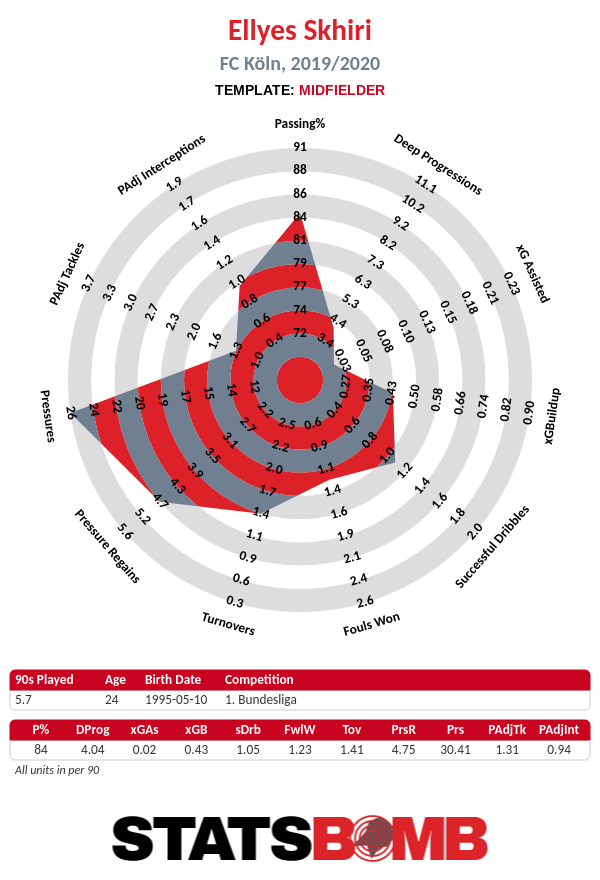 Way-too-early verdict on Köln: if they find some form of attacking punch, they should survive
Way-too-early verdict on Köln: if they find some form of attacking punch, they should survive
SC Paderborn 07
Admittedly, Paderborn’s Benteler-Arena truly looks like the most unimaginative off-brand stadium in each edition of FIFA. But I can personally vouch for the Paderborn-experience - a result of my very football hipster-esque hobby of visiting lower-tier German teams at the end of each summer on trips with my dad. Paderborn meets all the high standards for stadium beer, bratwurst and all-around friendliness that Bundesliga teams have to meet - seriously, go visit Bundesliga (or lower league) games when in Germany, y’all; it generally ends up being a delightful experience. Me sacrificing an entire paragraph to defending the cuisine and ambiance of its starter pack stadium, kind of gives you a hint what I think of their chances of staying up this year. In attack, Paderborn have been really decent. 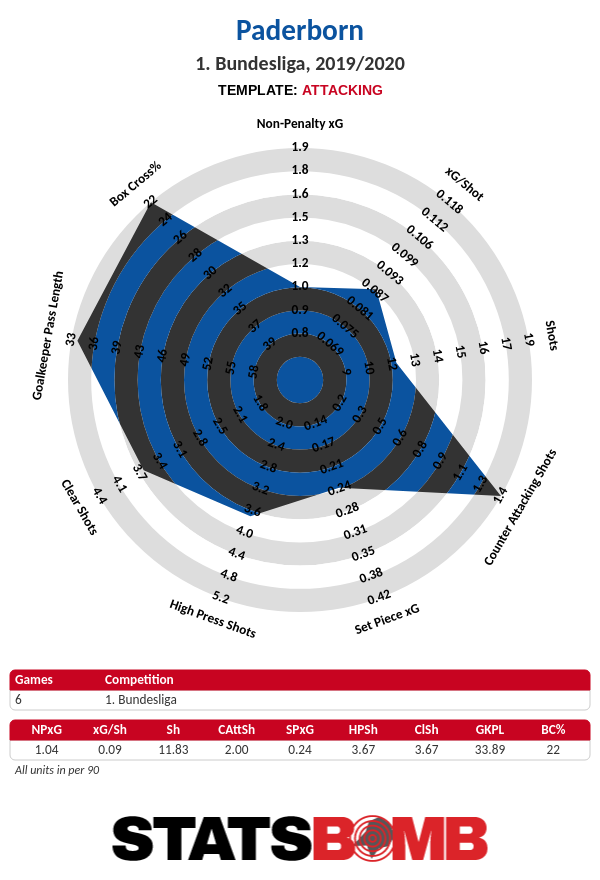 But a cash-strapped underdog has to be able to prevent opposing offenses to some extent to have a form of staying-power in a top league. And even though Paderborn employ a pretty, zippy counter-attacking playing style, with two fast strikers and two pacey wingers in a 4-4-2 formation which lends itself to brave efforts in pressing opposing build-ups, their defensive output after the pressing stages simply doesn’t look worthy of the Bundesliga. Paderborn have only limited one opponent to one goal thus far (Wolfsburg, 1-1), and have a paltry goal difference of 1-6 after the seventieth minute, when their attackers have been worn out by all their hard work chasing down opposing build-up play.
But a cash-strapped underdog has to be able to prevent opposing offenses to some extent to have a form of staying-power in a top league. And even though Paderborn employ a pretty, zippy counter-attacking playing style, with two fast strikers and two pacey wingers in a 4-4-2 formation which lends itself to brave efforts in pressing opposing build-ups, their defensive output after the pressing stages simply doesn’t look worthy of the Bundesliga. Paderborn have only limited one opponent to one goal thus far (Wolfsburg, 1-1), and have a paltry goal difference of 1-6 after the seventieth minute, when their attackers have been worn out by all their hard work chasing down opposing build-up play.  Despite being willing defensive workers, when the team gets broken down, they REALLY get broken down. Paderborn are by far and away the worst team in the league when it comes to the average xG/shot conceded.
Despite being willing defensive workers, when the team gets broken down, they REALLY get broken down. Paderborn are by far and away the worst team in the league when it comes to the average xG/shot conceded. 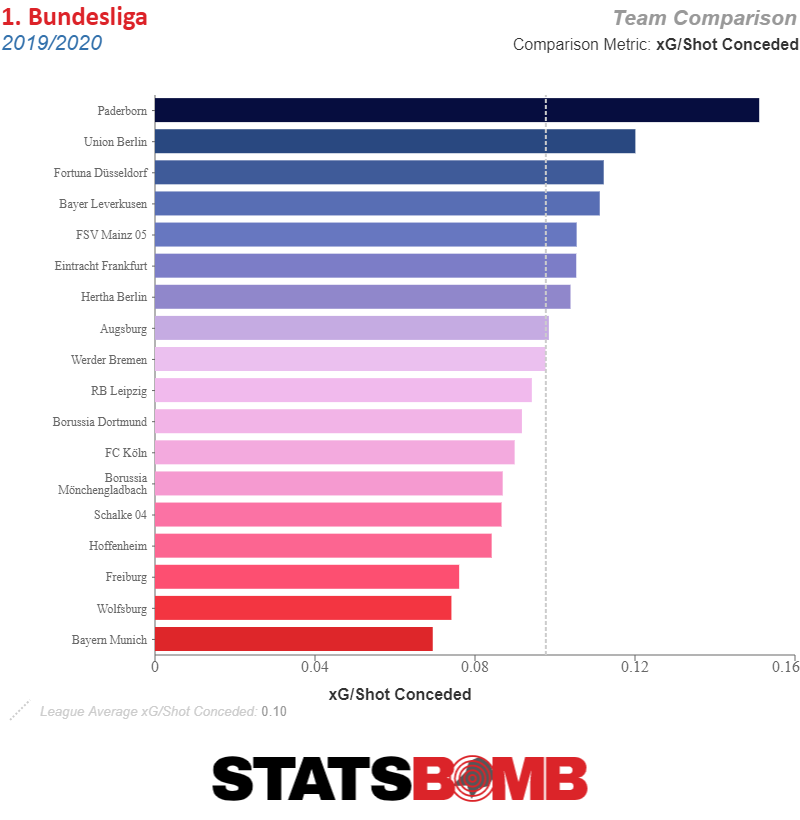 On the bright side, Paderborn do have Jamilu Collins who scored an absolute belter of a goal last weekend against Bayern
On the bright side, Paderborn do have Jamilu Collins who scored an absolute belter of a goal last weekend against Bayern 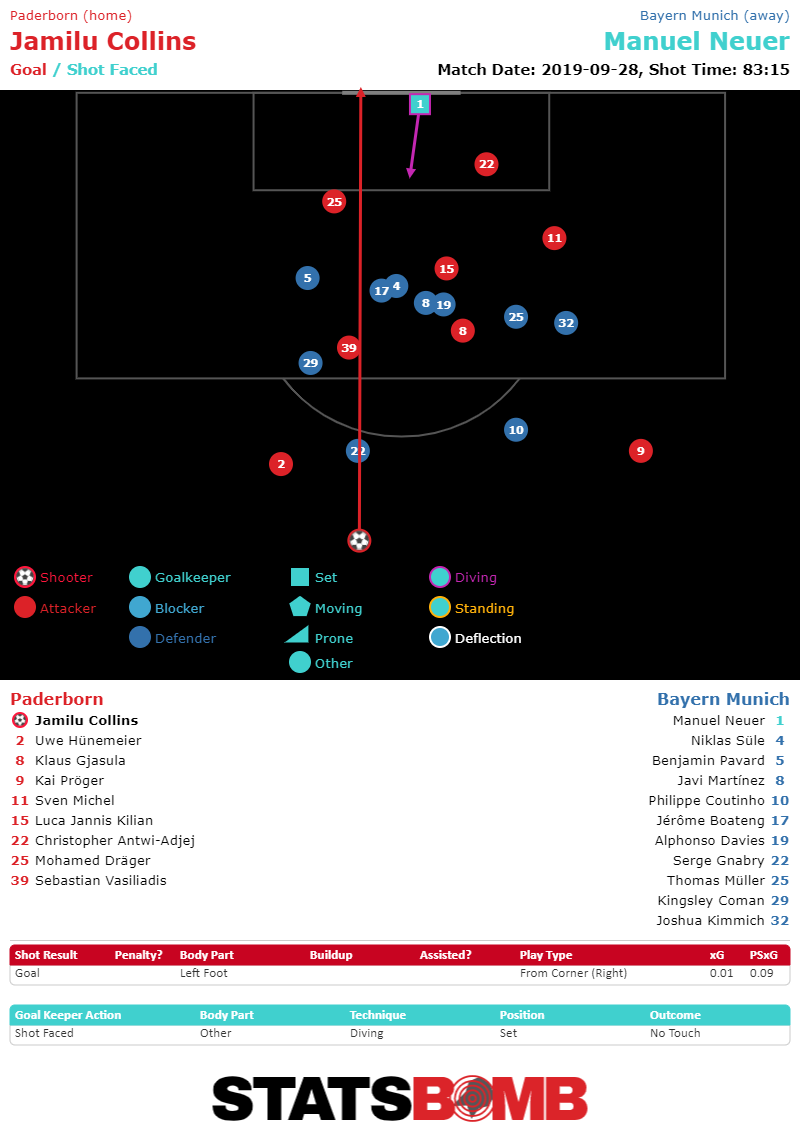 Seriously, look it up.Bbut the Nigerian left-back has done more than score one wonder goal to impress the scouts. Paderborn signed Collins as a free agent in 2017, after he had been toiling in anonymity in the Croatian league for five seasons. At the age of 25, Collins seems to be a very intriguing prospect for mid-tier clubs in top leagues who are looking for a wing back on the left flank: his speed, stamina, dribbling and crossing all look very good so far. Even if Paderborn drop down at the end of this season, they will make a hefty profit when they sell Collins.
Seriously, look it up.Bbut the Nigerian left-back has done more than score one wonder goal to impress the scouts. Paderborn signed Collins as a free agent in 2017, after he had been toiling in anonymity in the Croatian league for five seasons. At the age of 25, Collins seems to be a very intriguing prospect for mid-tier clubs in top leagues who are looking for a wing back on the left flank: his speed, stamina, dribbling and crossing all look very good so far. Even if Paderborn drop down at the end of this season, they will make a hefty profit when they sell Collins. 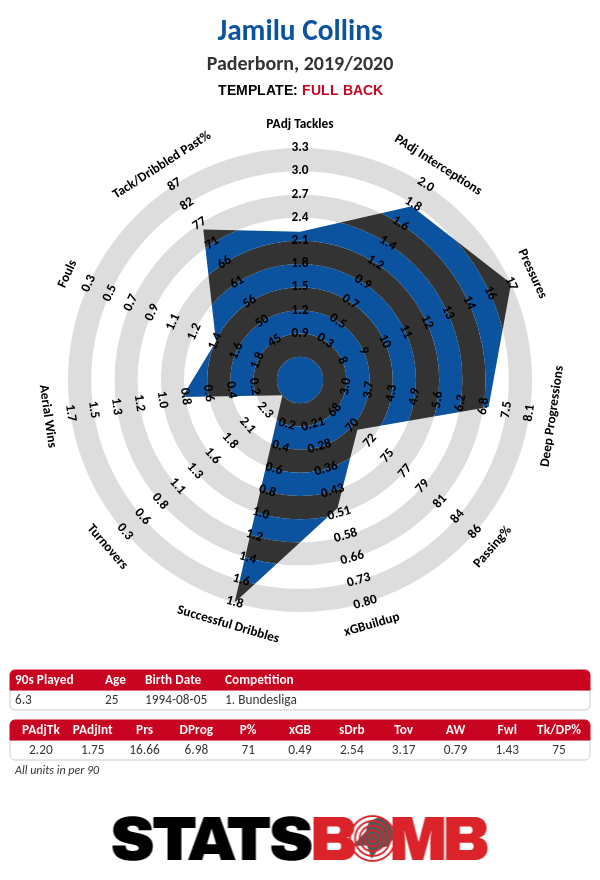 Way-too-early verdict on Paderborn: the attack is entertaining, but if that defense doesn't grow a spine it won't matter
Way-too-early verdict on Paderborn: the attack is entertaining, but if that defense doesn't grow a spine it won't matter
Villarreal’s revitalized attack is the key to their return to form
Villarreal have been one of the most entertaining teams during the early running in La Liga and look to have an attack capable of powering them into European contention. Last season was dominated by relegation concerns but ambitions are much higher this time around. After good work in the transfer market to address problem areas in the squad, Villarreal have made a solid start to the new campaign. Seven matches in, Javi Calleja’s side are eighth in the table, with 11 points from three wins, two draws and two defeats. Their underlying numbers look even better. Villarreal have the second-best expected goal (xG) difference in the league, at 0.59 per match, and have achieved that despite having already faced Real Madrid at home (2-2) and Barcelona away (1-2). It is a better xG difference than they’ve carried through any seven-match stretch over the last couple of seasons. The attack is carrying most of the weight. At a top-line level, they’ve scored 18 goals, the most in the league and their best-ever total at this stage of a season. While that has undoubtedly been boosted by winning and converting three penalties, at a likely unsustainable rate of 0.43 per match (Getafe’s 2017-18 haul of 0.32 per match is by far the best in either of the last two seasons in La Liga), they are otherwise on solid ground. Their league-leading goal tally is matched to league-leading xG numbers. 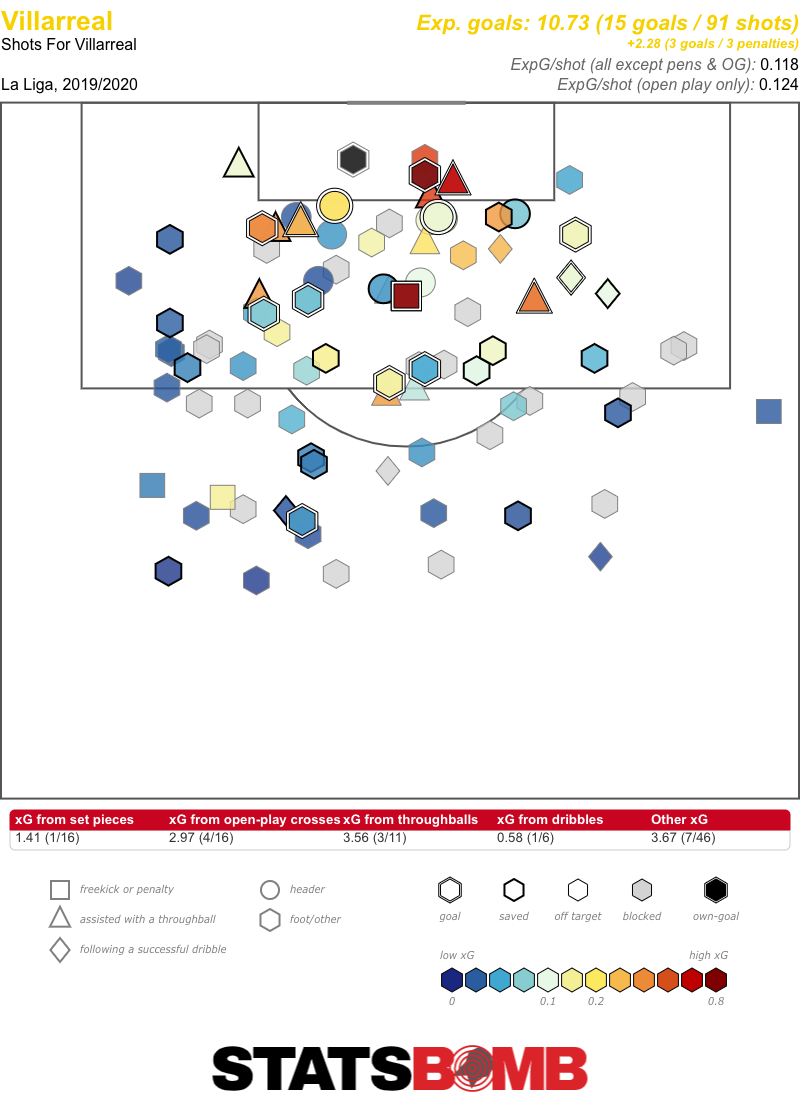 There is a degree of over-performance there, but nothing out of the ordinary given that Villarreal are combining good shot volume (a league-fourth-high 12.86 per match) with very good shot quality (unsurprisingly, Atlético Madrid’s insane early shot quality didn’t hold):
There is a degree of over-performance there, but nothing out of the ordinary given that Villarreal are combining good shot volume (a league-fourth-high 12.86 per match) with very good shot quality (unsurprisingly, Atlético Madrid’s insane early shot quality didn’t hold): 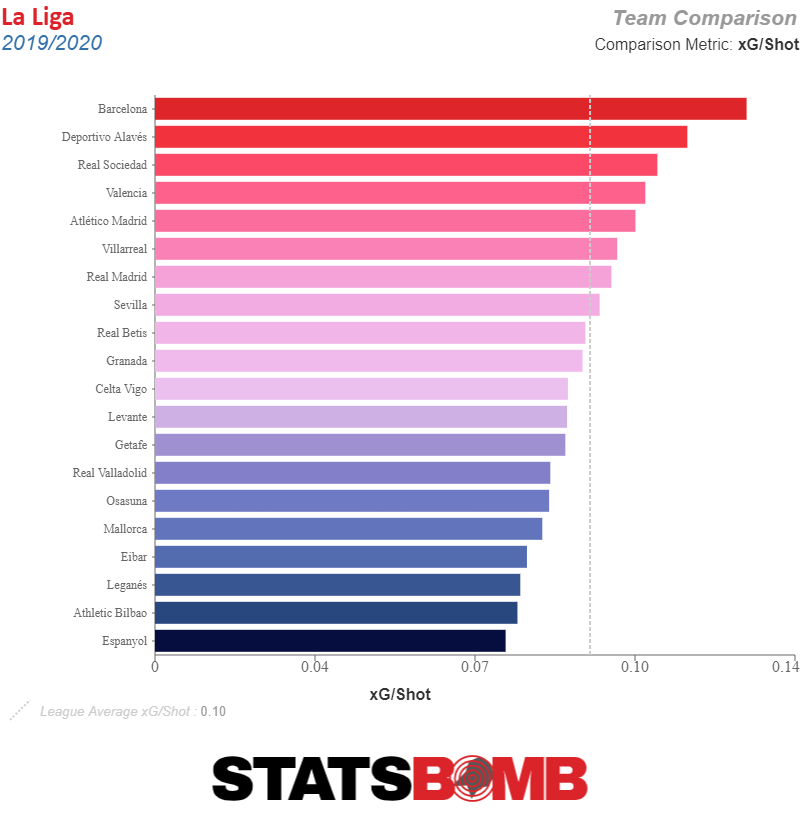 Villarreal’s shot volume is very similar to last season, but that increased shot quality (from 0.09 xG/shot to 0.12xG) is being achieved by doing a better job of creating situations in which their collection of rapid and incisive forwards can profit. They are playing out shorter from the back than they did last season, pulling opponents out of position as they work the ball neatly forward, and they are also creating a lot of chances in transition: they are second in the league in terms of shots arising from both counter-attacks and high press situations. Gerard Moreno has been the primary beneficiary to date. After a down season last time out in which he scored just eight non-penalty goals, he is making a strong case for a national-team call up with six non-penalty goals and one assist (off a combined 5.35 xG and xG assisted) to date. But the variety of attacking options available to Calleja means that plenty of forwards are chipping in. Karl Toko Ekambi, Moi Gómez and Samuel Chukwueze each have two goals apiece. Summer signing Javi Ontiveros has a goal and an assist. Carlos Bacca is yet to score but has acted as a more fixed central reference point when required. There is plenty of flexibility there. Calleja has switched between 4-4-2, 4-1-4-1, 4-2-3-1 and 4-3-3 formations this season, and has often done so in-game. Moreno and Toko Ekambi (his hilariously bad flipped crosses aside) can do functional jobs from wide starting positions, while Chukwueze and Ontiveros are capable of terrorising tiring defences with their swift and direct dribbling when called from off the bench. In Villarreal’s 5-1 win over Real Betis on Friday, the introduction of Chukwueze changed the game. He won the penalty from which they edged ahead at 2-1, found Moreno on the counter that led to the third goal, scored by Toko Ekambi, and then scored the fifth himself, receiving past a challenge, carrying the ball down the flank and then darting into the area to aim an accurate shot off the inside of the post and in.
Villarreal’s shot volume is very similar to last season, but that increased shot quality (from 0.09 xG/shot to 0.12xG) is being achieved by doing a better job of creating situations in which their collection of rapid and incisive forwards can profit. They are playing out shorter from the back than they did last season, pulling opponents out of position as they work the ball neatly forward, and they are also creating a lot of chances in transition: they are second in the league in terms of shots arising from both counter-attacks and high press situations. Gerard Moreno has been the primary beneficiary to date. After a down season last time out in which he scored just eight non-penalty goals, he is making a strong case for a national-team call up with six non-penalty goals and one assist (off a combined 5.35 xG and xG assisted) to date. But the variety of attacking options available to Calleja means that plenty of forwards are chipping in. Karl Toko Ekambi, Moi Gómez and Samuel Chukwueze each have two goals apiece. Summer signing Javi Ontiveros has a goal and an assist. Carlos Bacca is yet to score but has acted as a more fixed central reference point when required. There is plenty of flexibility there. Calleja has switched between 4-4-2, 4-1-4-1, 4-2-3-1 and 4-3-3 formations this season, and has often done so in-game. Moreno and Toko Ekambi (his hilariously bad flipped crosses aside) can do functional jobs from wide starting positions, while Chukwueze and Ontiveros are capable of terrorising tiring defences with their swift and direct dribbling when called from off the bench. In Villarreal’s 5-1 win over Real Betis on Friday, the introduction of Chukwueze changed the game. He won the penalty from which they edged ahead at 2-1, found Moreno on the counter that led to the third goal, scored by Toko Ekambi, and then scored the fifth himself, receiving past a challenge, carrying the ball down the flank and then darting into the area to aim an accurate shot off the inside of the post and in. 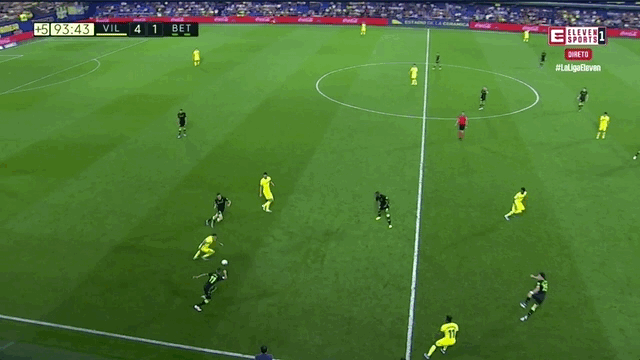 The forwards are getting a quality supply line from Santi Cazorla. Only Lionel Messi provided more assists than him last season, and the former Arsenal midfielder already has three to his name this time around. At 34, and just three years removed from an injury that seemed likely to end his career, they won’t be able to lean on him too heavily throughout the entire campaign, but he links well over towards the left, consistently makes himself available to receive and has the ability to spot and execute defence-splitting passes.
The forwards are getting a quality supply line from Santi Cazorla. Only Lionel Messi provided more assists than him last season, and the former Arsenal midfielder already has three to his name this time around. At 34, and just three years removed from an injury that seemed likely to end his career, they won’t be able to lean on him too heavily throughout the entire campaign, but he links well over towards the left, consistently makes himself available to receive and has the ability to spot and execute defence-splitting passes. 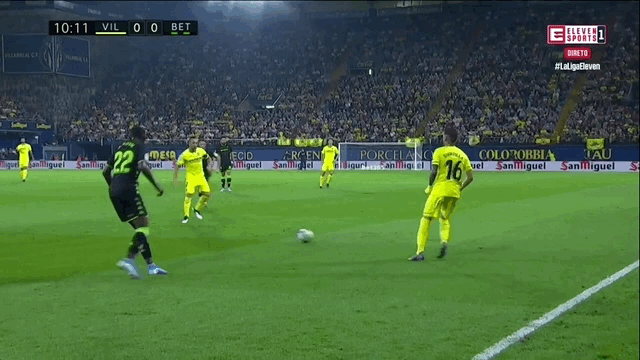 These offensive improvements have been achieved whilst also refining their defensive output. We are still only seven matches in, and much could still change, but Villarreal have so far conceded three less shots per match than last season and have become much better at stopping teams getting off shots in transition and from passes in behind their defence. The result is than their xG conceded per match has dropped from 1.18 last season to 0.91 this.
These offensive improvements have been achieved whilst also refining their defensive output. We are still only seven matches in, and much could still change, but Villarreal have so far conceded three less shots per match than last season and have become much better at stopping teams getting off shots in transition and from passes in behind their defence. The result is than their xG conceded per match has dropped from 1.18 last season to 0.91 this. 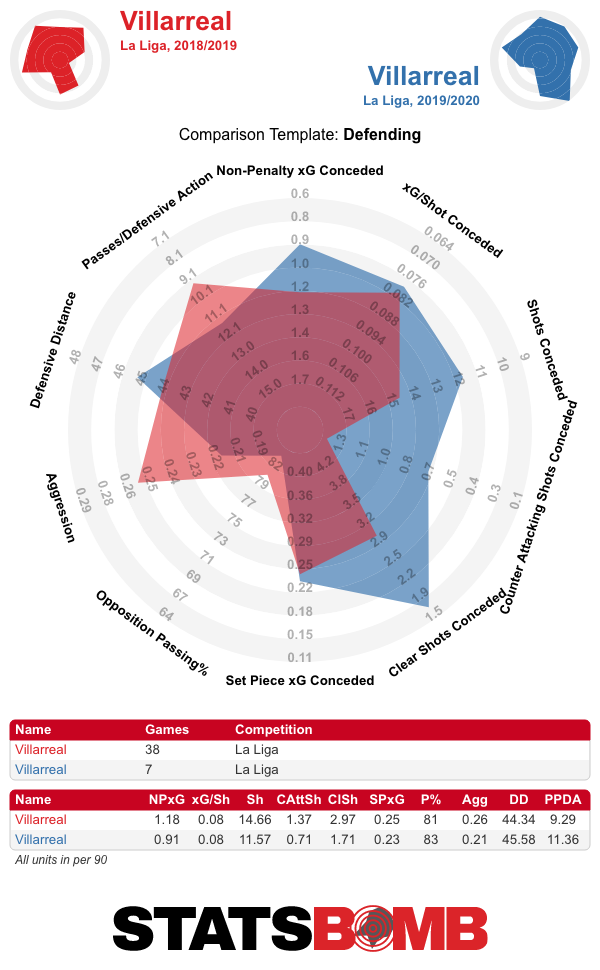 Some of that is down to the better balance they now have in midfield, with Cazorla and Vicente Iborra complemented by summer signing André-Frank Zambo Anguissa. Villarreal were seeking a player capable of adding mobility and physicality without being a minus in possession. Getafe’s Mauro Arambarri was also considered, but it was Zambo Anguissa who was brought in on loan from Fulham. His solid performances there were somewhat disguised by the disastrous collective context. When Cameroon’s coaching staff travelled to watch him in person, they didn’t see any signs of individual regression, and he has fitted in well at Villarreal. The 23-year-old covers the necessary ground in midfield and has also shown himself to be able and often skilled dribbler and ball-carrier. Of all players to have seen over 200 minutes for Villarreal so far this season, only defender Pau Torres has carried the ball further on a per-90 basis.
Some of that is down to the better balance they now have in midfield, with Cazorla and Vicente Iborra complemented by summer signing André-Frank Zambo Anguissa. Villarreal were seeking a player capable of adding mobility and physicality without being a minus in possession. Getafe’s Mauro Arambarri was also considered, but it was Zambo Anguissa who was brought in on loan from Fulham. His solid performances there were somewhat disguised by the disastrous collective context. When Cameroon’s coaching staff travelled to watch him in person, they didn’t see any signs of individual regression, and he has fitted in well at Villarreal. The 23-year-old covers the necessary ground in midfield and has also shown himself to be able and often skilled dribbler and ball-carrier. Of all players to have seen over 200 minutes for Villarreal so far this season, only defender Pau Torres has carried the ball further on a per-90 basis. 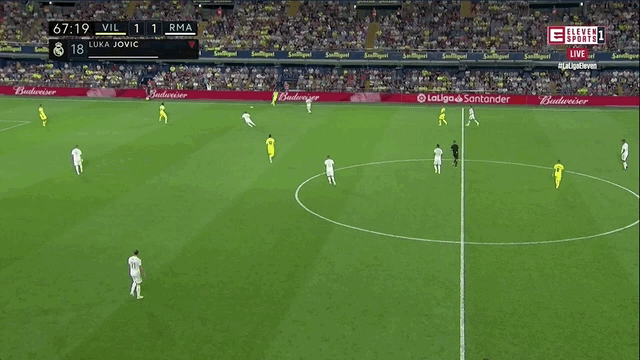 The defensive improvement can also be traced to the centre of the backline. Last season, Álvaro González, Ramiro Funes Mori and Víctor Ruíz ate up the bulk of minutes there. As I said prior to the start of the season, the arrival of the experienced Raúl Albiol immediately raised the competency level, and he has formed a solid partnership with Torres, back from a good loan spell at Málaga and looking very much at home in the top flight. Assured in his defensive work, he also provides the natural balance of a left-footed player on that side of the defence. A native of the town of Villarreal (the fourth to play for the club), on Wednesday he signed a new deal through to 2024. That is not to say that everything is now perfect. Far from it. Villarreal’s defending of set-piece situations continues to be a concern. They’ve already conceded three goals and an above-league-average xG from them. They’ve also clumsily given away three penalties, which is somewhat representative of the occasional sloppiness that seeps into their defending. But if they can pair functional defensive numbers with a highly potent attack, there is no reason they can’t compete for top six or seven finish. With no European football to stretch the squad and removed from the week-to-week worry of a relegation battle, Calleja appears to have found a propitious way forward by focusing on his team’s attacking quality and utilising summer arrivals to sufficiently balance the rest of the side. With a fairly accessible set of fixtures to come until they face Valencia, Atlético Madrid and Sevilla in consecutive matches in December, Villarreal have a good opportunity to establish themselves as a genuine European contender over the next couple of months.
The defensive improvement can also be traced to the centre of the backline. Last season, Álvaro González, Ramiro Funes Mori and Víctor Ruíz ate up the bulk of minutes there. As I said prior to the start of the season, the arrival of the experienced Raúl Albiol immediately raised the competency level, and he has formed a solid partnership with Torres, back from a good loan spell at Málaga and looking very much at home in the top flight. Assured in his defensive work, he also provides the natural balance of a left-footed player on that side of the defence. A native of the town of Villarreal (the fourth to play for the club), on Wednesday he signed a new deal through to 2024. That is not to say that everything is now perfect. Far from it. Villarreal’s defending of set-piece situations continues to be a concern. They’ve already conceded three goals and an above-league-average xG from them. They’ve also clumsily given away three penalties, which is somewhat representative of the occasional sloppiness that seeps into their defending. But if they can pair functional defensive numbers with a highly potent attack, there is no reason they can’t compete for top six or seven finish. With no European football to stretch the squad and removed from the week-to-week worry of a relegation battle, Calleja appears to have found a propitious way forward by focusing on his team’s attacking quality and utilising summer arrivals to sufficiently balance the rest of the side. With a fairly accessible set of fixtures to come until they face Valencia, Atlético Madrid and Sevilla in consecutive matches in December, Villarreal have a good opportunity to establish themselves as a genuine European contender over the next couple of months.
Stats of Interest
Fran Escribá seems to be hanging by a thread at Celta Vigo after somehow producing the league’s lowest shot count and its second worst xG with a squad brimming with creative attacking talent. Quique Setién potentially awaits. 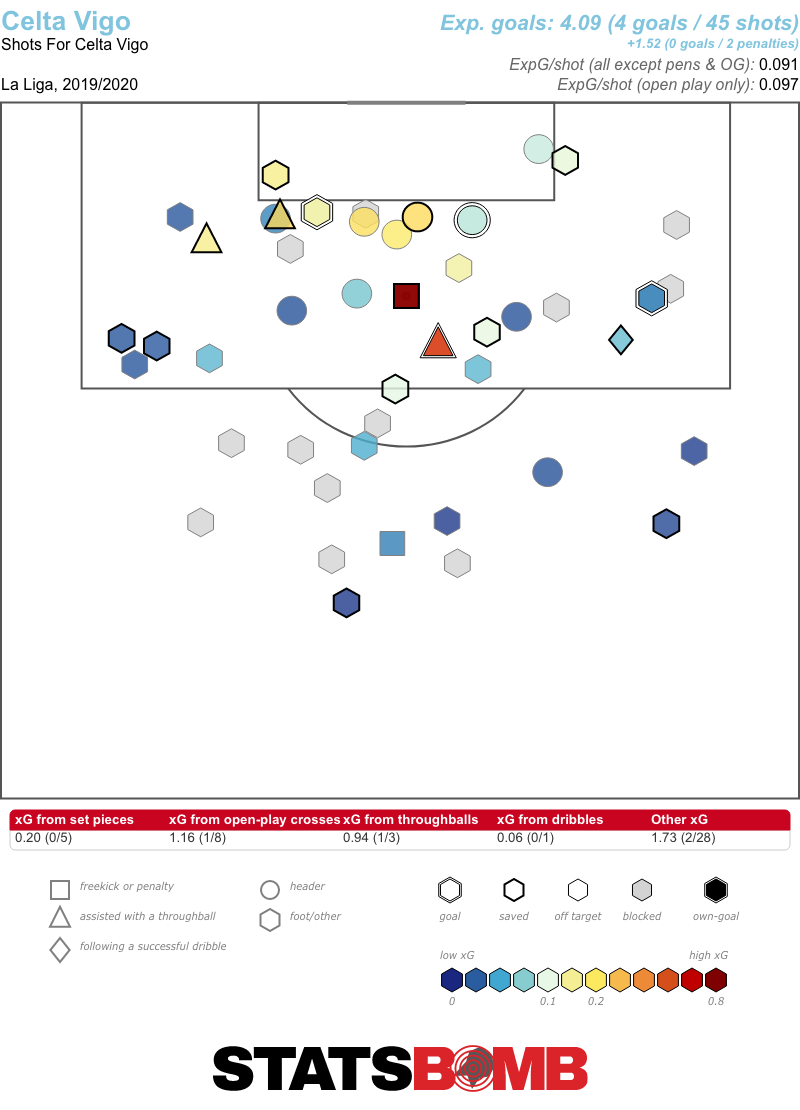 After conceding six times in their first four matches in La Liga, Real Madrid tightened up considerably over the next three, including last weekend’s 0-0 draw away at local rivals Atlético. Three clean sheets were matched to just 0.35 xG conceded per match.
After conceding six times in their first four matches in La Liga, Real Madrid tightened up considerably over the next three, including last weekend’s 0-0 draw away at local rivals Atlético. Three clean sheets were matched to just 0.35 xG conceded per match. 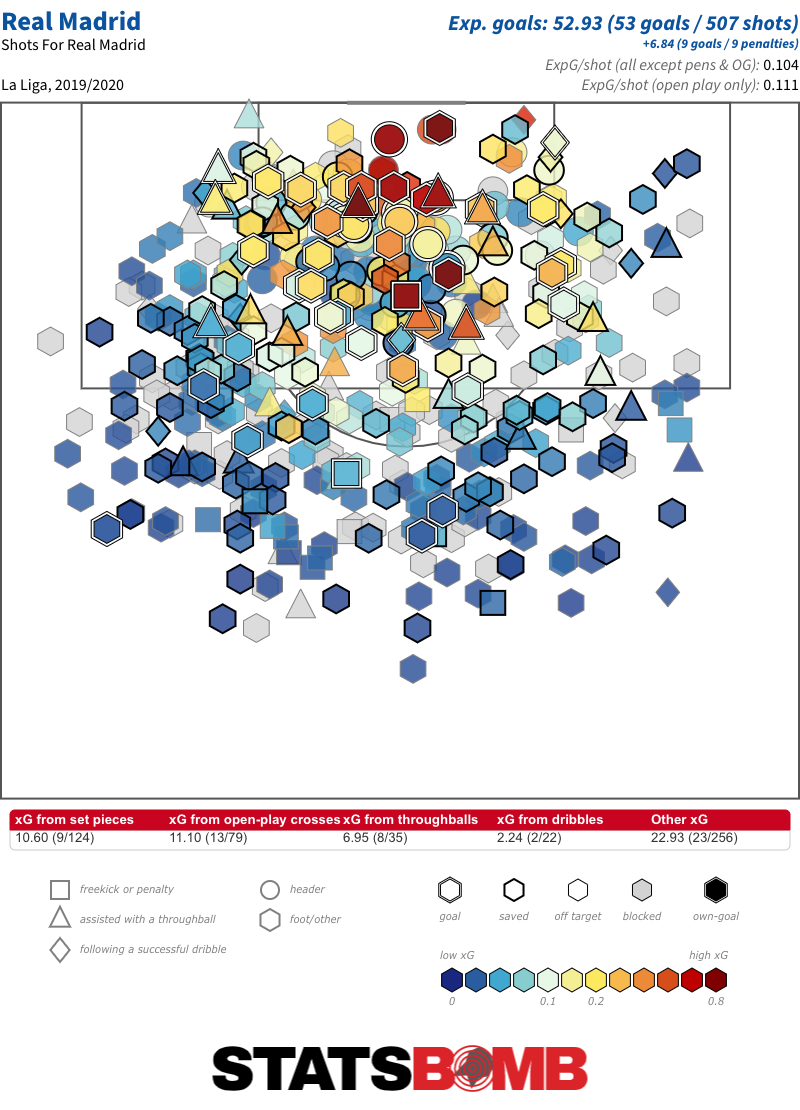 But then they went and gave up all of this in their 2-2 draw at home to Club Brugge in the Champions League on Tuesday. It seems all is not yet well.
But then they went and gave up all of this in their 2-2 draw at home to Club Brugge in the Champions League on Tuesday. It seems all is not yet well. 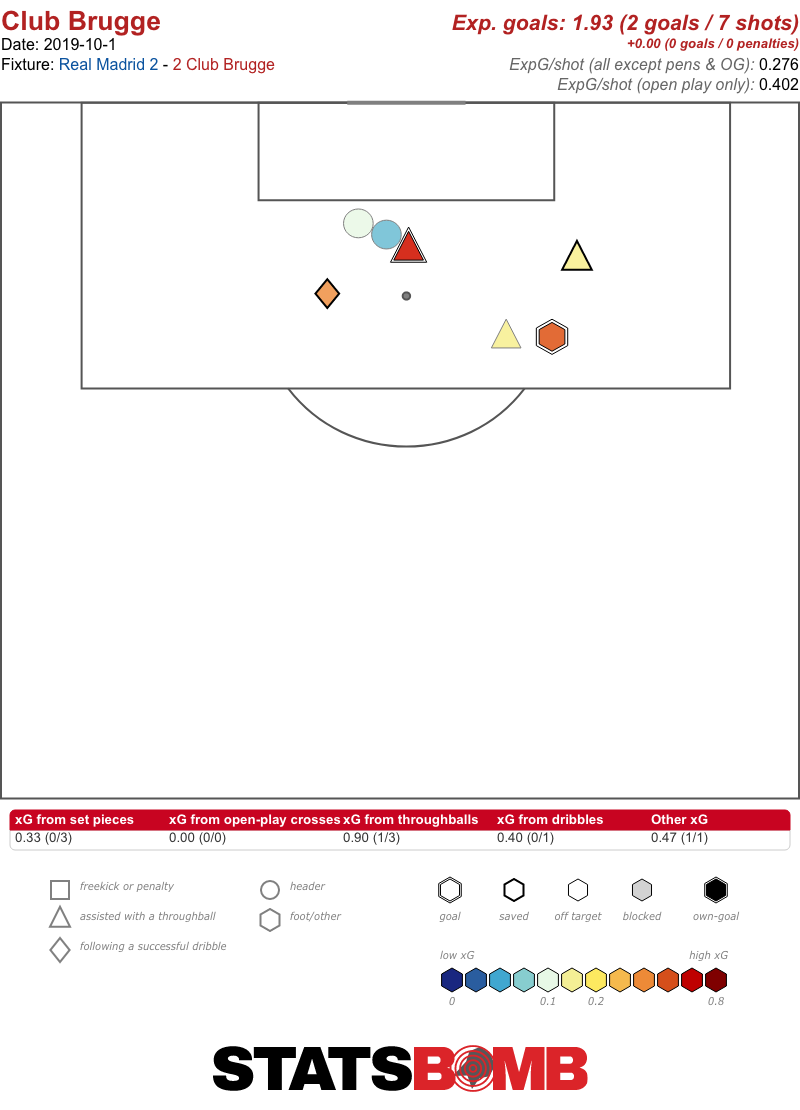
Eberechi is making the Championship look Eze
Eberechi Eze of Queen’s Park Rangers first came to our attention during his breakout loan spell at Wycombe Wanderers in 2017-18. He continued to show promise after breaking through into the QPR first team in 2018-19, and has now made a start to this season that’s impossible to ignore. A player that was previously simmering may now be reaching boiling point.
The summer appointment of Mark Warburton as manager has turned QPR from unremarkable Championship no-hopers to a side full of attacking intention and in Eze they have a player ready-made to thrive on such freedom of expression. Equally comfortable playing as a #10 or out wide, the 21 year old has also impressed in a deeper role, featuring on several occasions as an #8 in a 3-1-4-2.
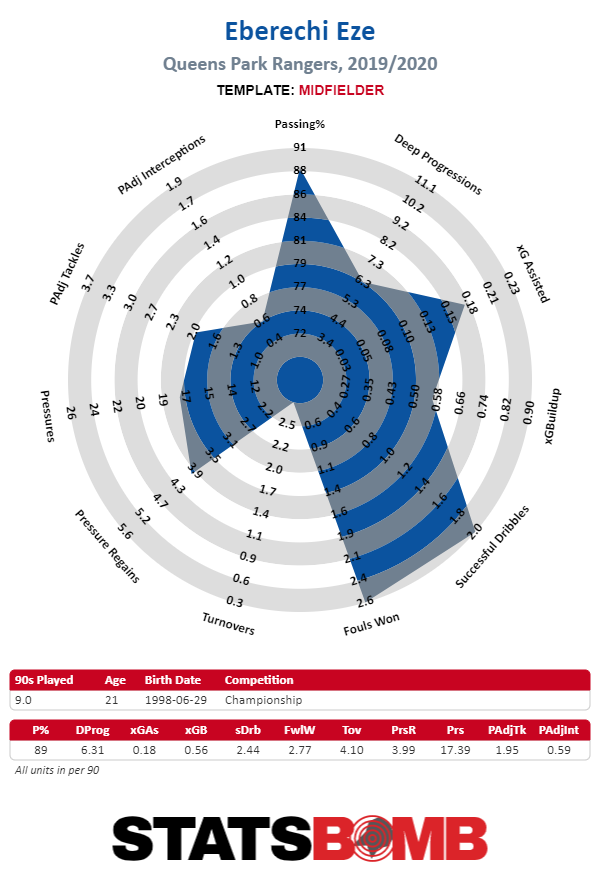
Clearly enjoying the deeper starting role, Eze’s gotten on the ball in the earlier stages of QPR’s possession and by utilising his close control, quick feet and athletic ability to drive through the midfield, completing no fewer than 85% of his ball carries that end within the opposition half, he’s been a real force at turning defence into attack.
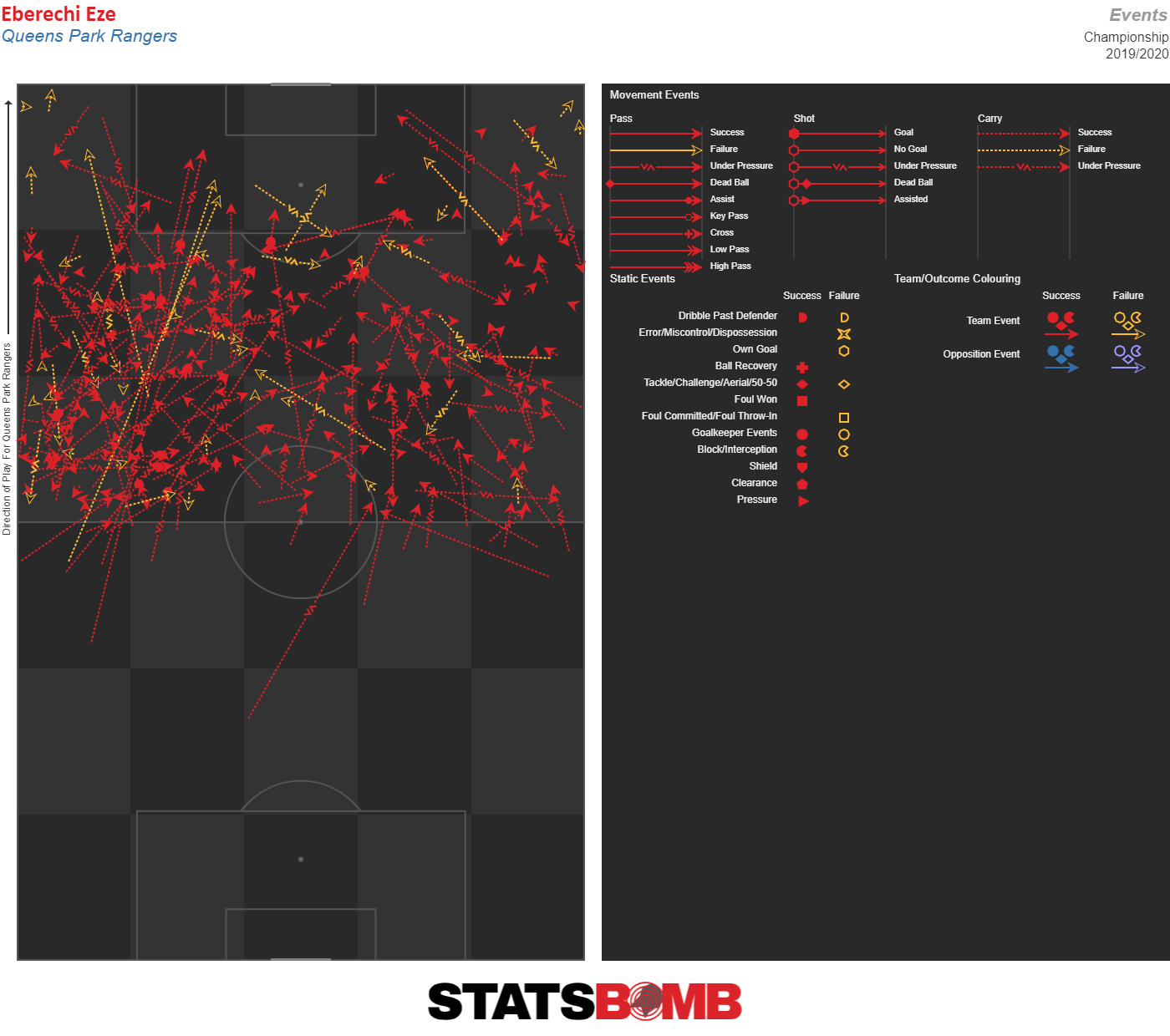
The advanced positions he regularly ends up in means it’s appropriate to look at his contribution against the boundaries for more advanced midfielders and wide players as well. Eze’s ability to make an impact in the final third has been key to QPR’s strong start and his Scoring Contribution rate of 0.55 (goals + assists per 90 minutes) ranks him second for all players in the Championship under the age of 22, with his expected rates (xG + xG assisted) not far behind either at 0.33.
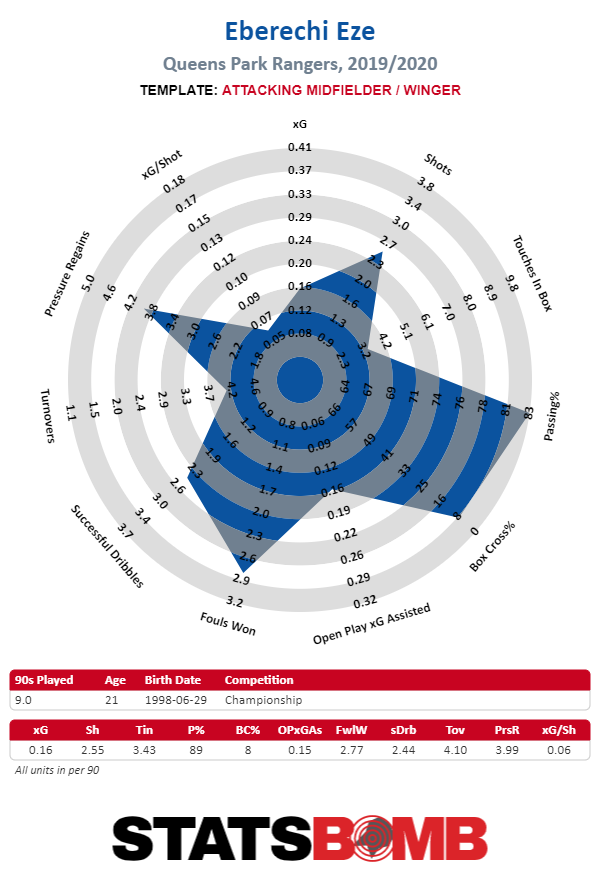
Far from just a capable carrier, he also has the passing mastery to match. A really smart user of the ball in and around the final third, Eze has the capability to see an opportunity to play a killer pass but also the technical accomplishment to execute them as well, completing 87% of his passes into and within the attacking third.
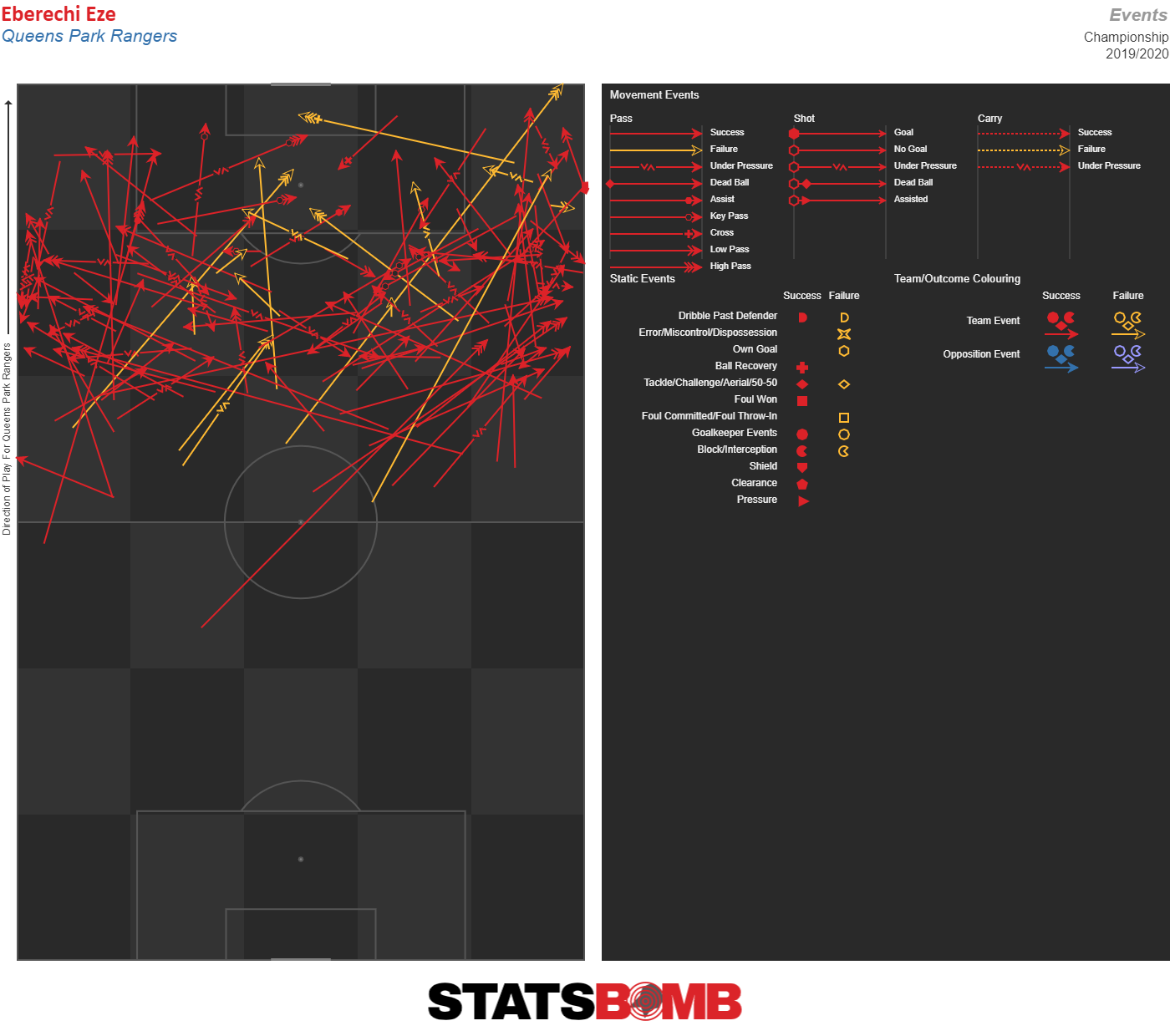
As expected, the rumour mill has begun to turn with Southampton and Spurs the Premier League sides most recently linked, a step up that will become an expectation rather than a possibility should Eze maintain his fine start.
StatsBomb Podcast: October 2019 #1. Spurs v Bayern fallout, Chelsea, West Ham, Bundesliga & more
Statistically unusual players in the early games of the Premier League season
There are a lot of players in the Premier League. Generally speaking, to reach the top flight of English football, most of them are quite good. We're quite used to generalised qualities at this point. Fullbacks who can overlap, inverted wingers who can cut inside and shoot, defensive midfielders who can win the ball back aggressively. But there are some players who just do things differently to everyone else. This might not necessarily be a positive or negative thing, but here are six individuals who have statistically stood out as unusual so far this season.
John McGinn
Of all the players to feature in central midfield this season, only three, Ross Barkley, Tanguy Ndombele and Kevin De Bruyne (interpreting “central midfield” loosely here), have made more successful dribbles per 90 than John McGinn. Only McGinn’s Villa teammate Jack Grealish has won more fouls per 90 than the Scotland international. So we know what it is that he does. But on the other side, no central midfielder is making fewer passes per 90 than McGinn. This is someone who seems to choose to dribble and thus draw fouls over passing the ball at every possible opportunity. 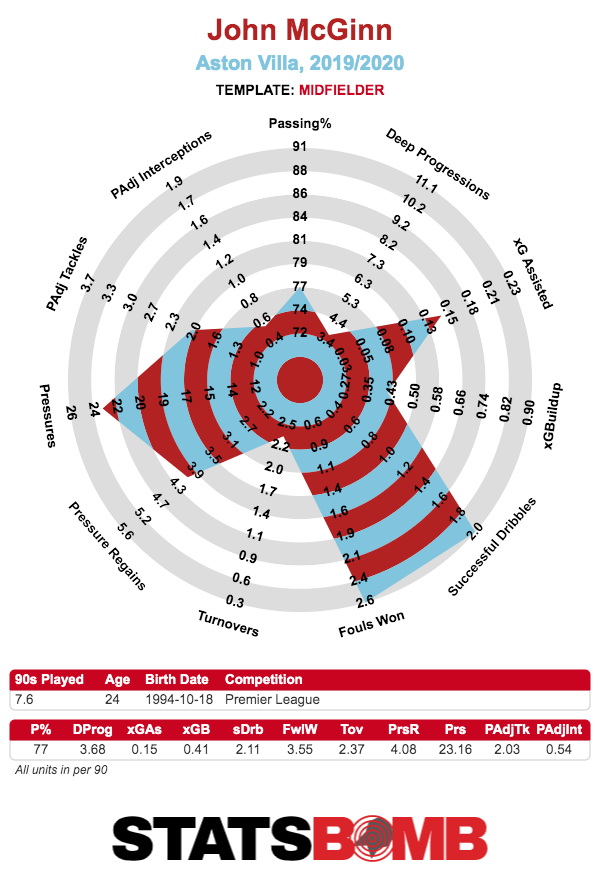 When McGinn does pass the ball, he isn’t shy about pinging it, with the seventh longest average pass length of any central midfielder. It’s clear in his sonar just how direct he’s willing to go.
When McGinn does pass the ball, he isn’t shy about pinging it, with the seventh longest average pass length of any central midfielder. It’s clear in his sonar just how direct he’s willing to go. 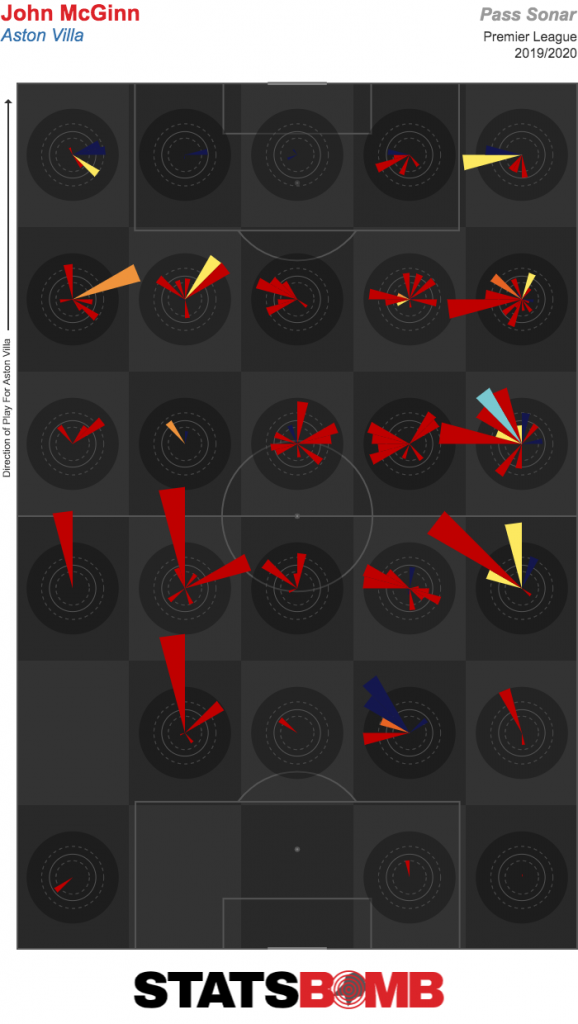 Or alternatively, he’ll carry it, with the third longest carry length in the position. He’ll do anything except the obvious option of keeping it simple and making a pass. This might be because he’s playing with Grealish, natural playmaker extraordinaire. It could simply be that it’s just his natural game. His application and desire to run is the kind of thing that catches the eye of fans, especially in the UK, and it’s hard to argue he’s not a useful player for Villa. He does have this very obvious, somewhat bizarre limit, and Dean Smith needs to construct his side accordingly for it. Unfortunately for McGinn, one would imagine these limitations make the bottom half of the Premier League his ceiling, with a better side that dominates possession unlikely to want to have to tweak the midfield balance to fit him in. For now, though, Villa fans should enjoy the things he does and worry not about his lack of passing.
Or alternatively, he’ll carry it, with the third longest carry length in the position. He’ll do anything except the obvious option of keeping it simple and making a pass. This might be because he’s playing with Grealish, natural playmaker extraordinaire. It could simply be that it’s just his natural game. His application and desire to run is the kind of thing that catches the eye of fans, especially in the UK, and it’s hard to argue he’s not a useful player for Villa. He does have this very obvious, somewhat bizarre limit, and Dean Smith needs to construct his side accordingly for it. Unfortunately for McGinn, one would imagine these limitations make the bottom half of the Premier League his ceiling, with a better side that dominates possession unlikely to want to have to tweak the midfield balance to fit him in. For now, though, Villa fans should enjoy the things he does and worry not about his lack of passing.
Ryan Fredericks
Mohamed Salah has attempted 18 passes inside the box so far this season. That’s the most of any player in the division. Wilfried Zaha and Jamie Vardy are next up with 17 and 13 each. If I told you the next player was a fullback, you might think of Liverpool’s pair of Andy Robertson and Trent Alexander-Arnold, or possibly someone like Oleksandr Zinchenko. You probably wouldn’t expect it to be someone who featured so irregularly for West Ham last season. 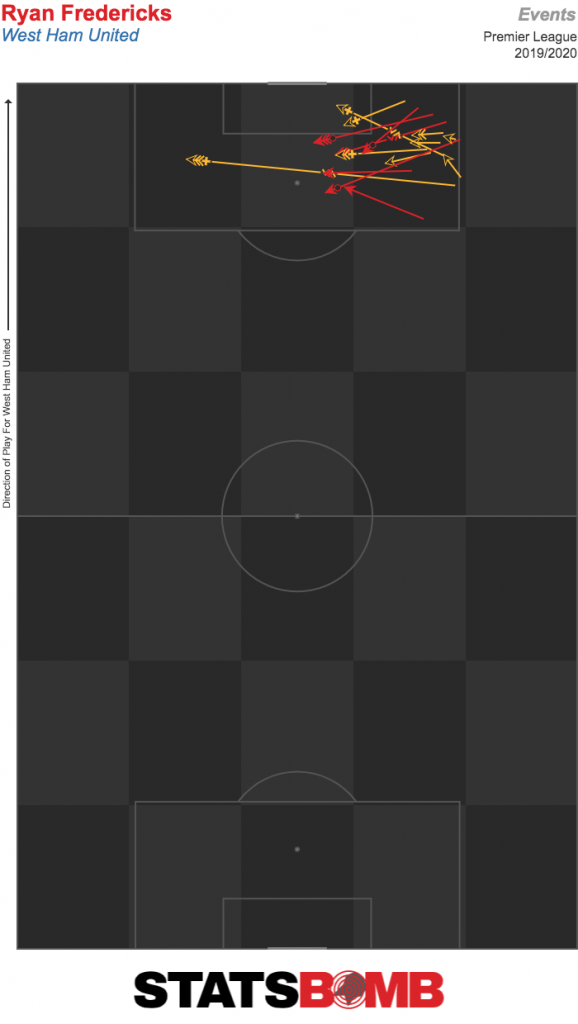 Ryan Fredericks looks a fairly average right back by most other measures. He’s not a hugely active defender, and he’s not progressing the ball up the pitch that well until it gets into the box. The player this is somewhat reminiscent of is Sead Kolasinac. Last season, Kolasinac consistently put up incredible creative numbers by getting forward and delivering cut backs to Arsenal’s talented attack. Fredericks isn’t creating at such a rate yet, but the potential seems to be there. Of course, the other side of Kolasinac was his inability to cover such ground that he could provide a threat in the final third without leaving his side horribly exposed. That Arsenal felt the need to buy Kieran Tierney shows just how little Kolasinac’s unusual skills were seen as helpful in the end. Fredericks may have the advantage here of being a much better athlete. He has the speed to cover much more ground than Kolasinac, to get into the box and still potentially recover defensively if the Hammers get caught out. We’re dealing with a small sample size here, and this is something that could easily drift away as the season goes on, especially if Manuel Pellegrini wants to tighten things up at the back. But Fredericks might have the toolkit to be a very interesting, very adventurous right back who can be an important cog in West Ham’s attack.
Ryan Fredericks looks a fairly average right back by most other measures. He’s not a hugely active defender, and he’s not progressing the ball up the pitch that well until it gets into the box. The player this is somewhat reminiscent of is Sead Kolasinac. Last season, Kolasinac consistently put up incredible creative numbers by getting forward and delivering cut backs to Arsenal’s talented attack. Fredericks isn’t creating at such a rate yet, but the potential seems to be there. Of course, the other side of Kolasinac was his inability to cover such ground that he could provide a threat in the final third without leaving his side horribly exposed. That Arsenal felt the need to buy Kieran Tierney shows just how little Kolasinac’s unusual skills were seen as helpful in the end. Fredericks may have the advantage here of being a much better athlete. He has the speed to cover much more ground than Kolasinac, to get into the box and still potentially recover defensively if the Hammers get caught out. We’re dealing with a small sample size here, and this is something that could easily drift away as the season goes on, especially if Manuel Pellegrini wants to tighten things up at the back. But Fredericks might have the toolkit to be a very interesting, very adventurous right back who can be an important cog in West Ham’s attack.
Dan Burn
When Graham Potter arrived at Brighton, the expectation was that he would change the style of football. The attacking emphasis would be greater, he’d move to a system with three at the back, and defenders previously accustomed to hoofing it would be asked to play more football. The assumption was that new signing Adam Webster, a centre back extremely comfortable taking risks, would be the poster boy for this shift. It was not expected that Potter would make Dan Burn the key player in his new defensive system. 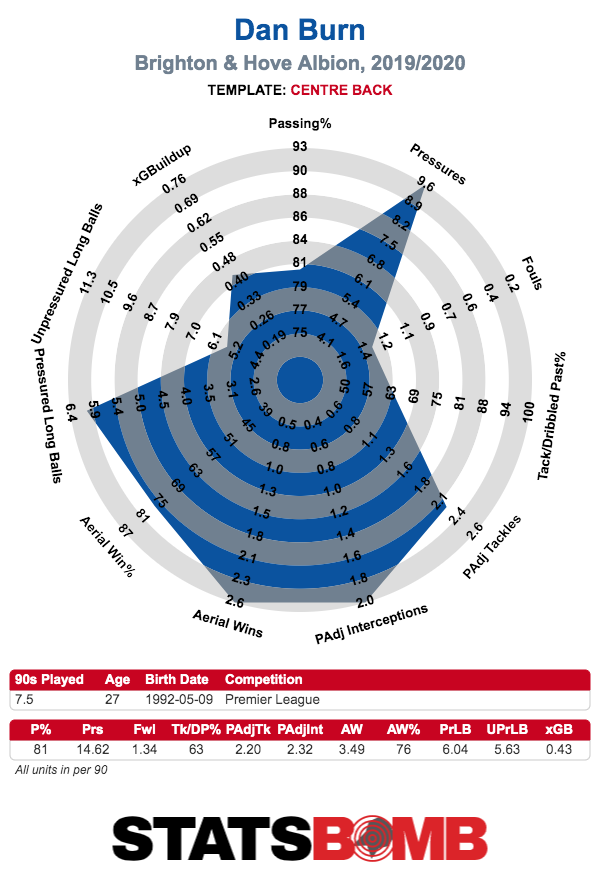 If you’re moving to a back three, having a left footed defender like Burn is always a bonus, especially when he even played occasional left back minutes at Wigan. What we’re seeing so far from Burn is someone extremely comfortable moving forward. While we’re dealing with small sample sizes here, no other centre back in the league gets close to his 0.8 open play passes into the box per 90. Similarly, he leads the division’s centre backs in open play passes in the final third per 90. And it doesn’t stop with his passing range, also posting the most frequent attempted dribbles, though with fully half of them not coming off, he should probably slow down on that front. The wide centre back roles in a back three can often be slightly strange hybrid positions, neither centre back nor full back. Perhaps unexpectedly, Burn is interpreting the role in a particularly expansive manner.
If you’re moving to a back three, having a left footed defender like Burn is always a bonus, especially when he even played occasional left back minutes at Wigan. What we’re seeing so far from Burn is someone extremely comfortable moving forward. While we’re dealing with small sample sizes here, no other centre back in the league gets close to his 0.8 open play passes into the box per 90. Similarly, he leads the division’s centre backs in open play passes in the final third per 90. And it doesn’t stop with his passing range, also posting the most frequent attempted dribbles, though with fully half of them not coming off, he should probably slow down on that front. The wide centre back roles in a back three can often be slightly strange hybrid positions, neither centre back nor full back. Perhaps unexpectedly, Burn is interpreting the role in a particularly expansive manner.
Moritz Leitner
So you’re a promoted side that decides to stick with your progressive brand of football in the Premier League. You’ve also decided to keep the budget down and avoid splashing out on expensive signings. What you need is one of your central midfielders to really step up and progress the ball at an even better rate than last season, while at the same time working harder defensively than before. 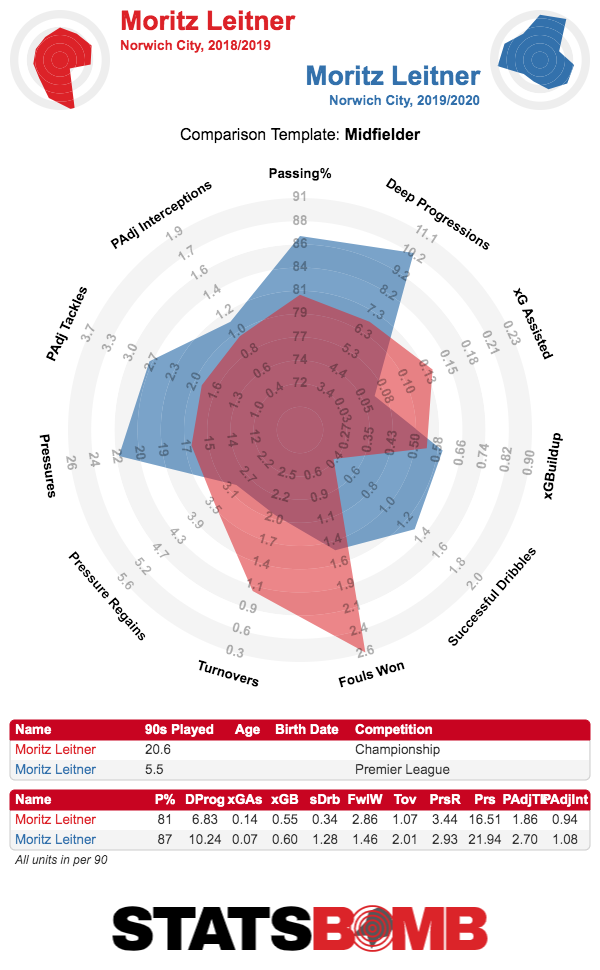 After failing to make the grade at Borussia Dortmund before bouncing around Stuttgart, Lazio and Augsburg, Moritz Leitner has become the hard working creative central midfielder that makes Norwich tick. In the entire league, only Harry Winks is putting up more deep progressions per 90 than the German. Aymeric Laporte and Robertson are the only players with more carries per 90 than Leitner. And even after the ball is worked into the final third, he’s still among the top 20 players for passes within that zone. For a team with only 50% possession. Norwich are more an interesting team this season than they are good, with the side needing to hope their fourth worst expected goal difference in the league will be enough to see them right. When they work the ball into dangerous areas, though, they’re a delight to watch, and Leitner is absolutely a key player in making those situations happen.
After failing to make the grade at Borussia Dortmund before bouncing around Stuttgart, Lazio and Augsburg, Moritz Leitner has become the hard working creative central midfielder that makes Norwich tick. In the entire league, only Harry Winks is putting up more deep progressions per 90 than the German. Aymeric Laporte and Robertson are the only players with more carries per 90 than Leitner. And even after the ball is worked into the final third, he’s still among the top 20 players for passes within that zone. For a team with only 50% possession. Norwich are more an interesting team this season than they are good, with the side needing to hope their fourth worst expected goal difference in the league will be enough to see them right. When they work the ball into dangerous areas, though, they’re a delight to watch, and Leitner is absolutely a key player in making those situations happen.
Dominic Solanke
Let’s not beat around the bush here: Dominic Solanke has been bad at scoring goals. And this isn’t even a situation similar to his time at Liverpool where he just wasn’t finishing good chances. His 0.19 xG per 90 is nothing other than poor, especially compared to what his teammate Callum Wilson is doing. But that’s not the end of the story for Solanke. Only two players in the Premier League are managing more pressures per 90 than the Bournemouth man. What’s more, no striker (if we discount Wilfried Zaha and Gerard Deulofeu on the grounds that they are not really strikers) is making more deep progressions per 90 than Solanke. He’s working hard for the team by closing down opponents, then receiving the ball in deep areas to progress it forward. While playing as a striker. 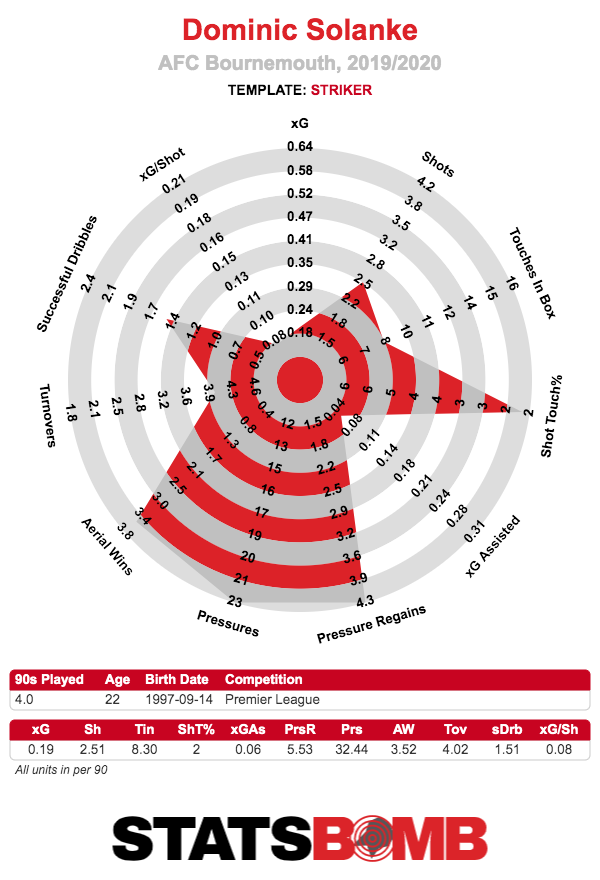 Does it matter that he’s not scoring more? In terms of public perception it seems to. Solanke will be “shit until he scores loads” in the court of public opinion. But in terms of Bournemouth’s system, it’s not obvious that this is a problem. Playing in a front two with Wilson, the more important role is to ensure that the strikers do not become isolated or the midfield gets exposed. Solanke is ideal for this, and should be able to do the role at a higher level than Joshua King.
Does it matter that he’s not scoring more? In terms of public perception it seems to. Solanke will be “shit until he scores loads” in the court of public opinion. But in terms of Bournemouth’s system, it’s not obvious that this is a problem. Playing in a front two with Wilson, the more important role is to ensure that the strikers do not become isolated or the midfield gets exposed. Solanke is ideal for this, and should be able to do the role at a higher level than Joshua King.
Sebastien Haller
Ok, but what if someone was doing a lot of the things Solanke offers, while also scoring goals? Meet Sebastien Haller. 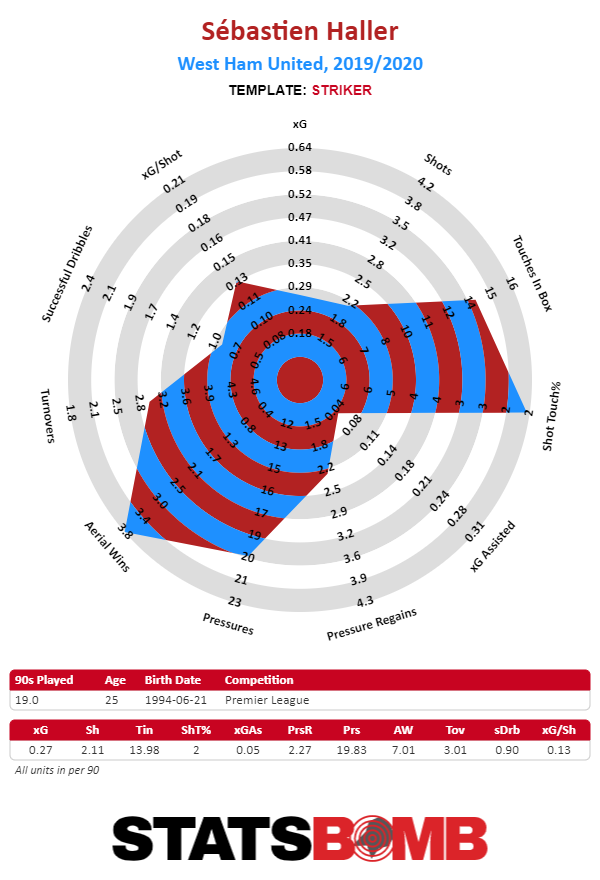 No striker (again, discounting Deulofeu because he isn’t one) is making more open play passes per 90 than Haller. Only Solanke is putting up more deep progressions. He’s exerting a very respectable 20.11 pressures per 90. His shot volume is on the low side, but when he gets them, boy does he get some good ones.
No striker (again, discounting Deulofeu because he isn’t one) is making more open play passes per 90 than Haller. Only Solanke is putting up more deep progressions. He’s exerting a very respectable 20.11 pressures per 90. His shot volume is on the low side, but when he gets them, boy does he get some good ones. 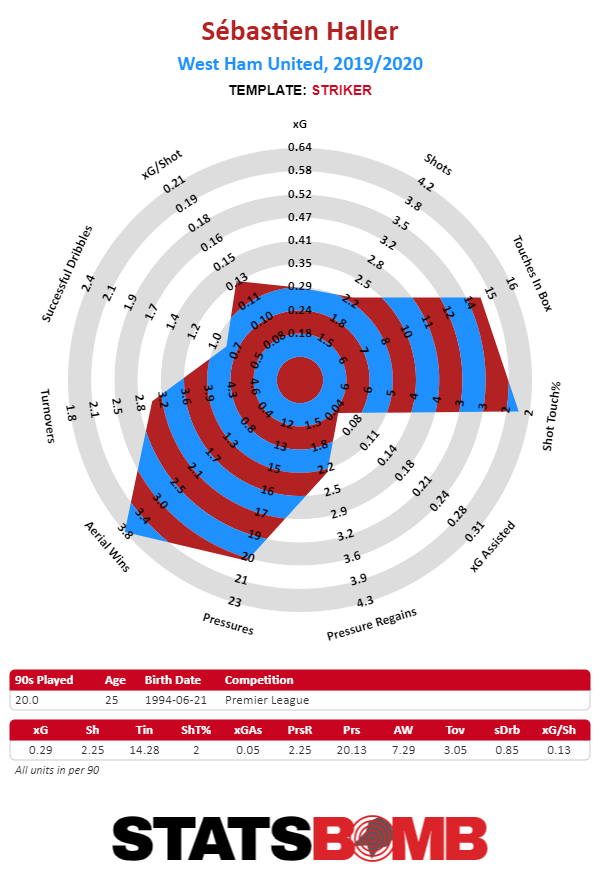 Haller combines the all round play of a striker who typically wouldn’t score a lot of goals with the shot profile of a pure poacher. It’s a fascinating package of skills and West Ham can consider themselves to have a real gem here.
Haller combines the all round play of a striker who typically wouldn’t score a lot of goals with the shot profile of a pure poacher. It’s a fascinating package of skills and West Ham can consider themselves to have a real gem here.
Can any of these Champions League underdogs shock the big boys?
As we role into Champions League match day two, the biggest teams from across Europe will inevitably get the attention. But, as the group stage progresses, a number of smaller teams will look to stake their claim to be this year’s Cinderella story. Here’s a quick look at some of the less heralded teams in this year’s Champions League and what they do, or don’t do well.
Slavia Praha
Things could not have gone better on match day one for the team from Prague. Not only did they travel to Italy and come back with a point from Inter Milan but Barcelona and Borussia Dortmund also drew, leaving the group wide open. Getting stuck in such a difficult group meant that their odds of even making the Europa League were always going to be long, but every Cinderella Story starts with a single invitation to the ball.
If their match against Inter taught us anything, it’s that this team plans to remain true to itself, no matter how challenging that may be. Manager Jindřich Trpišovský has his team press the opposition early, often, and unrelentingly. Through nine games of their domestic season, this is what their defensive heat map looks like.
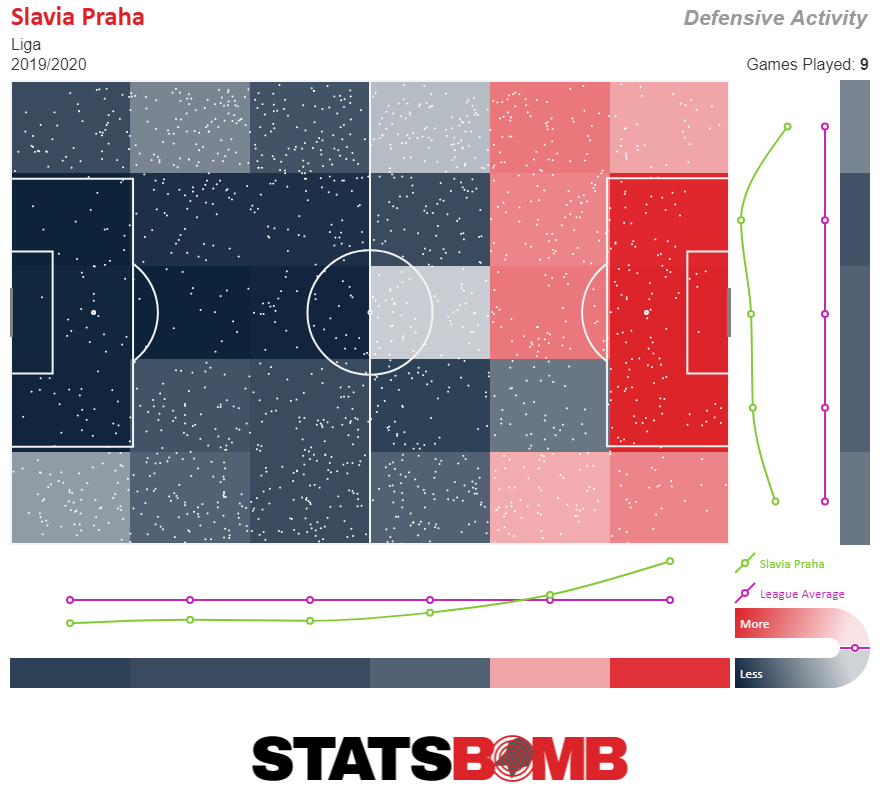
In attack, their approach is generally to shoot early, shoot often, and then use the defense to get the ball and do it again. With such an active defense, shot quality comes second to simply burying opponents under an unending deluge of attempts on goal, even if many of those individual attempts are somewhere between speculative and downright deluded.
Of course, executing that approach when you have the most talent in your domestic league is a lot easier than it is when you go up against some of the biggest teams in Europe, but as we can see from their first match against Inter, they're sure going to try.
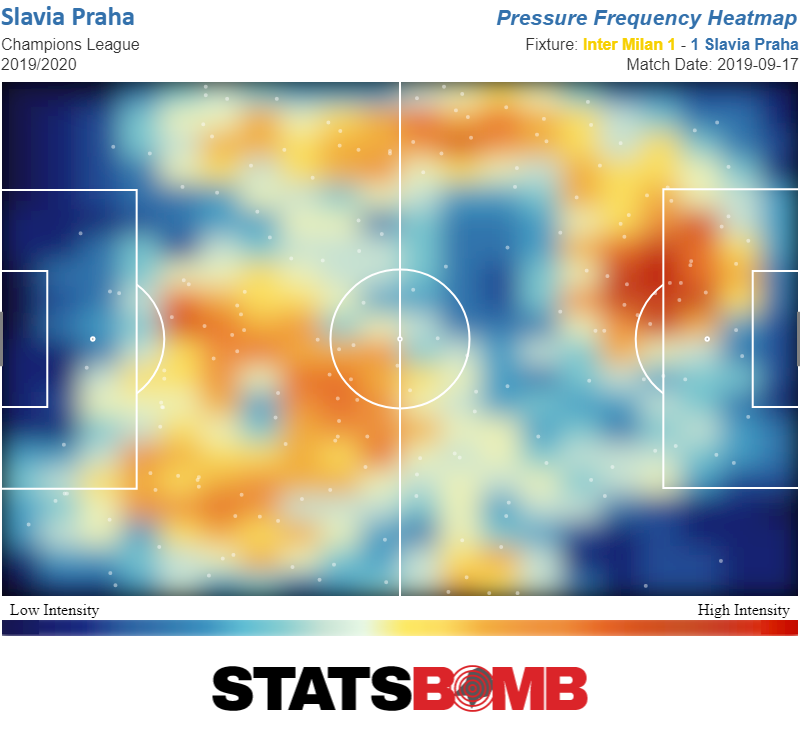
Advancing from this group remains an extremely unlikely proposition, but if it were to ever happen, this would be the way. First the draw against Inter, and now they get to host Borussia Dortmund at a time when the team seems to be ever so slightly off the top of their game. The German side is coming off back to back disappointing 2-2 draws against Eintracht Frankfurt and Werder Bremen dropping them to eight in the Bundesliga. Slavia Praha probably won’t shock the world, but if they are going to, it helps to catch their group stage opponents at their lowest moments.
Crvena Zvezda
It seems silly to suggest that a team that has started their season with eight wins and a loss is struggling, but sometimes it fits the bill. Sure Red Star sit tied for points at the top of the table and even have a game in hand on Bačka Topola the unlikely co-owners of the league’s best record, and yes the side sits one point ahead of bitter crosstown rival Partizan, but the stats suggest, that at least early in the season all was not quite right with this perennial powerhouse.
It’s hard for Europe’s smaller teams to compete on the biggest stage if they aren’t absolutely dominant at home, and Red Star simply haven’t been. On both sides of the ball it’s been Partizan that is the stand out performer (the following stats don’t include the last two match days, which is important to note were both comfortable 3-1 wins for Red Star). On both sides of the ball Partizan have the stronger xG numbers and thus a significantly higher xG differential so far this season.
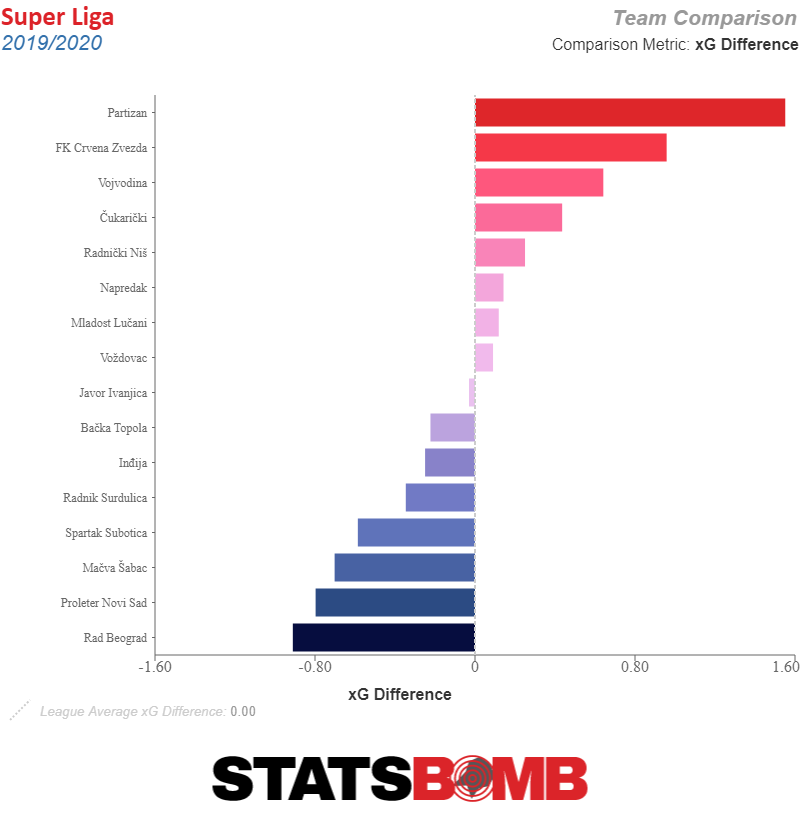
This difference clearly showed itself when the two sides squared off earlier this season. It’s one of the most hotly contested rivalries in the world, and while Partizan left it until late to score their two goals, they were clearly the better team over the course of 90 minutes.
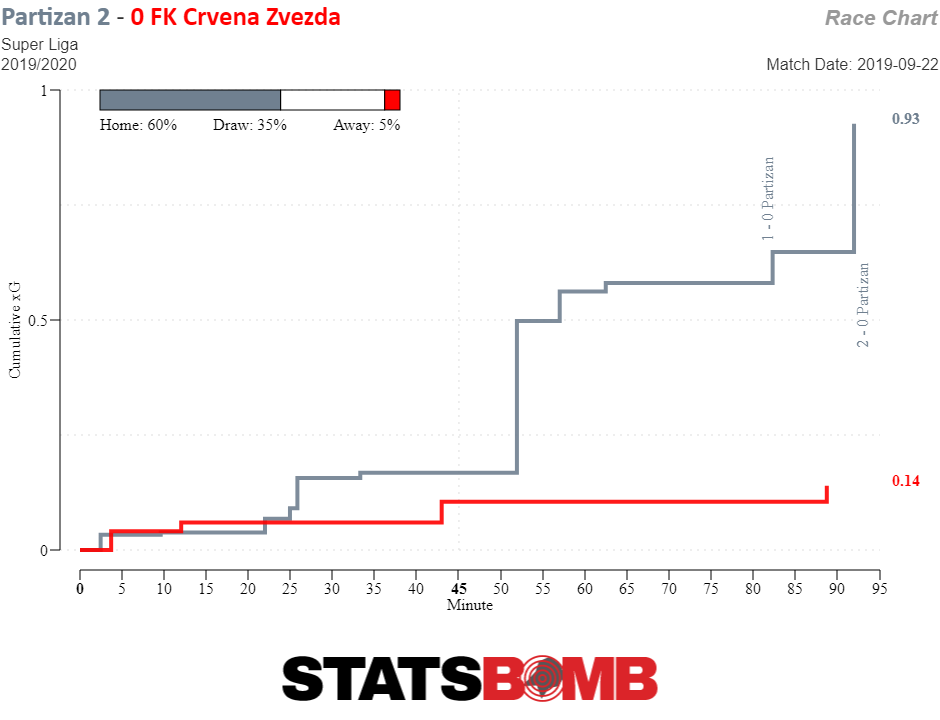
Even though their domestic form suggests Red Star might not have enough fire power to threaten any of the favorites in their group, Tottenham Hotspur’s opening week draw away to Olympiakos has left the door ever so slightly ajar. A good result this week at home against the Greek side combined with a Spurs loss to Bayern would actually vault the Serbian team into second place in the group and at least give them a fighting chance in the weeks to come.
Galatasaray
The Turkish giants have been a mainstay of the Champions League for years. They haven’t exactly threatened to do anything historic in the knockout stages, but they’ve always been a hard out for Europe’s biggest clubs, a side good for an upset or two under the right circumstances. This year, with groupmate Real Madrid getting trounced in the opener getting trounced in the opener by PSG’s backups, it at least seems to open the door for Galatasaray to pull off a shocking upset.
This year’s version of the Turkish side is going to have a real hard time driving through that door. Despite being filled with players you know and are at least mildly fond of, the team simply hasn’t been very good this season. Despite the likes of Jean Michaël Seri, Sofiane Feghouli, Younès Belhanda, Steven Nzonzi and Radamel Falcao leaving viewers in a constant state of “oh yeah I remember that guy” the team hasn’t gelled together at all.
Right now, Galatasaray sit in just seventh place domestically. Despite all those names, they simply struggle to score the ball.
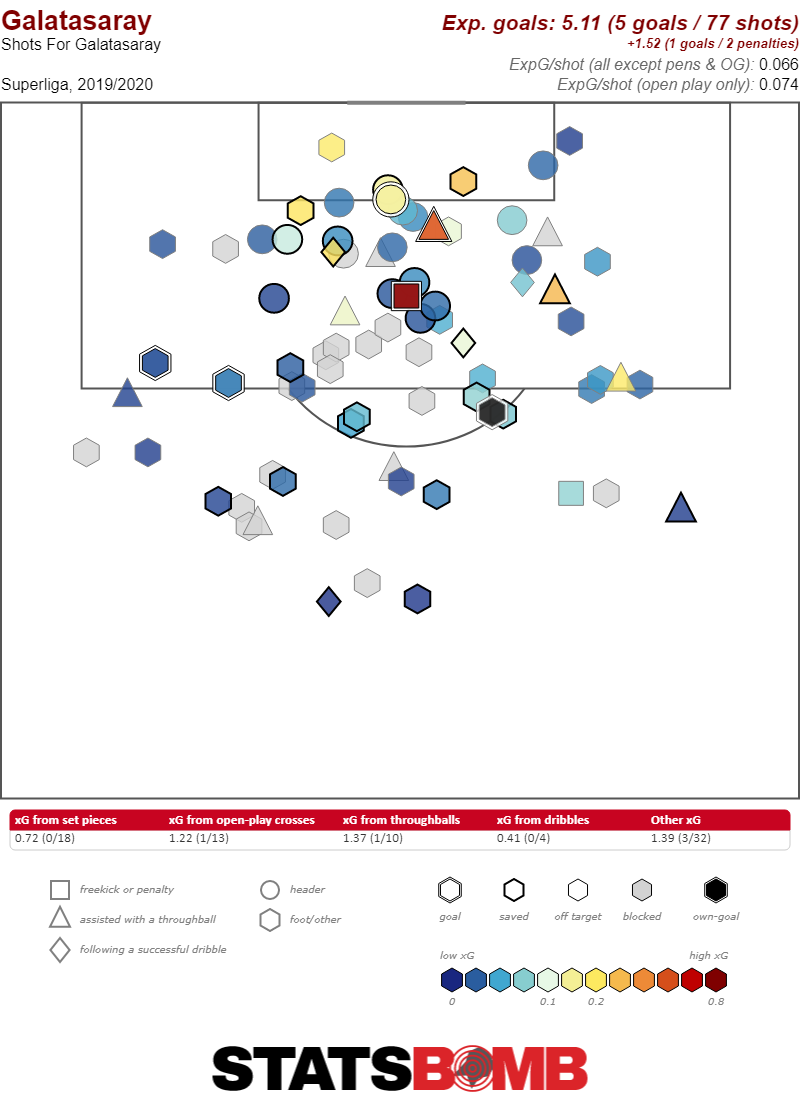
They neither create a lot of shots, 12.87 is the ninth most in the league, nor create particularly good shots, only six teams have a worse average xG per shot than their 0.07.
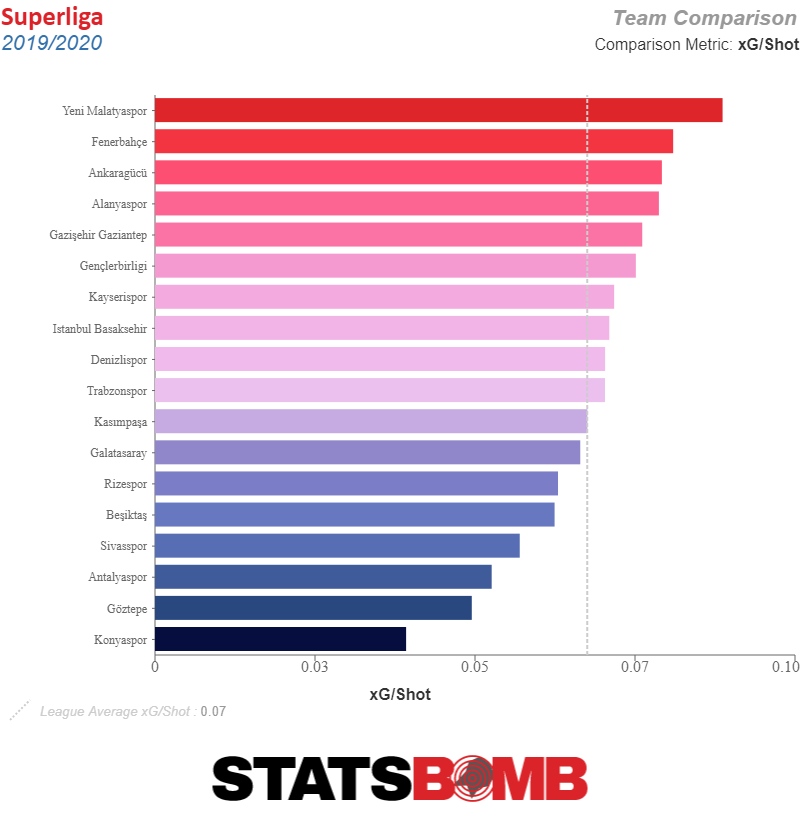
And the sad reality for fans of Turkish football is that if you’re not good enough to dominate at home, you’re probably not good enough to shock the world and outlast Real Madrid or PSG, even in a year when Madrid are struggling. Not all underdogs are created equal, and this year, Galatasaray have simply shown no signs of being able to do the things that they’d need to in order to upend the expected Champions League order.
